“Give me this glorious ocean life, this salt-sea life, this briny, foamy life, when the sea neighs and snorts, and you breathe the very breath that the great whales respire! Let me roll around the globe, let me rock upon the sea; let me race and pant out my life with an eternal breeze astern, and an endless sea before.” ~ Herman Melville
Woke up and immediately started coughing up a lung… stepped out of the bathroom and said in my best ‘phone sex operator’ husky voice: “Well, I feel better, how about you?” It is so annoying that myself and Trish have both picked up some bug that someone has brought on the ship with them – there has been a steady increase in people with an alarming sounding rattling cough, and unsurprisingly in such close quarters, here we are both down with it.
I really don’t want to fly home with this and hope I am better by then… long-haul flights when you’re crook are absolutely shite. But in the meantime, we have two more days of excursions still to go and another planned in Portal Point this morning which is on the continent proper, so we are both determined to ignore the lurgy and get the most out of these few days in Antarctica.
Okay – scratch that. We had *hoped* to land at Portal Point this morning but the weather had other plans. It was a balmy 3C but we had winds of 35 knots, which is not suitable for zodiac cruising at all. Portal Point lies at the entrance to Charlotte Bay on the Reclus Peninsula, on the west coast of Graham Land. The British named it after they built a refuge hut at this site in 1956, enabling them to use a nearby snow slope as a gateway up onto the Peninsula plateau. The hut was only occupied from 1956 to 1958, and research conducted from this field hut focused on surveying the region and studying the local geology. The building was dismantled in 1997 and taken to the Falkland Islands apparently. Portal Point is also quite scenic due to the surrounding mountains, lots of crevassed glaciers and glacial tongues that extend down to sea level so it was quite pretty to sail through it, but looking at the chop and watching the snow coming in sideways made us glad we weren’t planning on going out in it. Can you tell I’m inside today updating this as we go?
So we have made it into Graham Passage which separates Murray Island from the west coast of Graham Land. It was named by a Captain Skidsmo after his whale catcher ship, ‘Graham’ which was the first to pass through it, on March 20, 1922. The passage is lined with enormous ice cliffs, which makes for really spectacular scenery as well as great opportunities for viewing marine mammals or at least it might if I was willing to go out on decks and watch as we sailed past.
I am currently in my centrally heated cabin, in bed, rugged up under a doona and a blanket wearing pyjamas and a thick polar fleece jumper and leaning against an electric heat pack propped up on some pillows. I am coughing up lots of crap (which is hurting my back) and my breathing is somewhat laboured, and I’m contemplating getting dressed to go out into the ‘feels like -5C and the snow is coming in sideways, Outside™’, to go for a zodiac cruise. I’ve never really been accused of being stupid before… but I think after this it is probably a fairly fitting descriptor.
This may not be my finest moment of self-care…
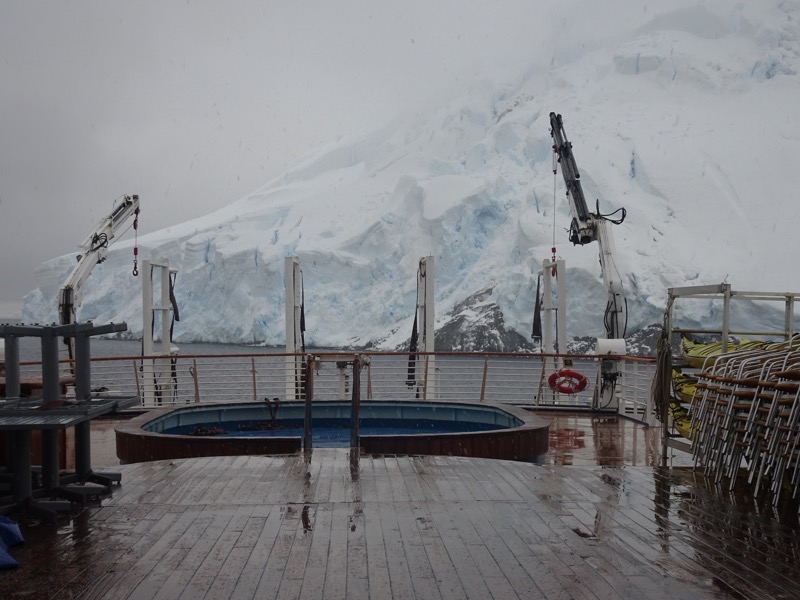
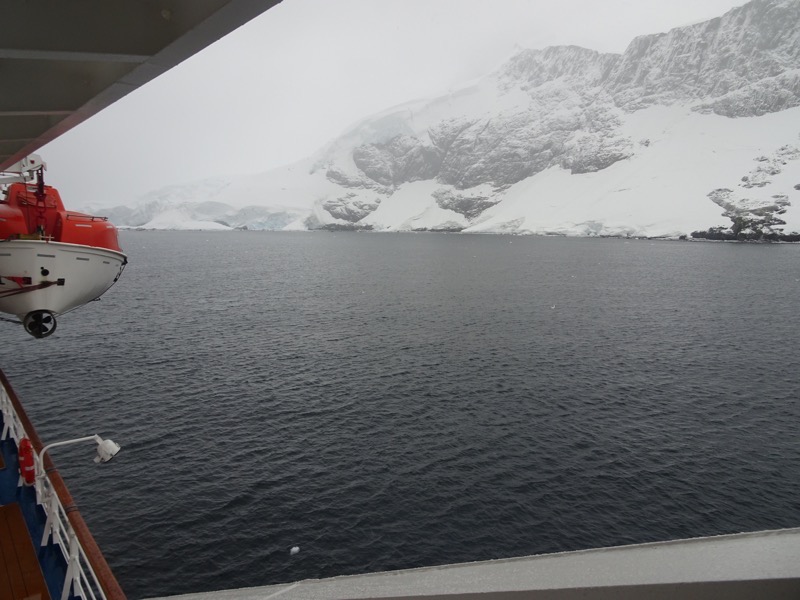
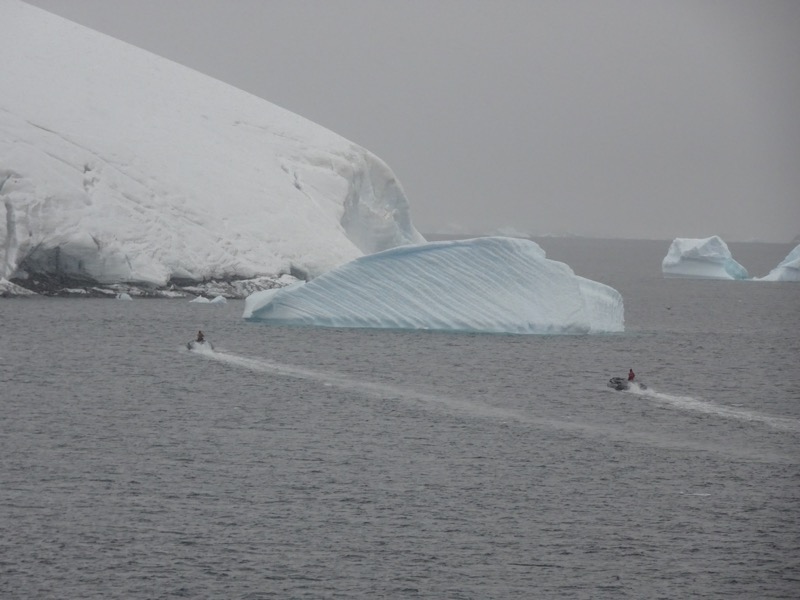
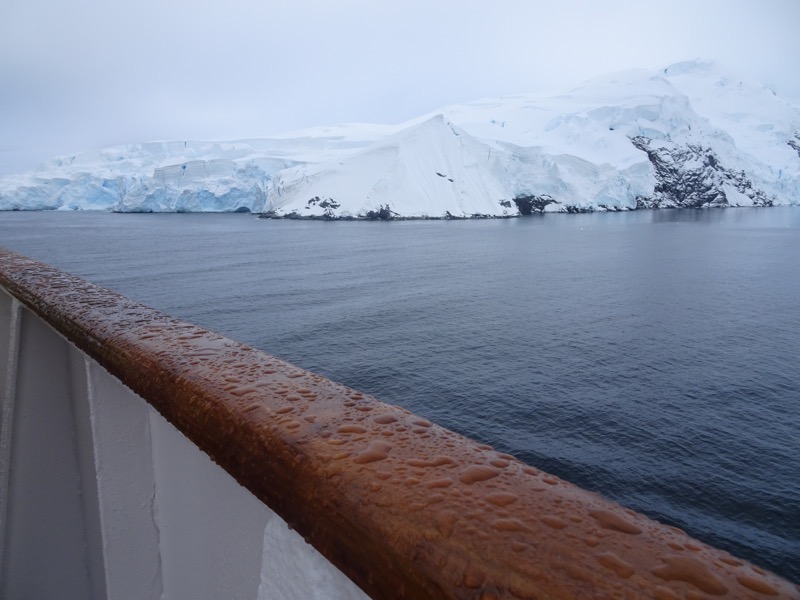

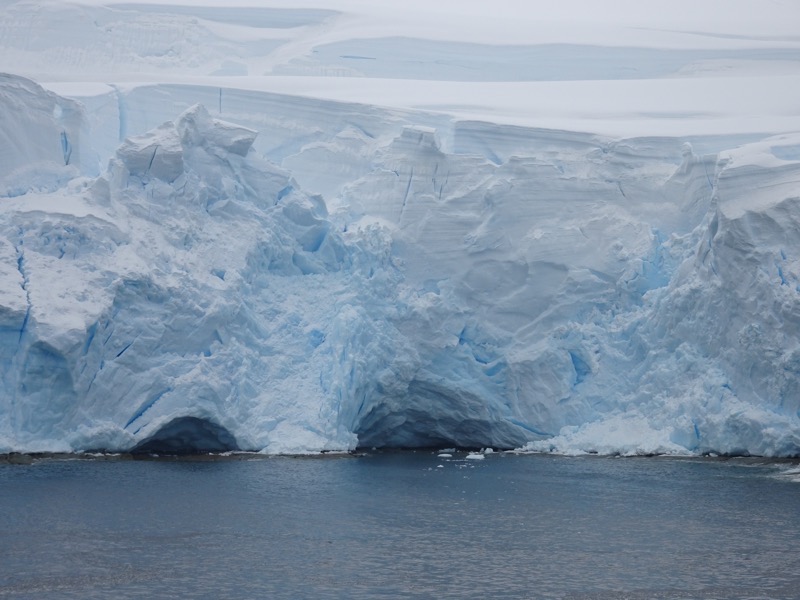
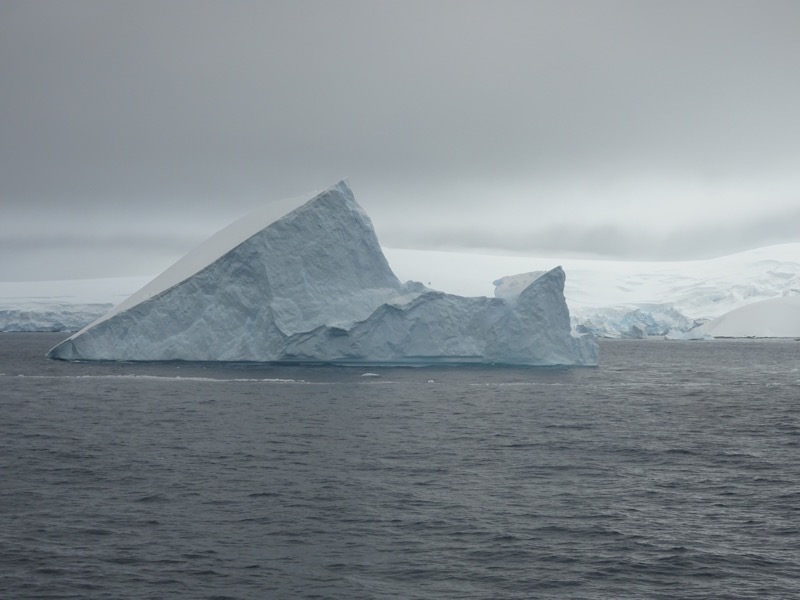
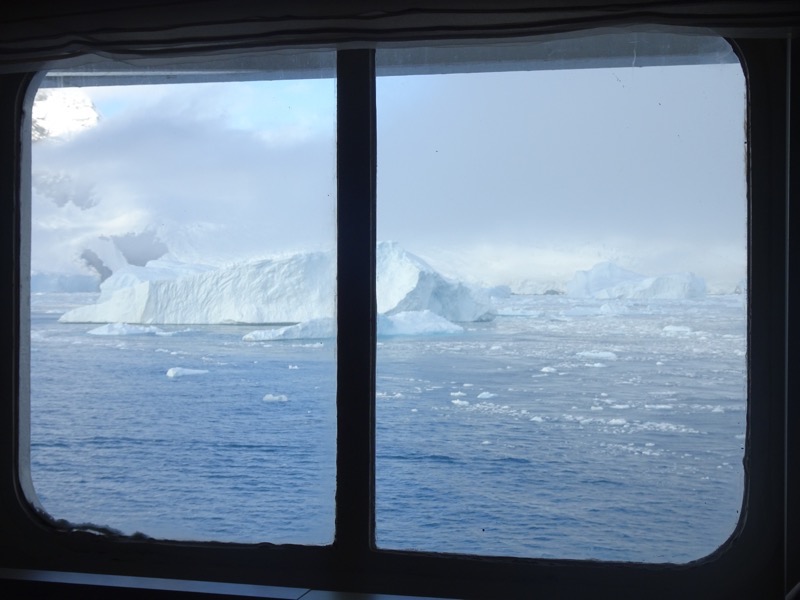 So… about half an hour after I wrote the above, I went outside to take some photos of the glaciers and ice in Graham Passage (well, look at it – you can’t just look at this amazing landscape through a salt-splattered cabin window!) and the cold air brought on such a huge coughing fit that I have decided to be sensible and *not* go out for a zodiac excursion in Graham Passage. 🙁 It’s still snowing – sideways – and our Expedition Leader, Woody, has just come over the PA suggesting everyone ‘rug up a bit, it’s a bit chilly’… which is rugged and tough Antarctic Expedition Leader for: ‘It’s fucking cold people, don’t make me pull out the emergency blankets because you don’t have enough layers on’.
So… about half an hour after I wrote the above, I went outside to take some photos of the glaciers and ice in Graham Passage (well, look at it – you can’t just look at this amazing landscape through a salt-splattered cabin window!) and the cold air brought on such a huge coughing fit that I have decided to be sensible and *not* go out for a zodiac excursion in Graham Passage. 🙁 It’s still snowing – sideways – and our Expedition Leader, Woody, has just come over the PA suggesting everyone ‘rug up a bit, it’s a bit chilly’… which is rugged and tough Antarctic Expedition Leader for: ‘It’s fucking cold people, don’t make me pull out the emergency blankets because you don’t have enough layers on’.
Instead, Trish and I have spent the morning enjoying the views from the ship and watching some movies on the in-room movie channel in between coughing fits. I’ve rung to see the ship’s doctor primarily just to double check which anti-biotic I should be self-medicating on, and I hope I’m much better tomorrow to get in some more zodiac cruising at Deception Island.
Those of our group who did go out this morning said the bay was very beautiful and there was sea ice forming – it needs to get stupid cold for sea ice to be forming on the surface – but that the whales were not very active, they were just logging this morning so it was a very cold and rather quiet excursion. I’m glad I didn’t miss more leopard seals feeding or a pod or killer whales or something, but not so great every one went out in these conditions and didn’t get to see much.
This afternoon we are heading to Cierve Bay to hopefully try and find a calmer spot to go zodiac cruising. At this stage, I’m unlikely to go – I’m still waiting to see Shannon, the ship’s doctor.
Thankfully just after lunch, Shannon, the ship’s doctor came to see us. She had a listen to my chest and I was so relieved to hear that it was just a virus going around the ship and not the start of some hideous bronchitis thing. She has seen nearly half of the people on the ship with similar symptoms since we all got on board, and most of those that had it at the beginning of the trip are well and truly over it now. She also said that the cold air and being outside wasn’t going to make us any worse so if we go out, so just rest up and have a few early nights.
Woo-hoo! I felt rather relieved. After having bloody bronchial pneumonia knock me on my arse for about 8 weeks in 2015, I am really wary of chesty illnesses. The result of this fortuitous conversation was that I felt better about getting rugged up and going out with the afternoon’s planned zodiac cruising around Cierve Bay.
 A sneaky leopard seal checking out the propellor on our zodiac (damn, where’s my polariser now?!)
A sneaky leopard seal checking out the propellor on our zodiac (damn, where’s my polariser now?!)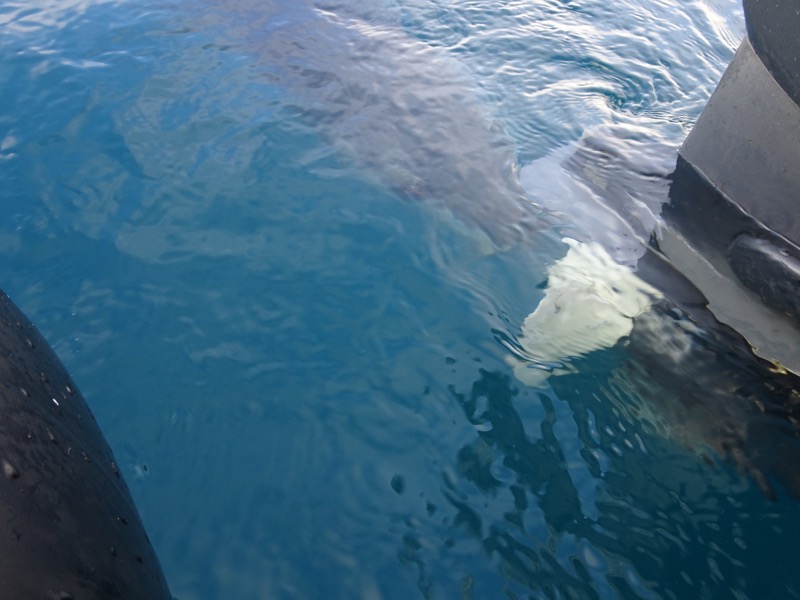
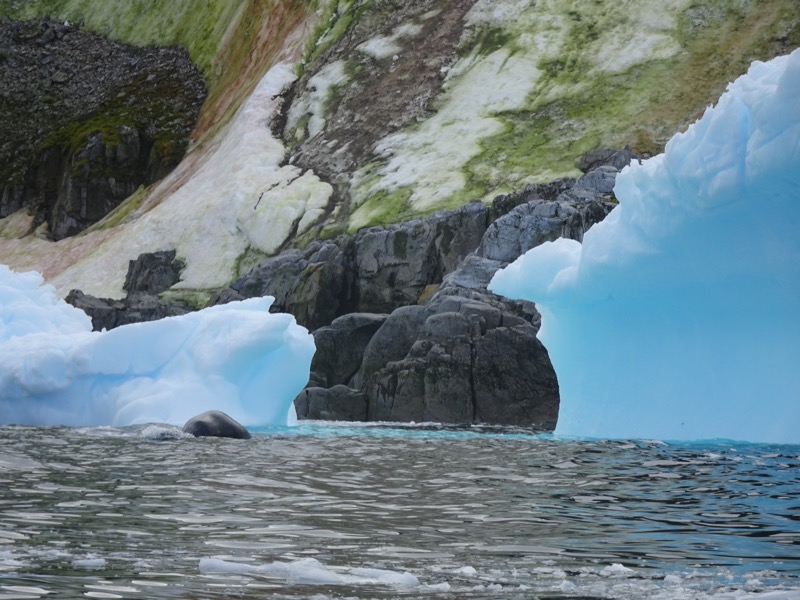
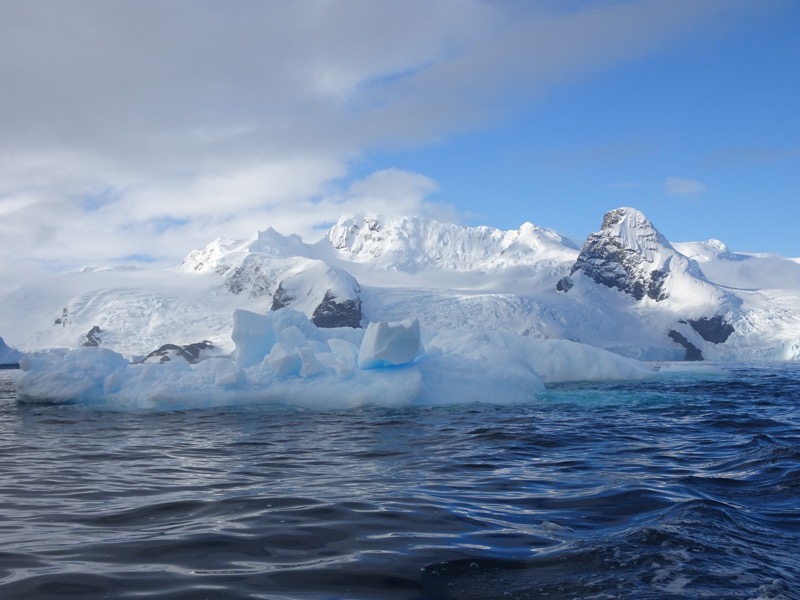
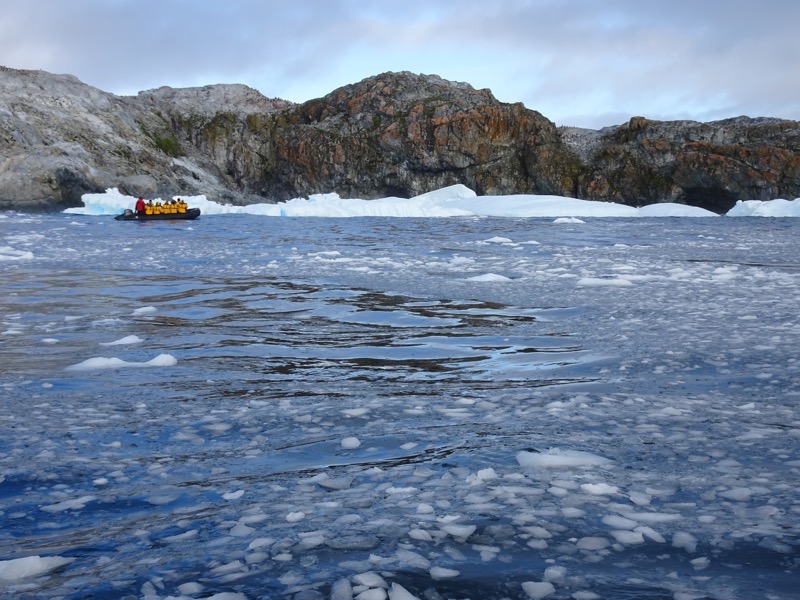 Traversing the brash ice to get into the harbour – I love the sound that it makes as you cut through it in the zodiacs.
Traversing the brash ice to get into the harbour – I love the sound that it makes as you cut through it in the zodiacs.
I am so glad I rugged up and went out… With no real notice the weather had lifted and cleared up completely and we spent a couple of hours riding around in the zodiacs in beautiful blue skies and bright sunshine this afternoon. It was so warm I was unzipping my parka and taking my gloves off to try and cool down. We have really been enjoying the moody and atmospheric conditions that we have had over the last few days of excursions, but now Antarctica showed us a whole different palette of colours.
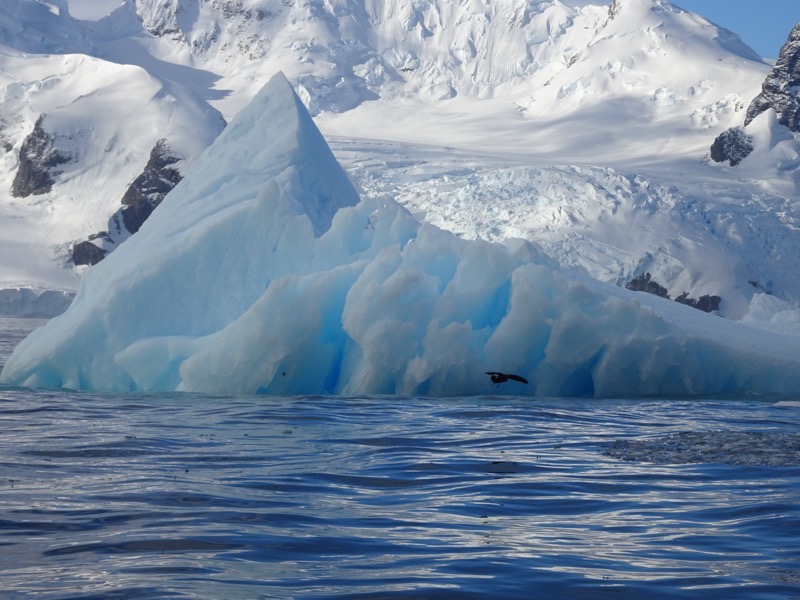
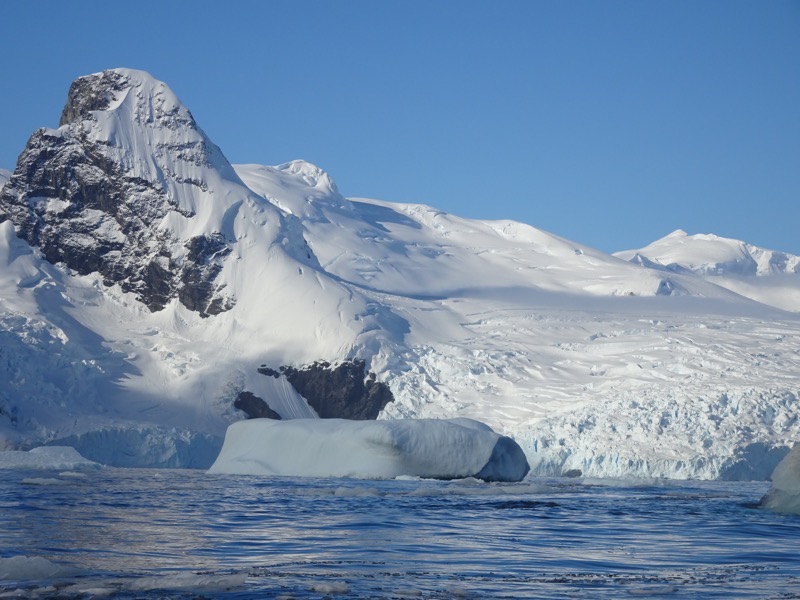

 About four gorgeous whales in front of a tidewater glacier.
About four gorgeous whales in front of a tidewater glacier.
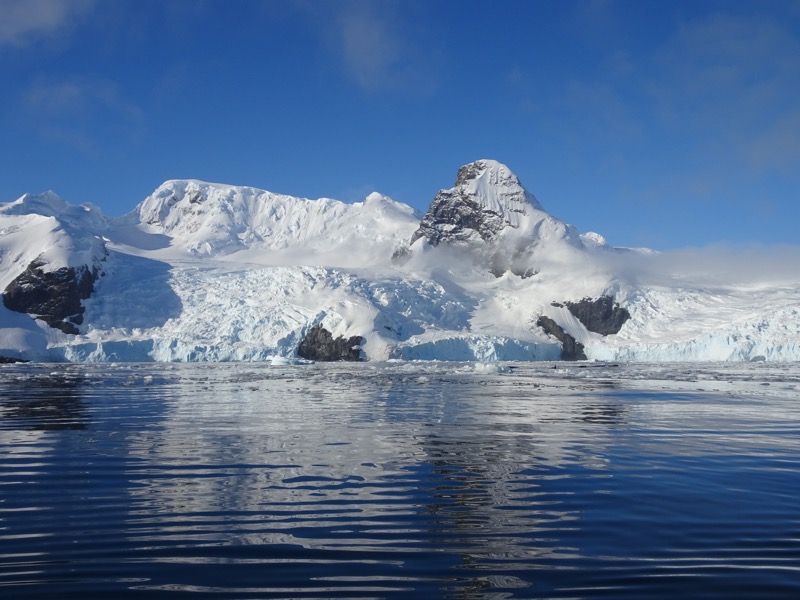 Not a single one of these photos has been adjusted for brightness, contrast, colour balance or anything. They are straight from the camera and unfiltered and unenhanced. A couple might have had yellow jacket bits cropped out of them – but they are compltely unmanipulated.
Not a single one of these photos has been adjusted for brightness, contrast, colour balance or anything. They are straight from the camera and unfiltered and unenhanced. A couple might have had yellow jacket bits cropped out of them – but they are compltely unmanipulated.
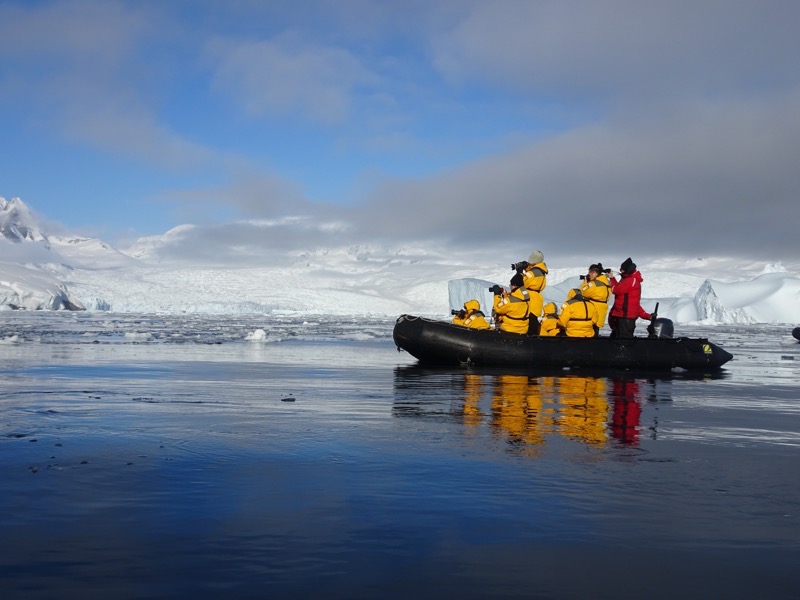
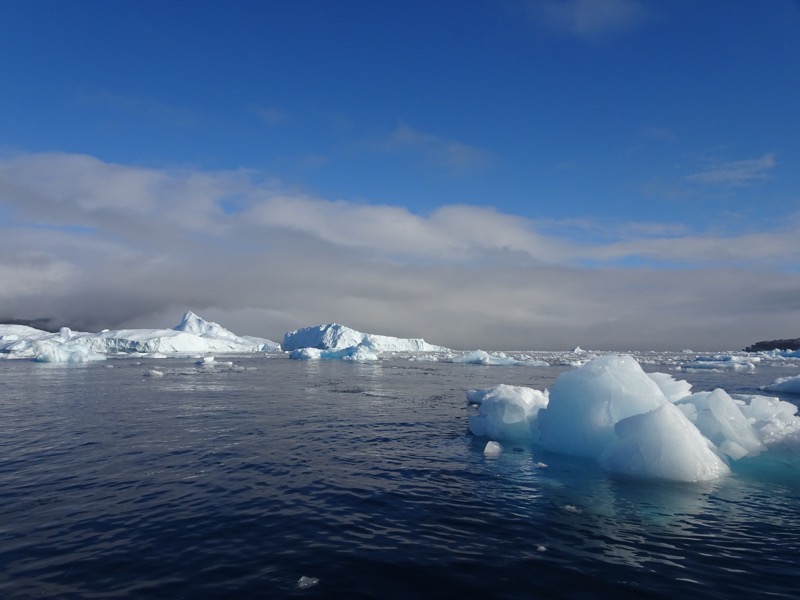
 While earlier we had been lamenting the lack of blue skies somewhat, now that we had some, I was glad for the overcast days leading up to this – everything is so blindingly white and the glare hits you from every direction. The worst of it is you can’t see anything on your camera’s LCD screen – even turned right up, it’s not bright enough to overcome this much ambient light. So every shot you take is pretty much composed blind (so many crooked horizons!). Behind us when we turned into the sun:
While earlier we had been lamenting the lack of blue skies somewhat, now that we had some, I was glad for the overcast days leading up to this – everything is so blindingly white and the glare hits you from every direction. The worst of it is you can’t see anything on your camera’s LCD screen – even turned right up, it’s not bright enough to overcome this much ambient light. So every shot you take is pretty much composed blind (so many crooked horizons!). Behind us when we turned into the sun:
 Getting in amongst the ice.
Getting in amongst the ice.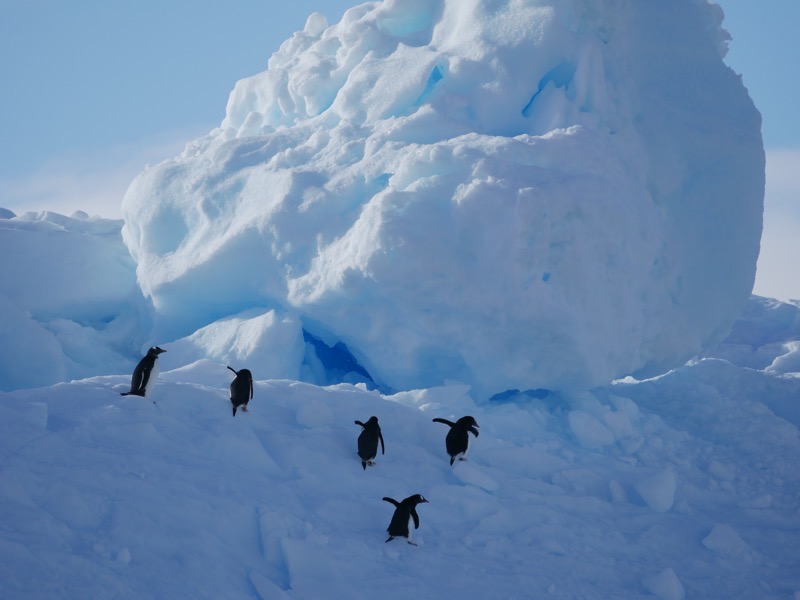 Some Chinstrap penguins blending in with the Gentoo.
Some Chinstrap penguins blending in with the Gentoo.
Crystal clear water, gorgeous blue icebergs and bright snow and clear skies. It was just amazing out there this afternoon. We saw more leopard seals feeding, at one point were surrounded by about a dozen humpback whales, more crab-eater seals and quite a few chinstrap penguins. The guides here are incredible and you would think they would be used to this place, but every day we have gone out with them they have seemed as full of amazement as we are. This afternoon our guide, Naomi, was so overcome she literally had tears in her eyes when a humpback whale emerged from the dark water right beside our zodiac. He was so huge and so calm and majestic, and so close I swear you could have reached out to touch him. We have seen so many whales this trip, and the guides have been telling us that on many trips, people are lucky to see one whale, and there we were this afternoon surrounded by about fifteen whales and not knowing which way to look, in the hope of seeing their elegant tails as they dived down to feed.
Chinstrap photo by Arthur: 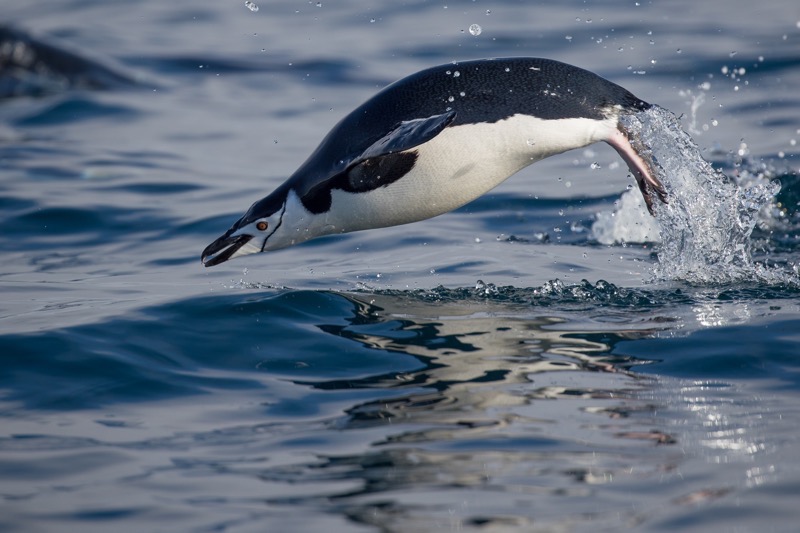 Photo by Linda:
Photo by Linda: Linda again:
Linda again: Couple of pics from Arthur:
Couple of pics from Arthur: Poor little penguin! Nasty ol’ leopard seal.
Poor little penguin! Nasty ol’ leopard seal. Gulp feeding. Photo by Jandoc:
Gulp feeding. Photo by Jandoc: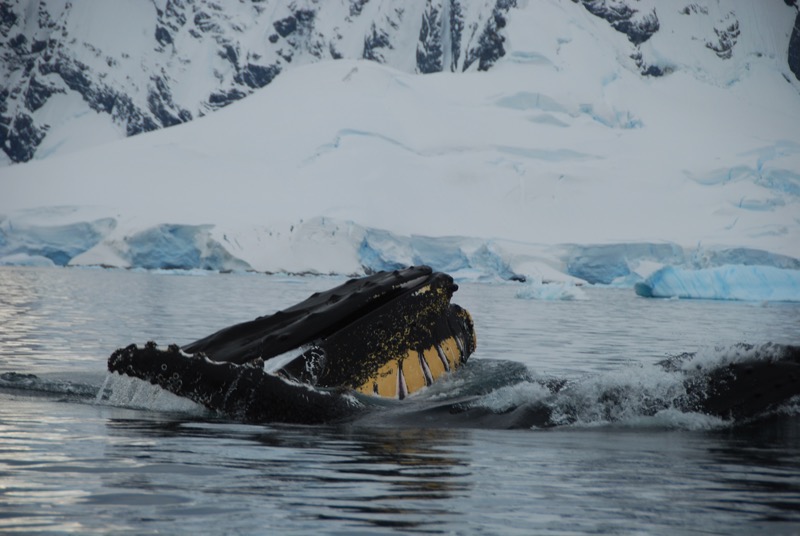 Photo by Leonardo (Lyn, Mum, Trish and I are in the zodiac pictured!):
Photo by Leonardo (Lyn, Mum, Trish and I are in the zodiac pictured!):
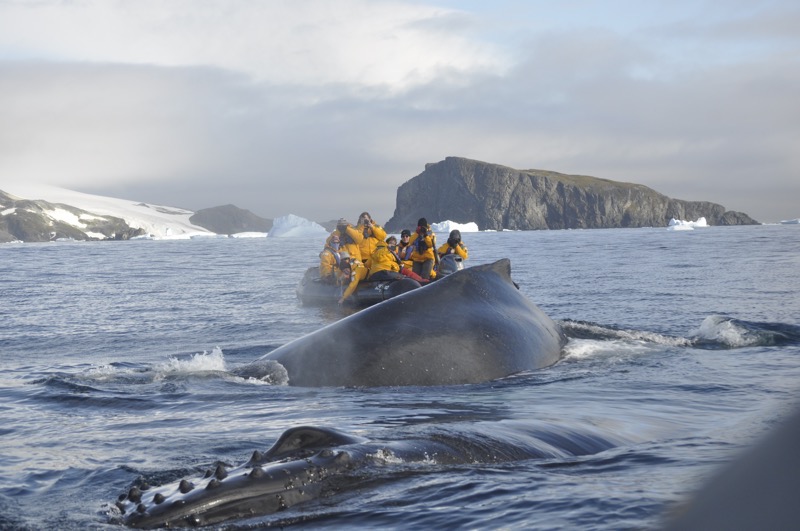
We saw some rather rare phenomena today – a large truck sized iceberg rolled right in front of us. The sun comes out for even just a short time and it will accelerate the melting of an iceberg and with that melting comes a destabilizing effect that causes the iceberg to roll to regain ‘balance’ on the water. We saw a chunk fall off an iceberg and then saw as it rolled and rolled until it seemingly lumbered its way to a new resting position.
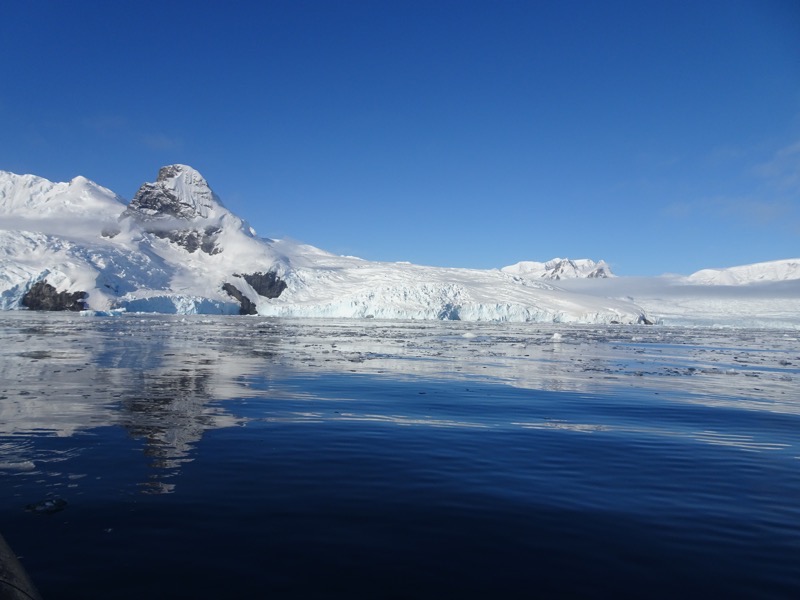
I am so glad I went out this afternoon.

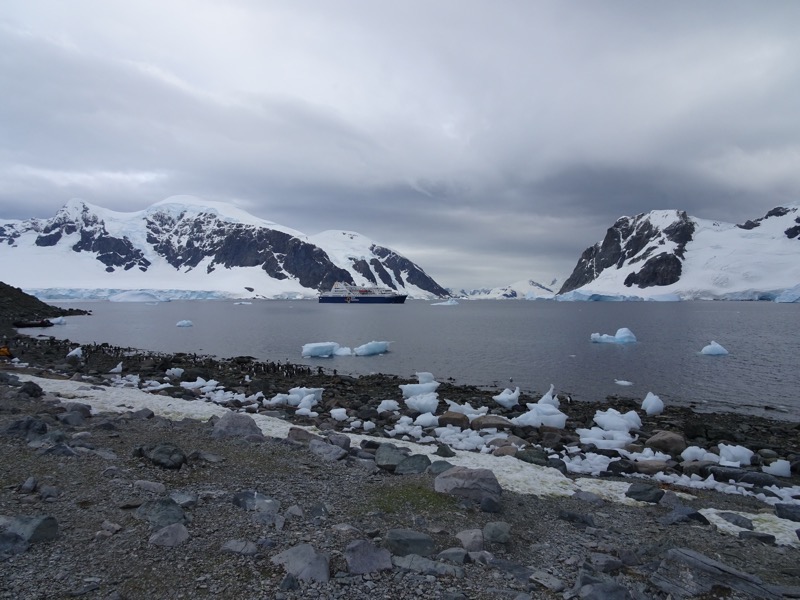
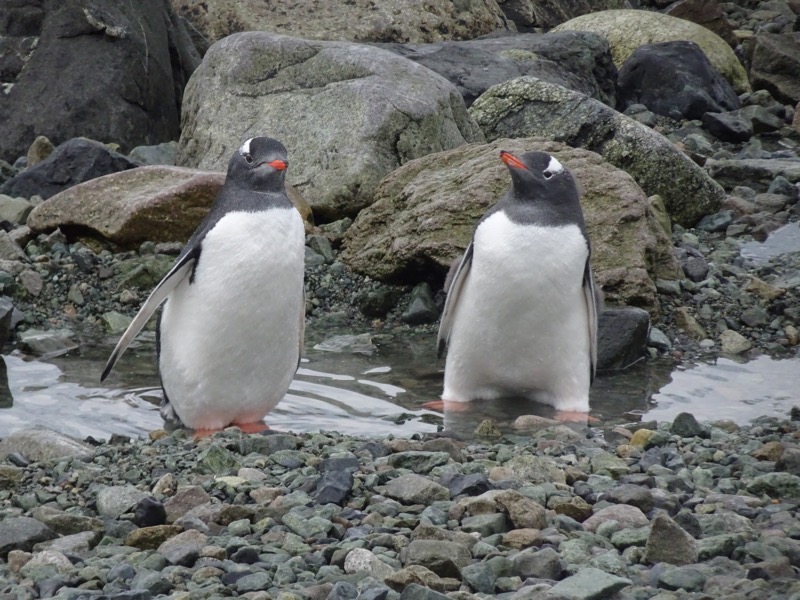
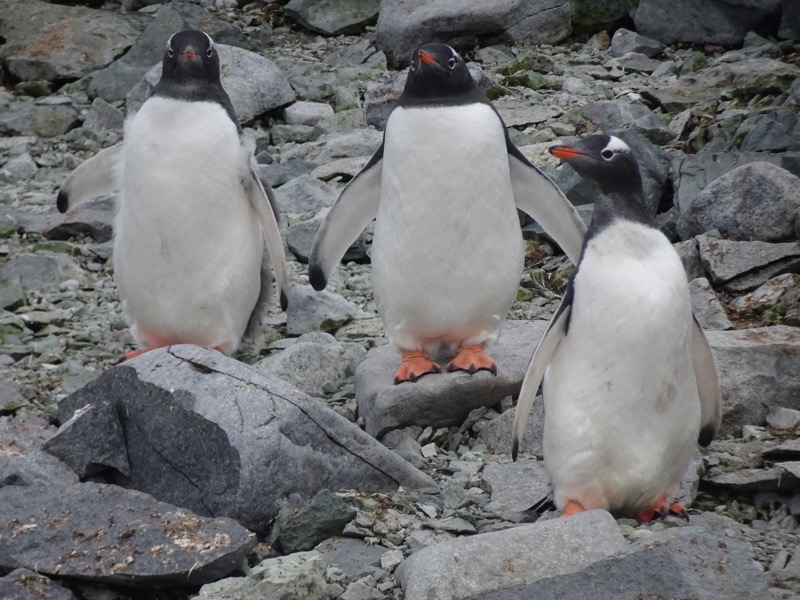
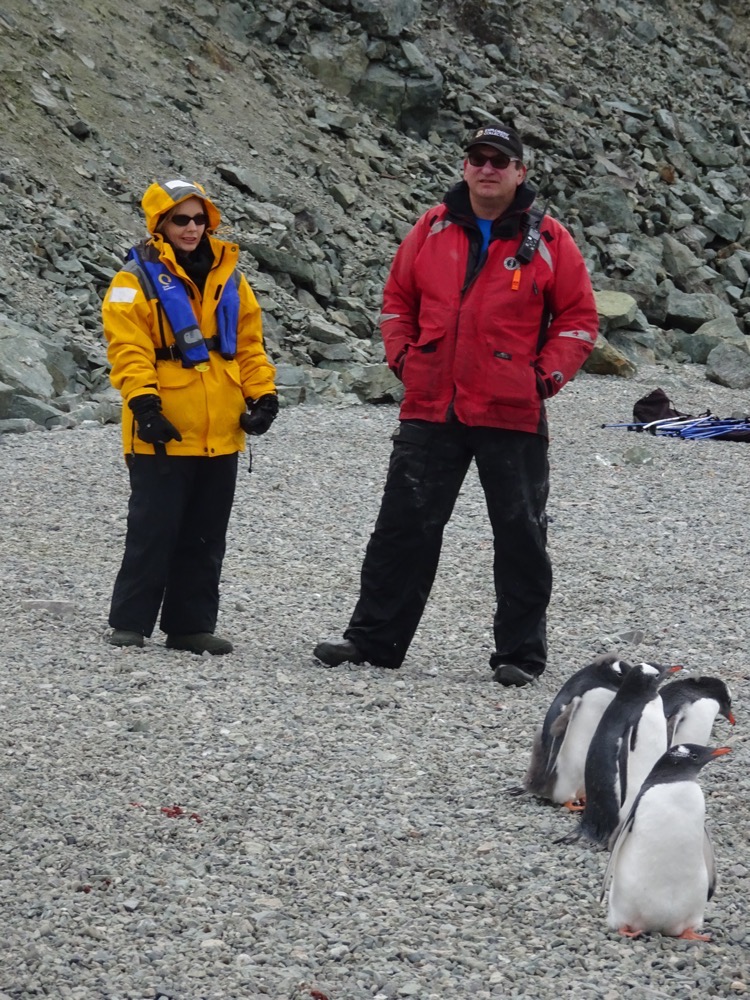 More little juveniles learning to swim – they are so funny to watch, hopping in, falling about and hopping straight out again. The more time we spend with the penguins, the more character and personality we seem to be attributing to them.
More little juveniles learning to swim – they are so funny to watch, hopping in, falling about and hopping straight out again. The more time we spend with the penguins, the more character and personality we seem to be attributing to them. Yep, that’ll keep you warm…
Yep, that’ll keep you warm…
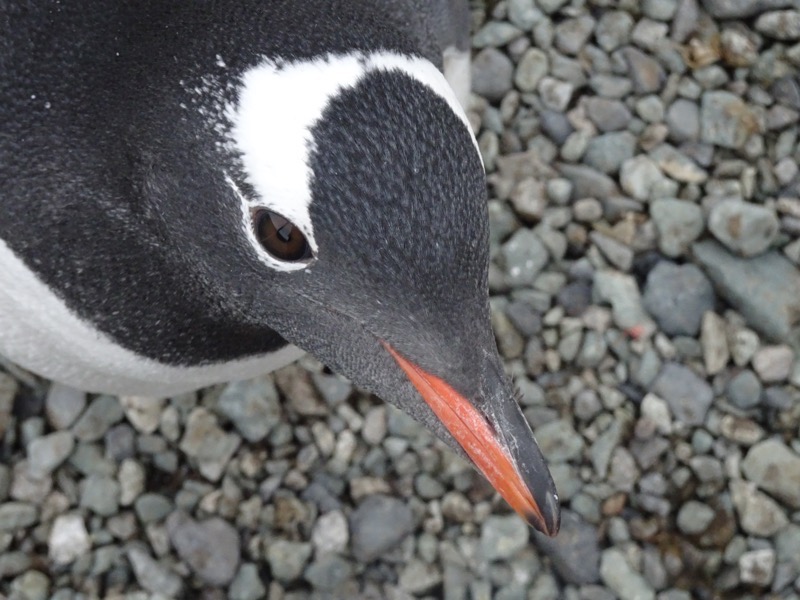

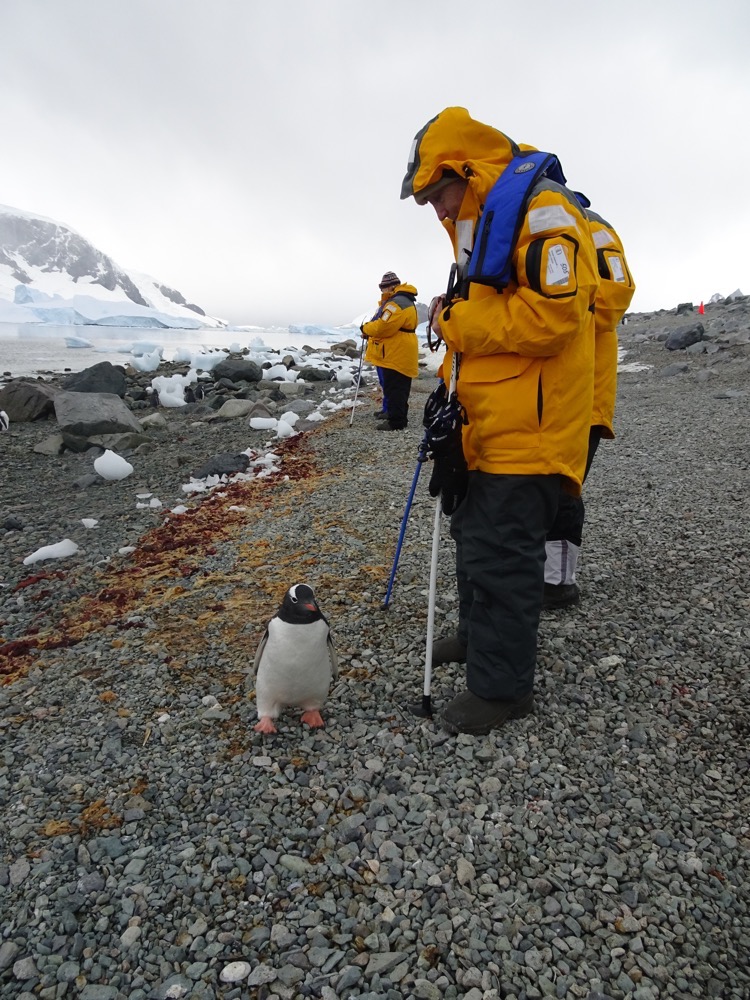 What you looking at?
What you looking at?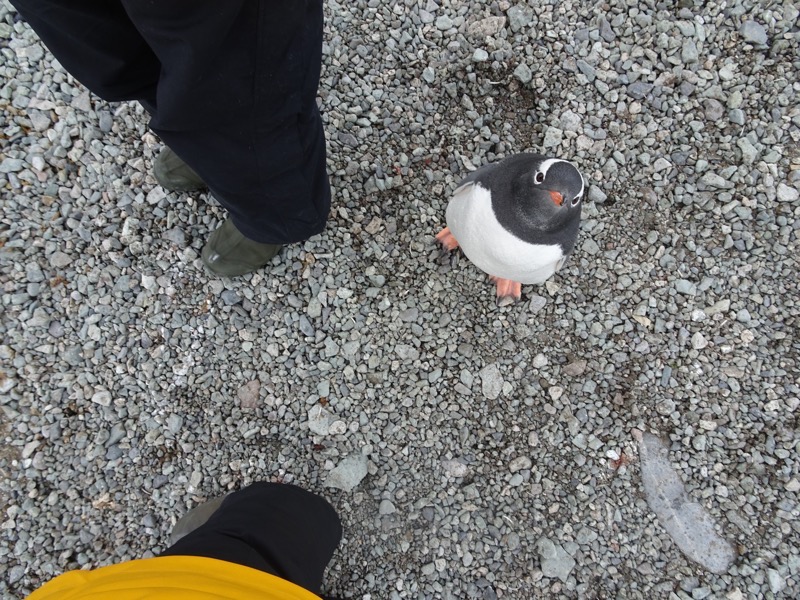 Hey!
Hey! Run, Gentoo! Run!
Run, Gentoo! Run! Photo by Arthur:
Photo by Arthur: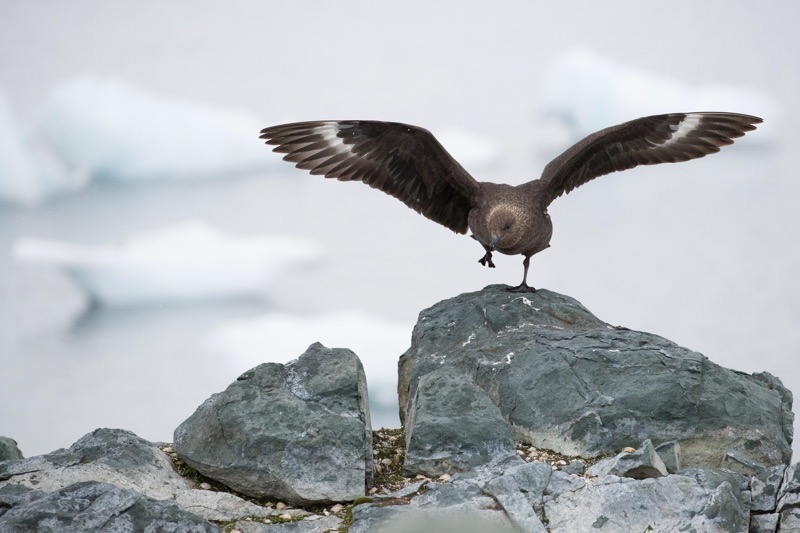
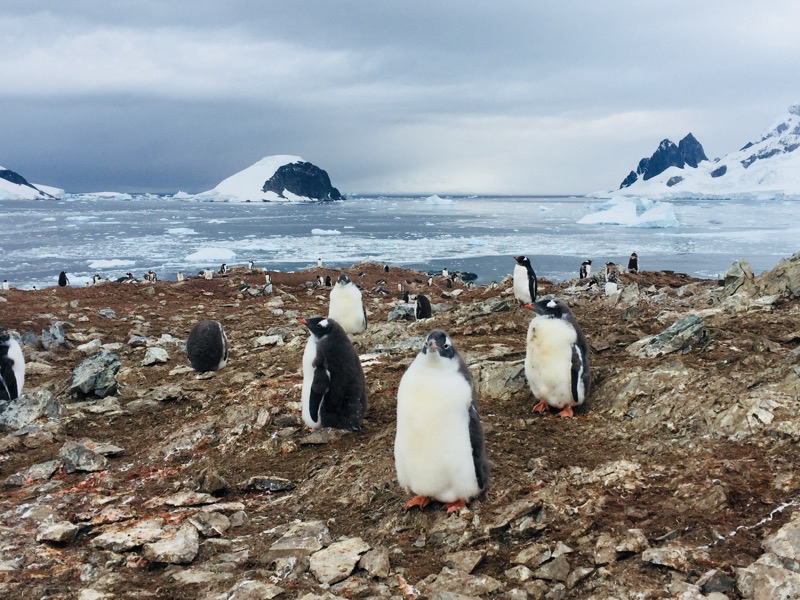
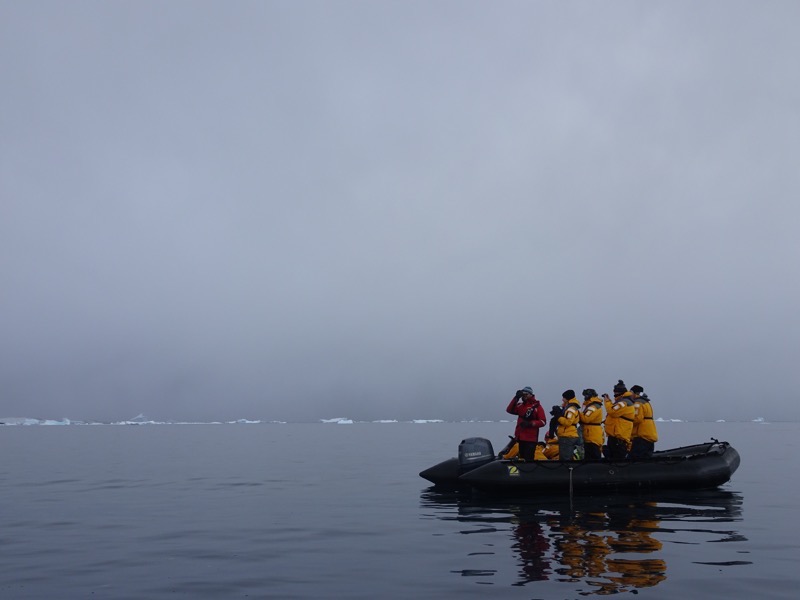
 Driving the zodiac through the brash ice is a strange feeling, a bit like scraping along a sandbar for ages.
Driving the zodiac through the brash ice is a strange feeling, a bit like scraping along a sandbar for ages.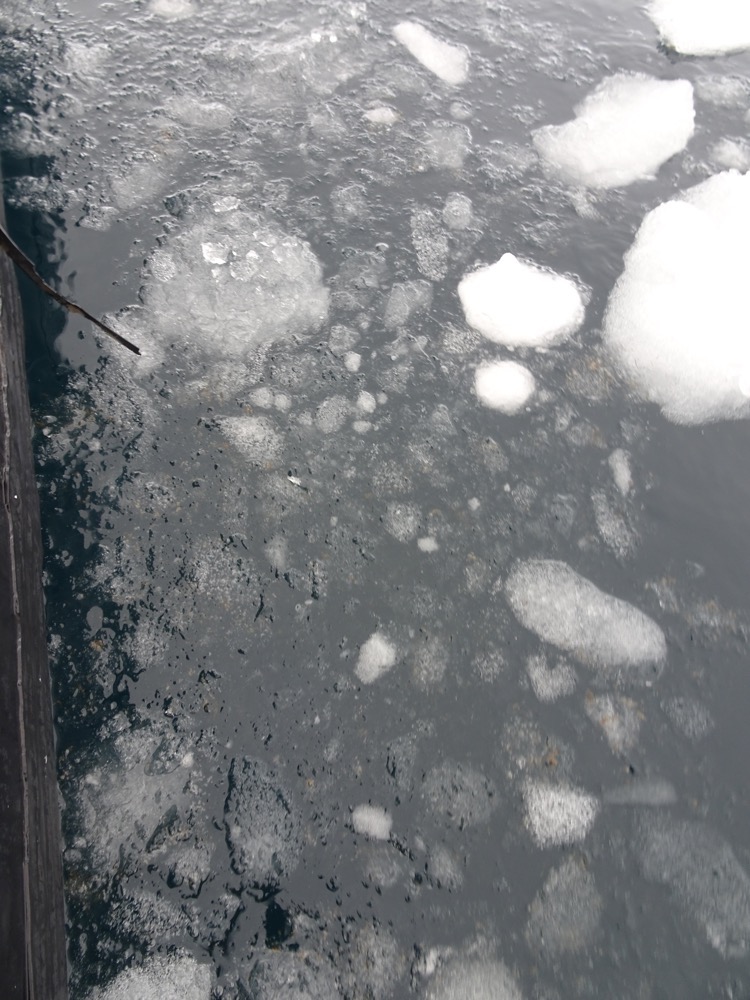

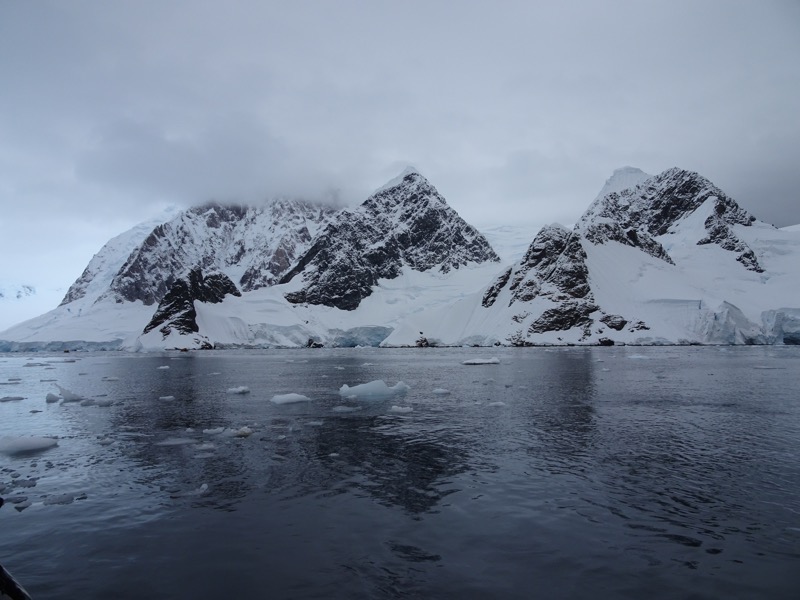 Most of the whales we met this morning were just lolling about logging. It seems they tend to be more active in the afternoons when they are awake and feeding more. We saw some other wildlife this morning – mostly birds and a few crabeater seals.
Most of the whales we met this morning were just lolling about logging. It seems they tend to be more active in the afternoons when they are awake and feeding more. We saw some other wildlife this morning – mostly birds and a few crabeater seals.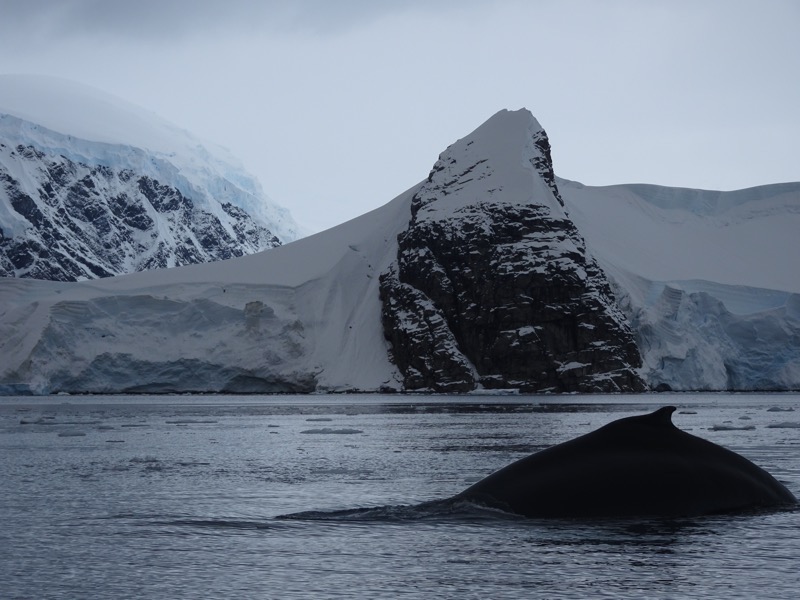
 Photo by Arthur:
Photo by Arthur: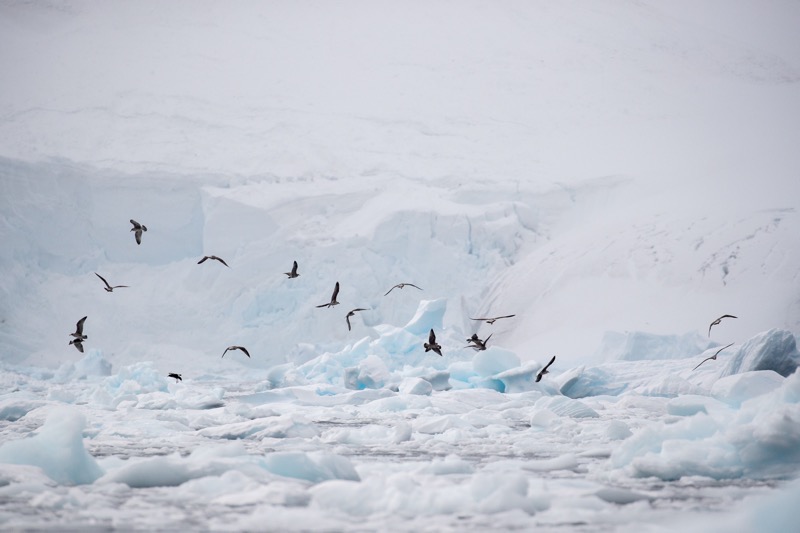 Photo by Jayn:
Photo by Jayn: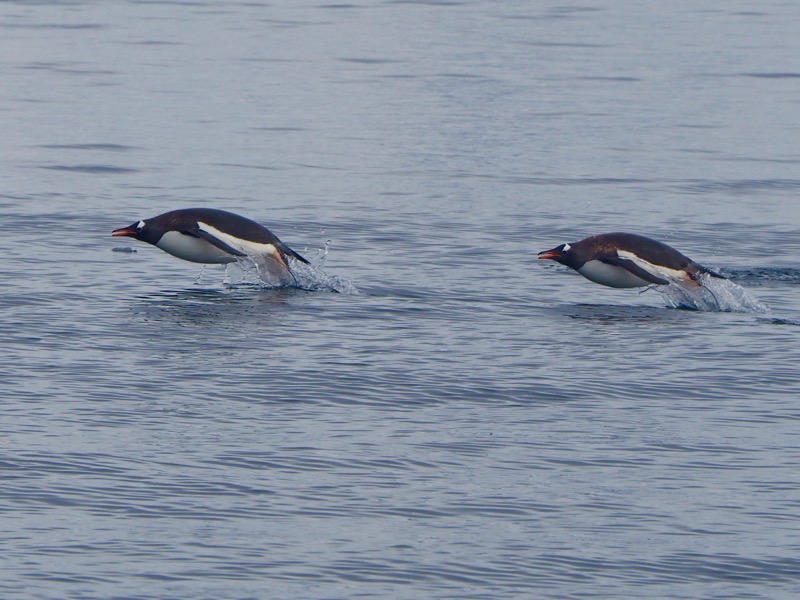 Photo by Arthur:
Photo by Arthur: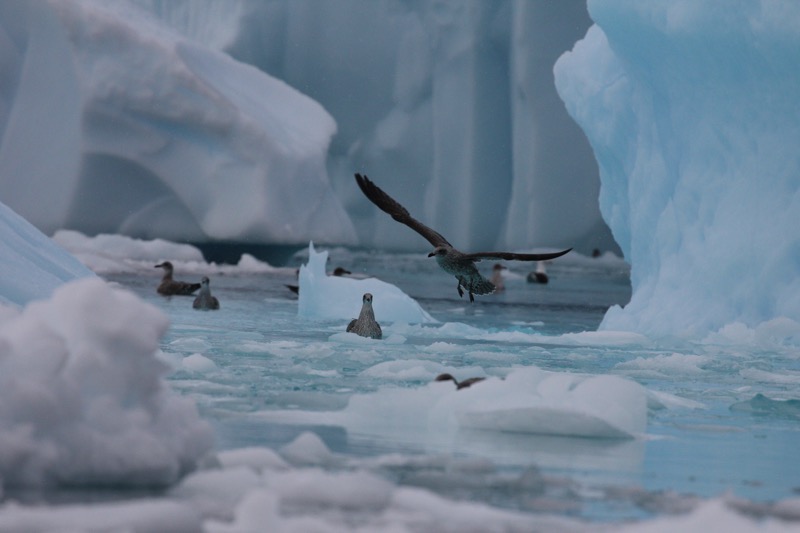 And of course, more beautiful icebergs.
And of course, more beautiful icebergs.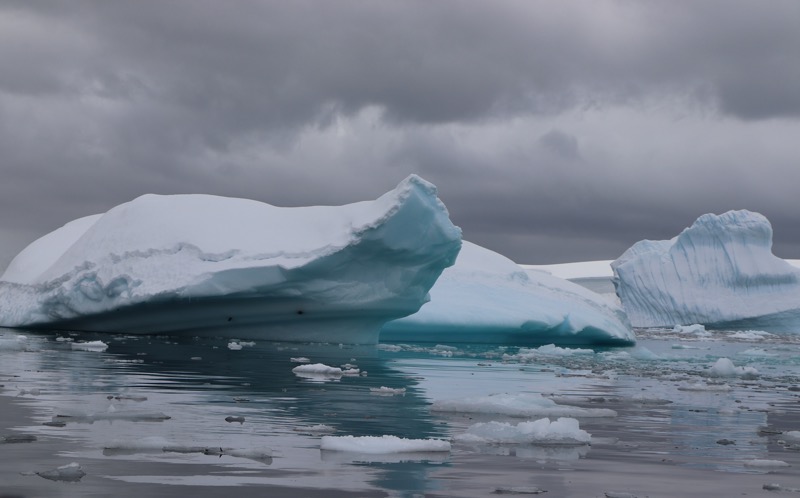

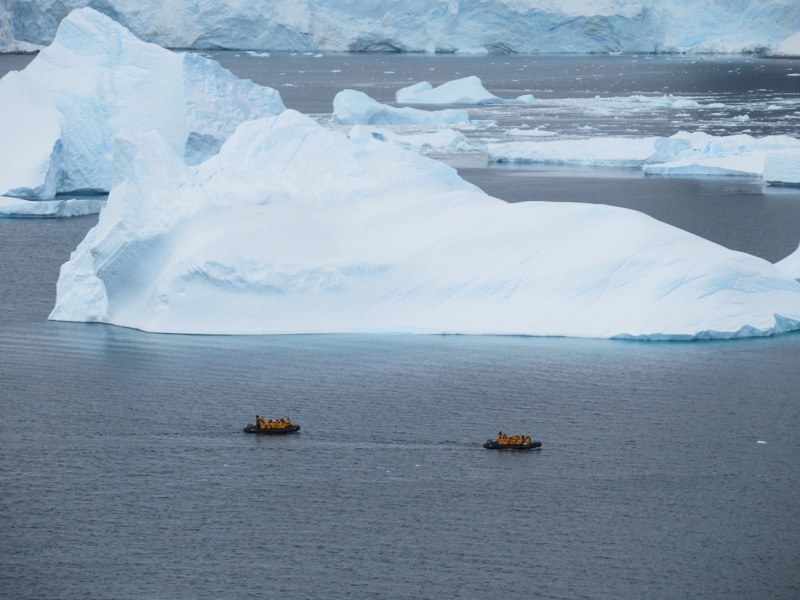
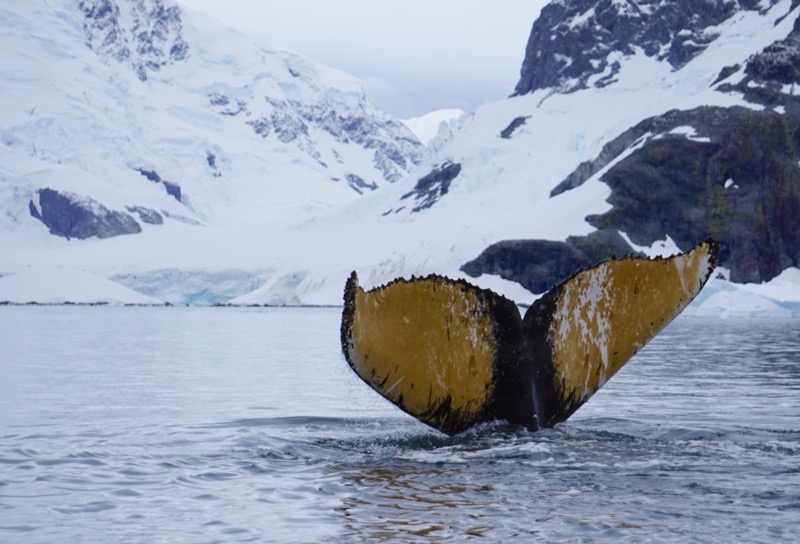
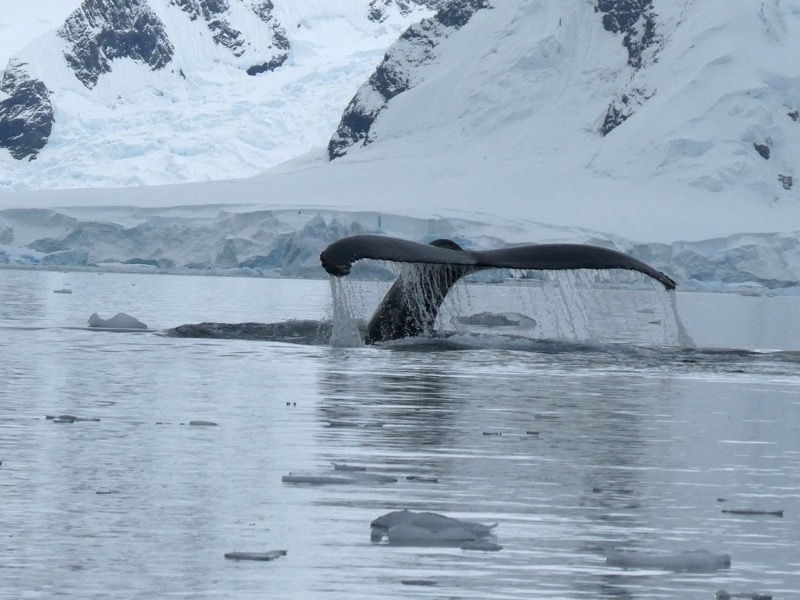
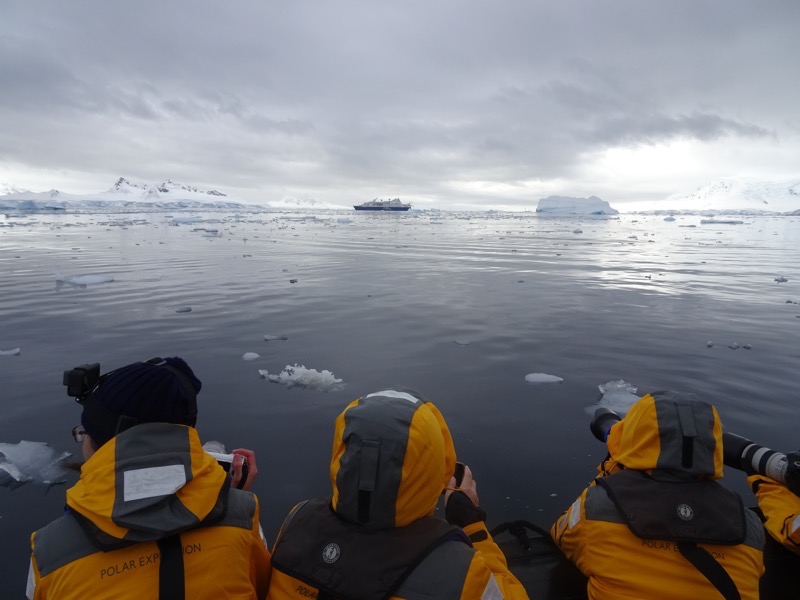
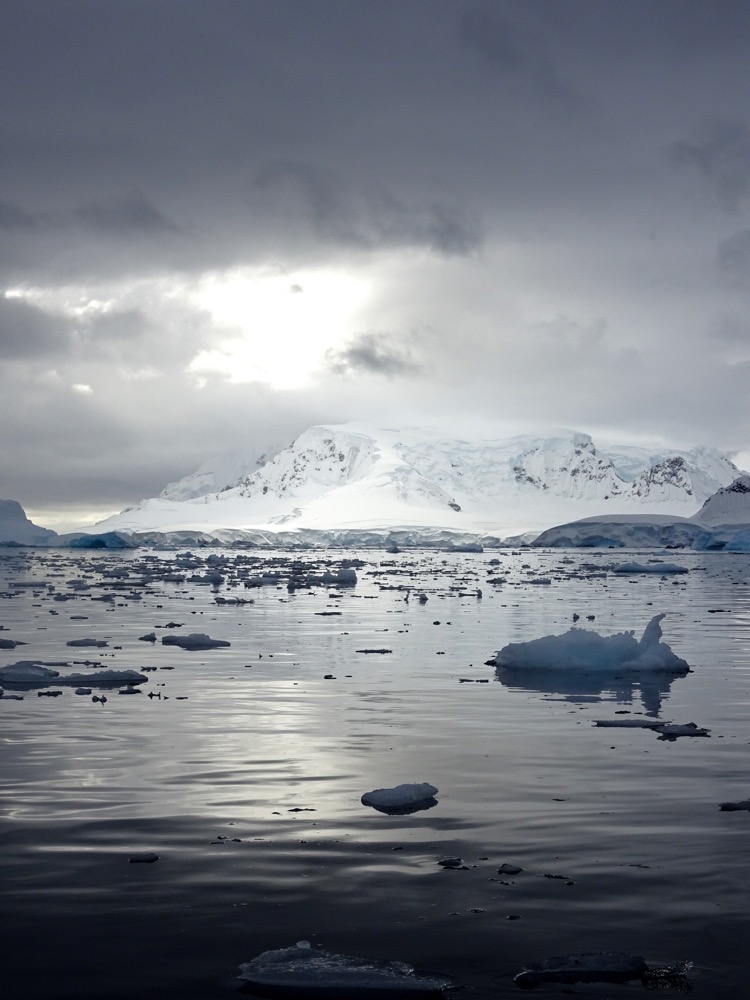
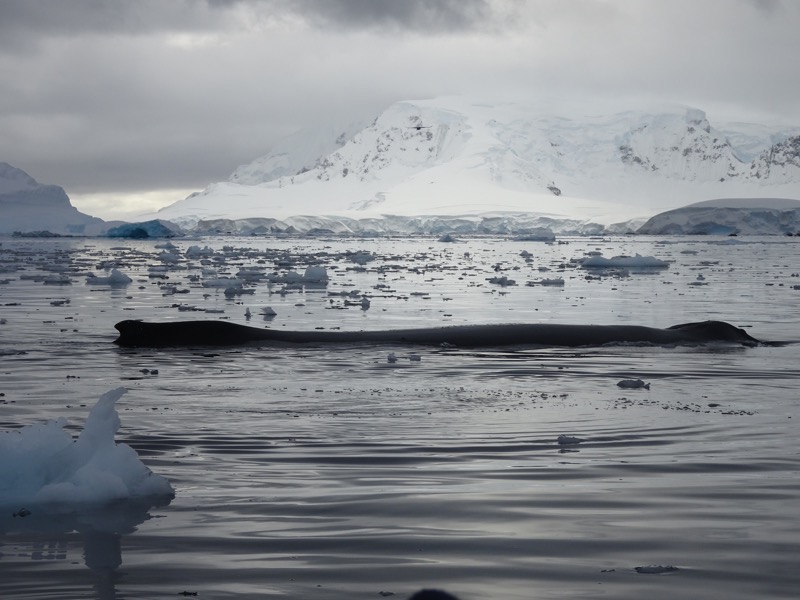
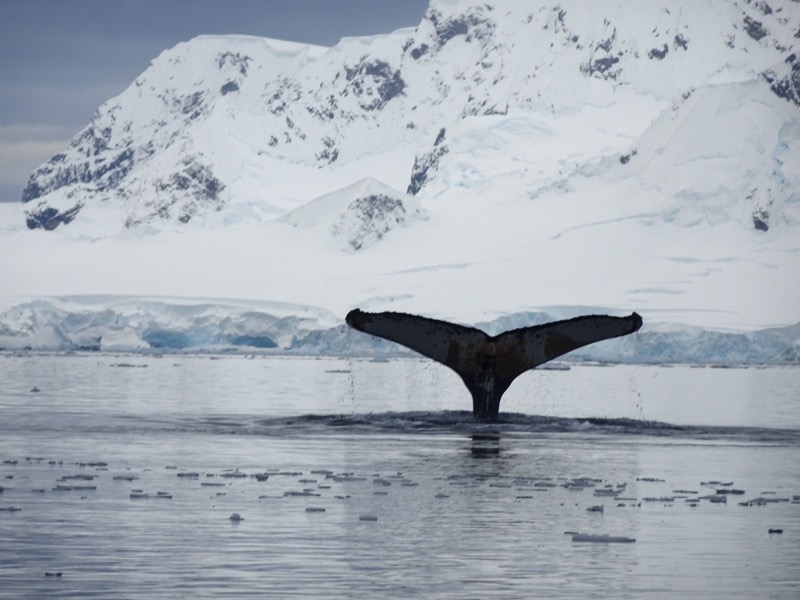
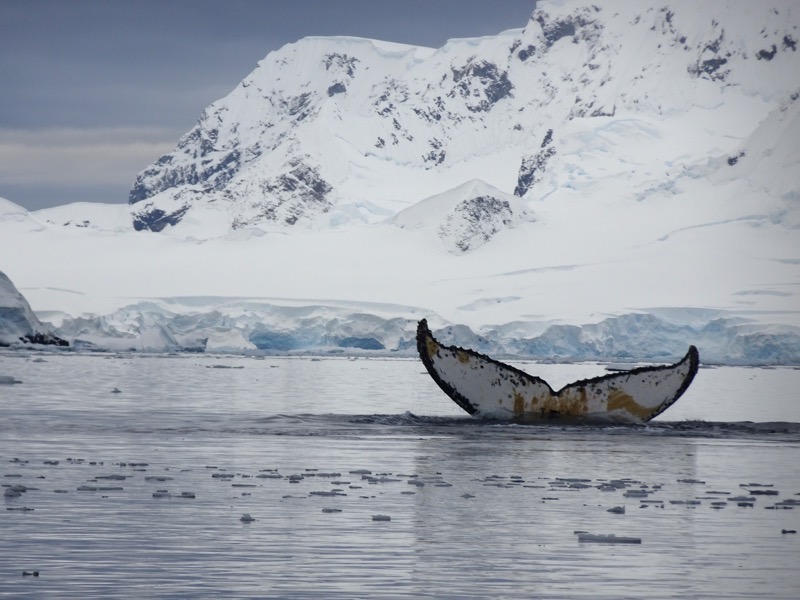
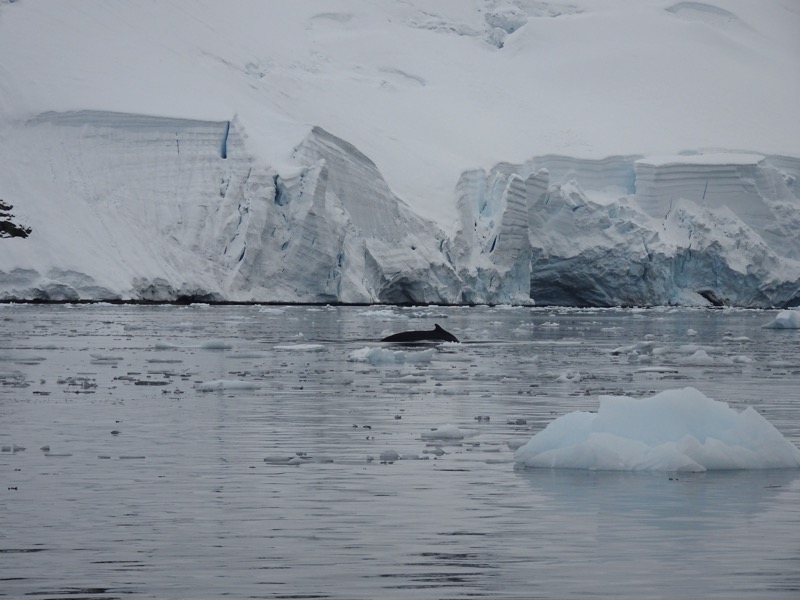
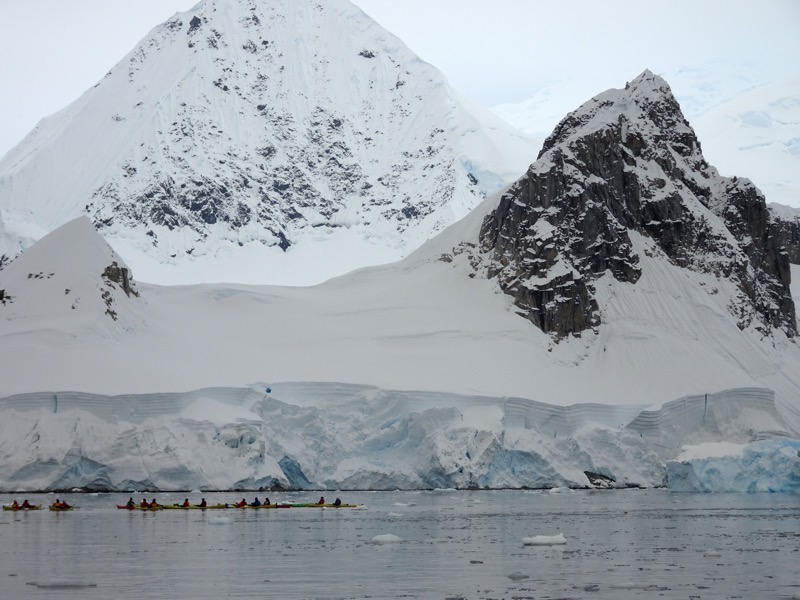
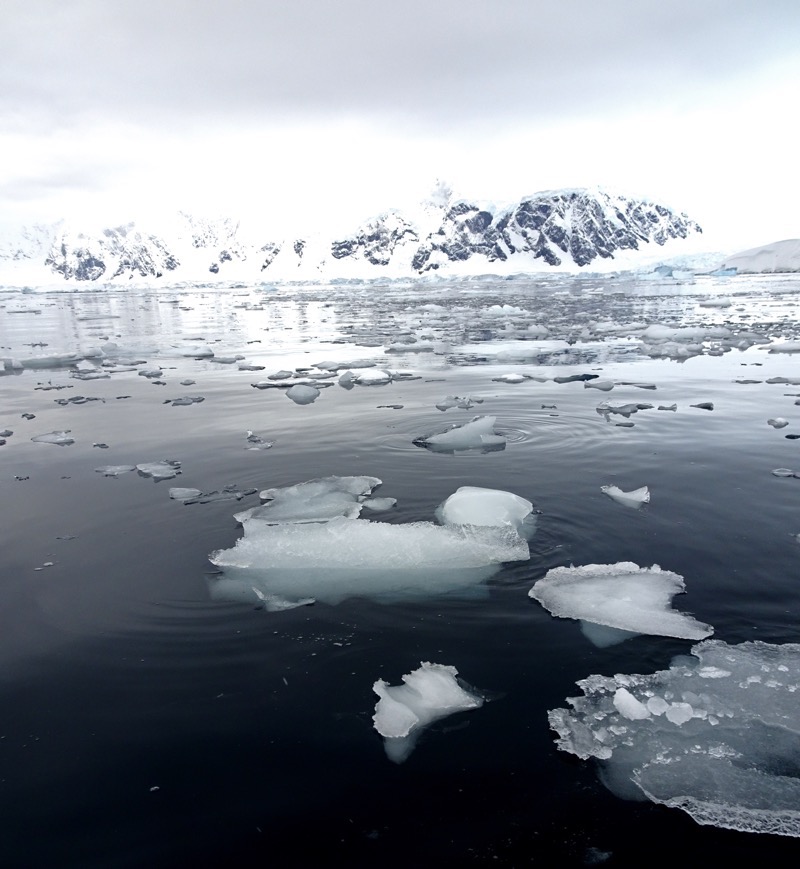
 Uncredited, unfortunately, I assume one of the kayak guides took it:
Uncredited, unfortunately, I assume one of the kayak guides took it: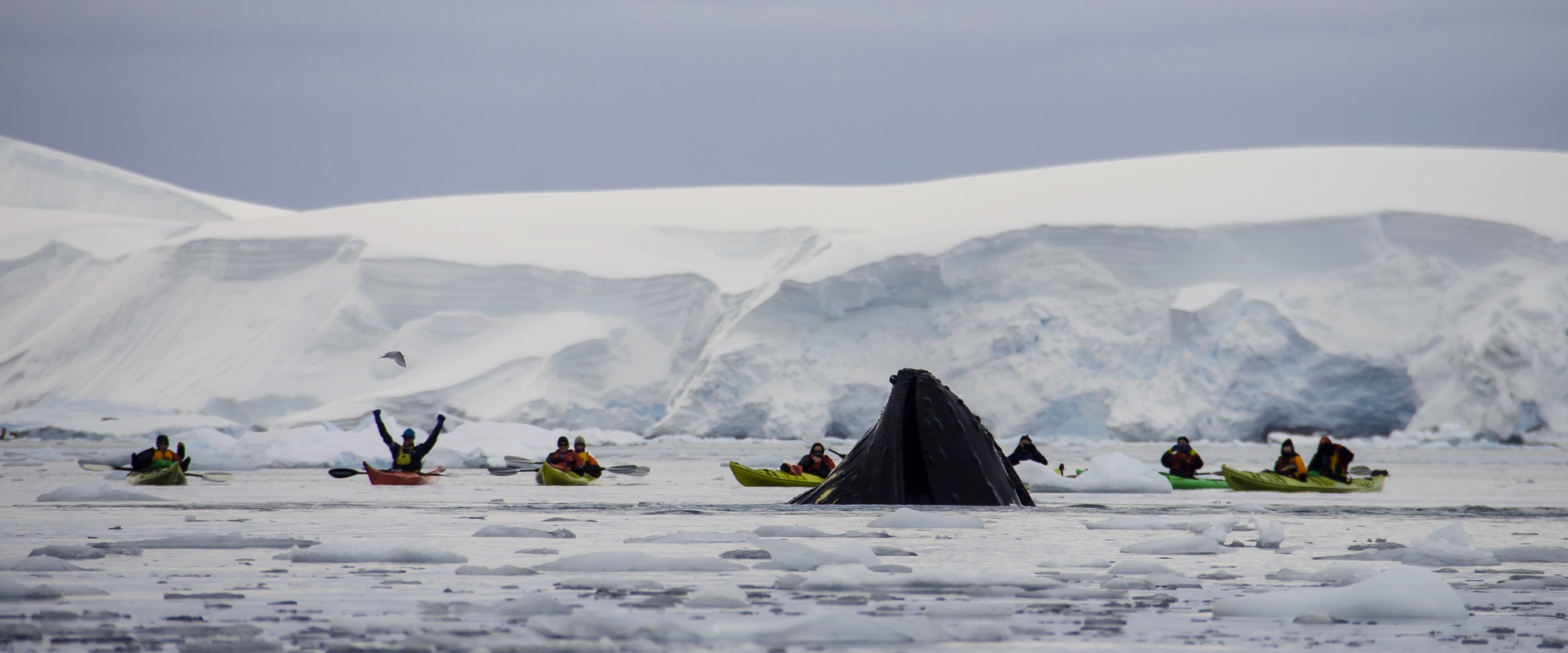 Photo by Leanne:
Photo by Leanne: Photo by Leane:
Photo by Leane: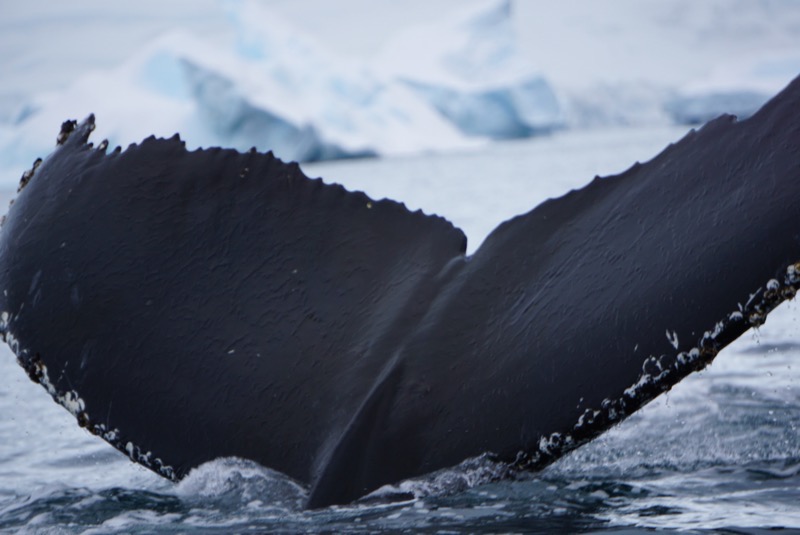 Back to the ship and it was very shortly time for our debrief/recap and then onto a BBQ on the back deck for an evening of dining al fresco! Yep, no shit – Gunter, our head chef and his entire team cooked up a storm out on the open decks and we had a crazy hat party.
Back to the ship and it was very shortly time for our debrief/recap and then onto a BBQ on the back deck for an evening of dining al fresco! Yep, no shit – Gunter, our head chef and his entire team cooked up a storm out on the open decks and we had a crazy hat party.
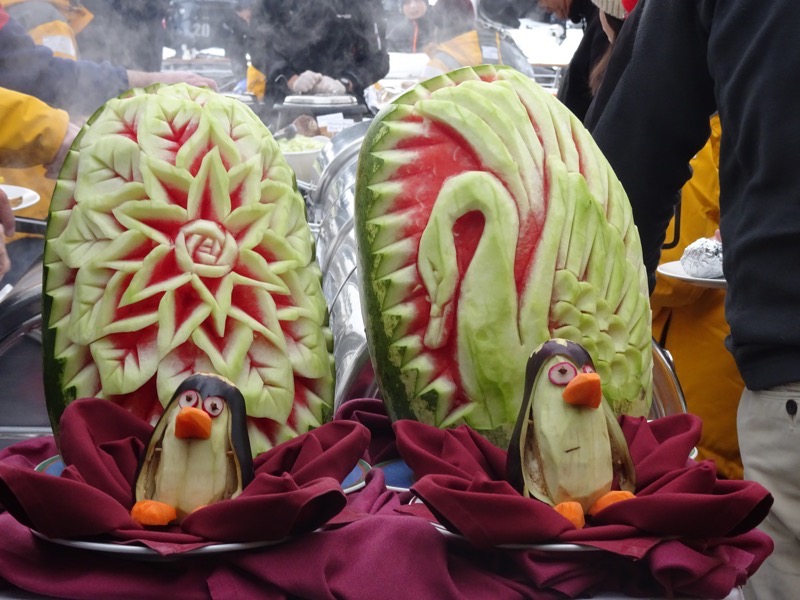
 Happy Birthday Mum! <3
Happy Birthday Mum! <3 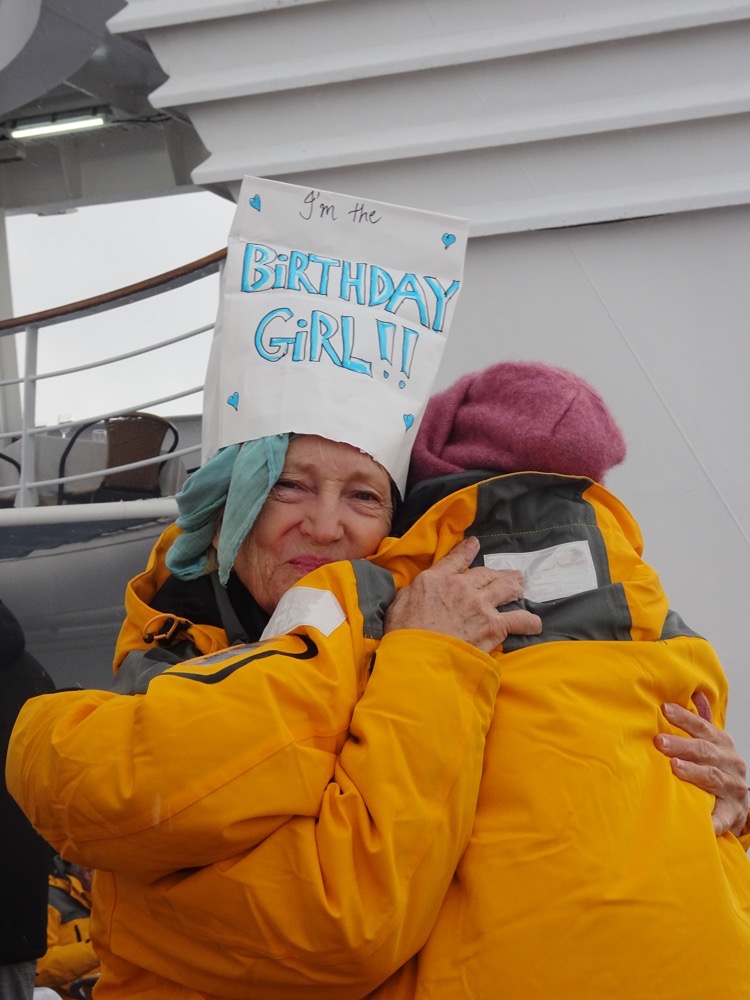 Alex, our Ukrainian Maitre D’ and some of his servers came and sung Happy Birthday.
Alex, our Ukrainian Maitre D’ and some of his servers came and sung Happy Birthday.
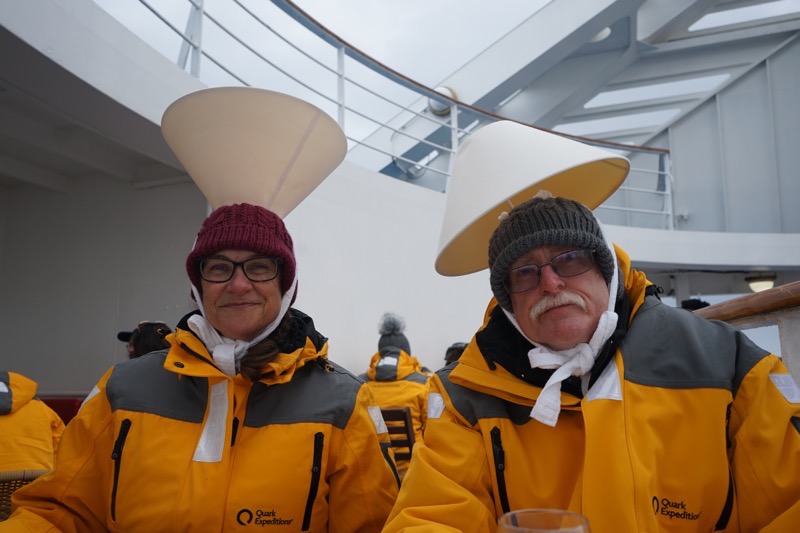

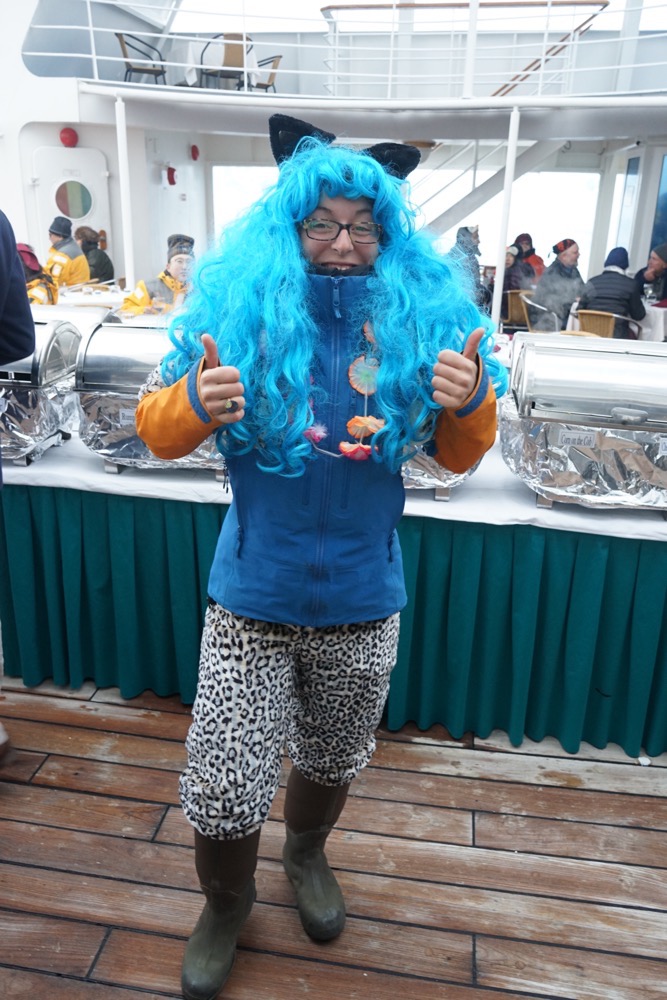
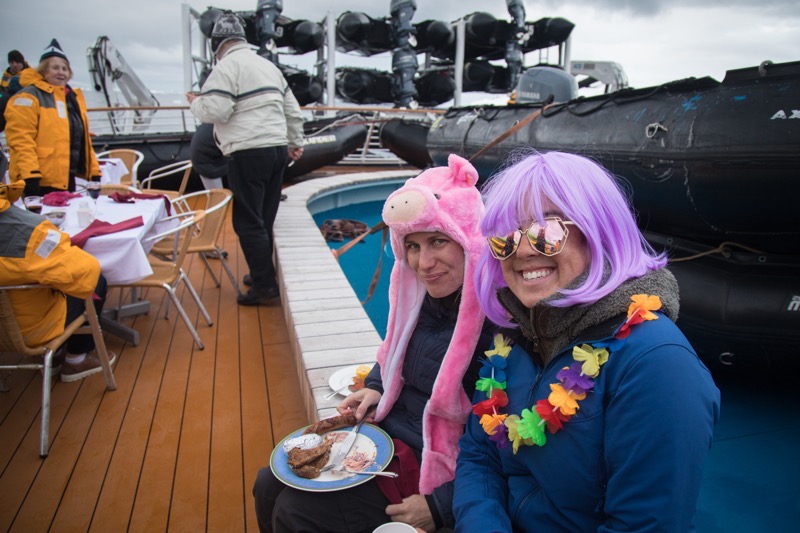
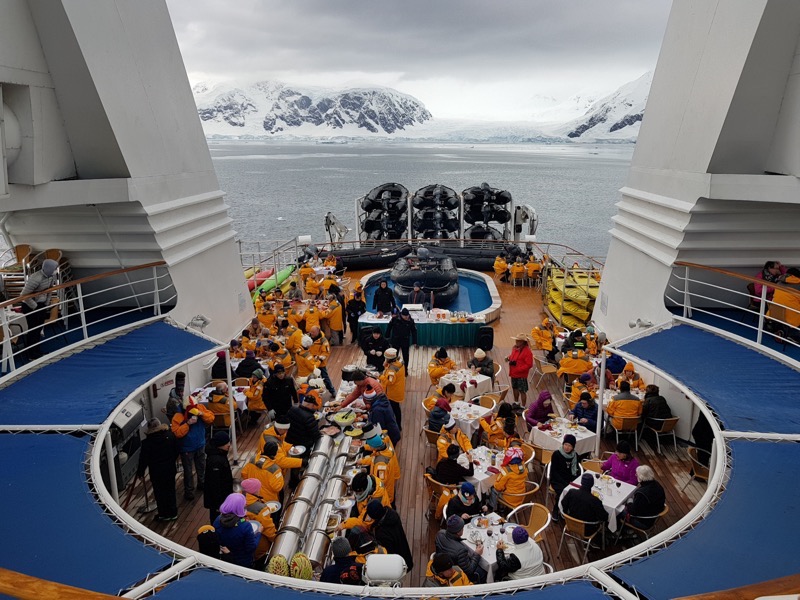 A great finish to another excellent day in Antarctica. I’m loving this voyage – it’s simply unbelievable.
A great finish to another excellent day in Antarctica. I’m loving this voyage – it’s simply unbelievable.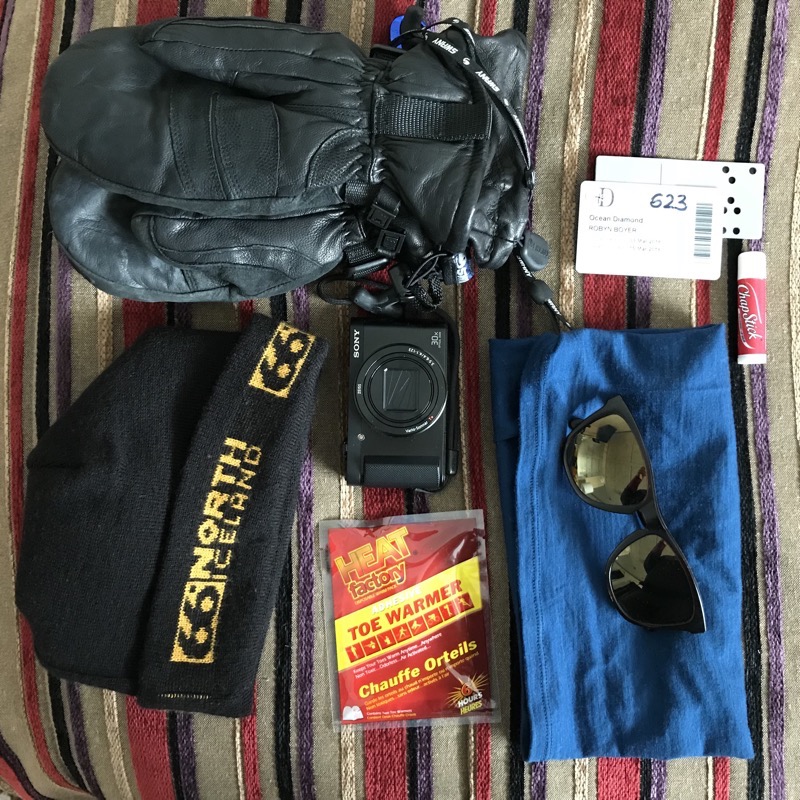
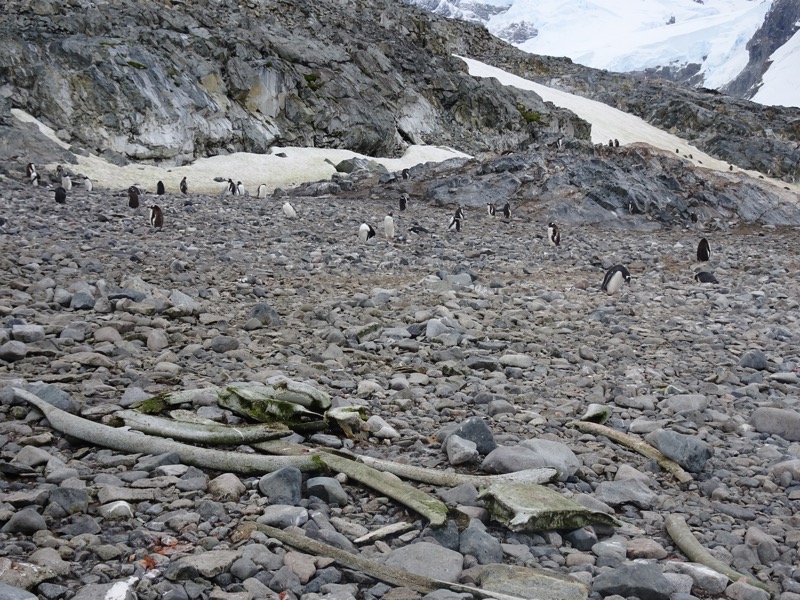
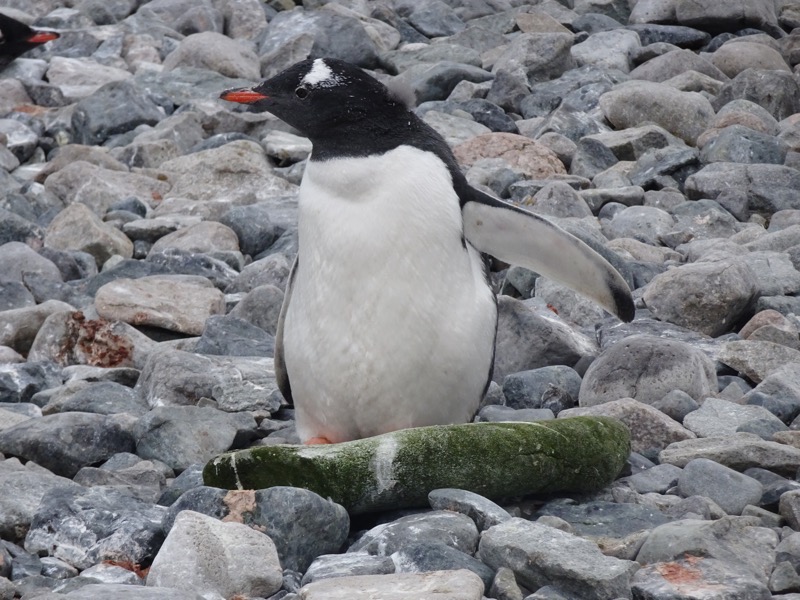
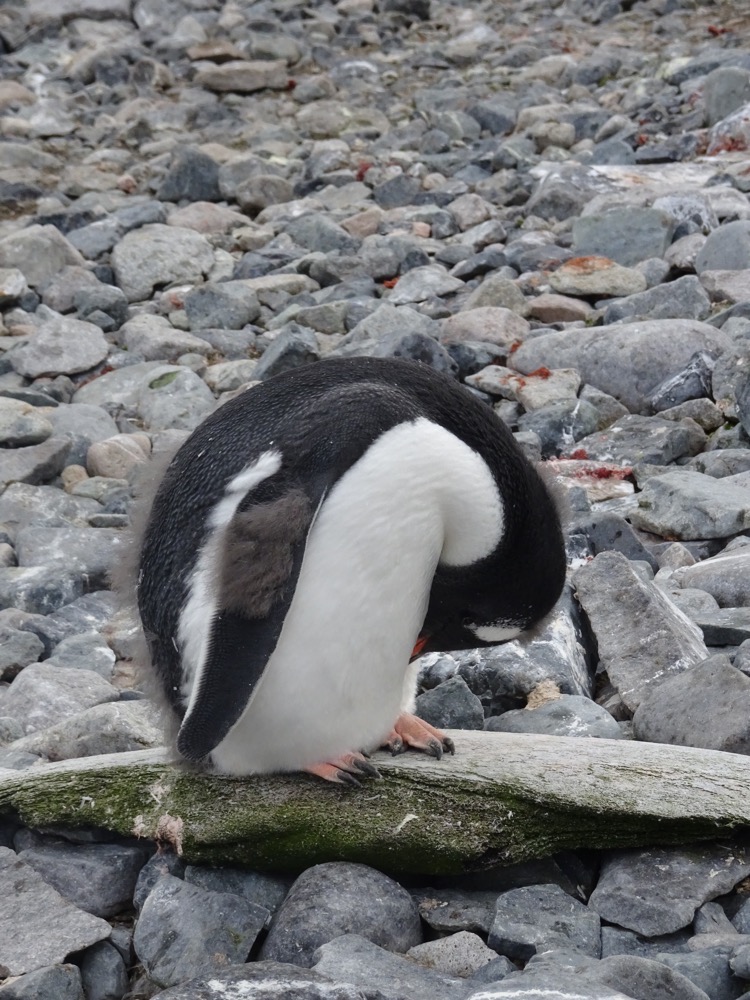

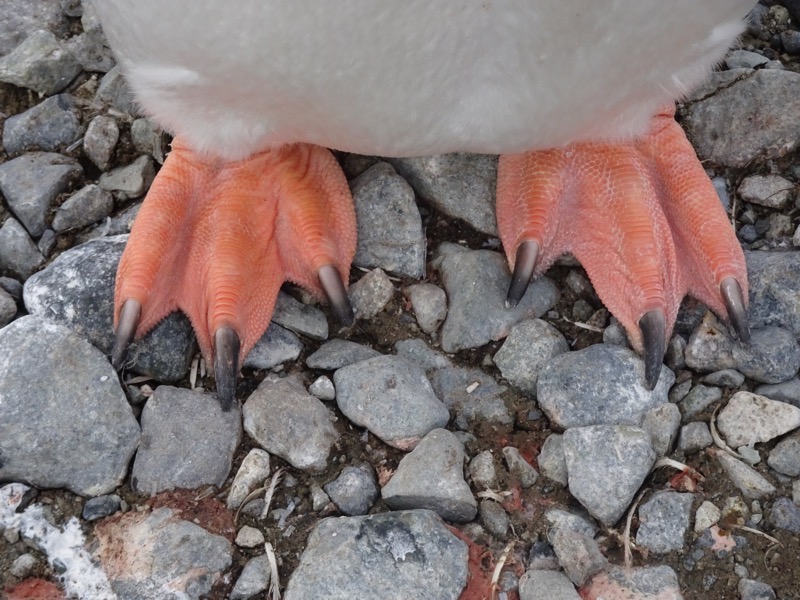
 These guys are juveniles, going through the moulting process to shed all their baby feathers. They aren’t ‘waterproof’ while they have fluffy feathers all over them, and they can’t get into the water and learn how to swim properly until they have finished moutling.
These guys are juveniles, going through the moulting process to shed all their baby feathers. They aren’t ‘waterproof’ while they have fluffy feathers all over them, and they can’t get into the water and learn how to swim properly until they have finished moutling.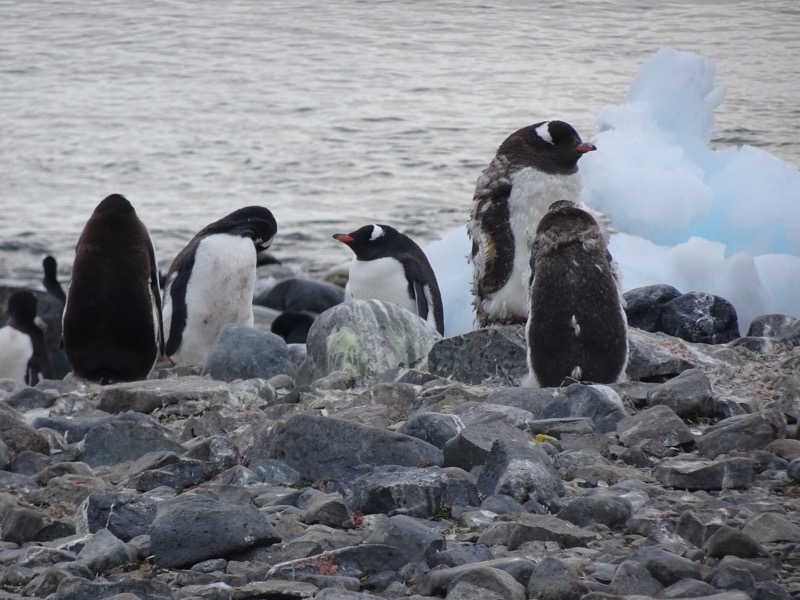
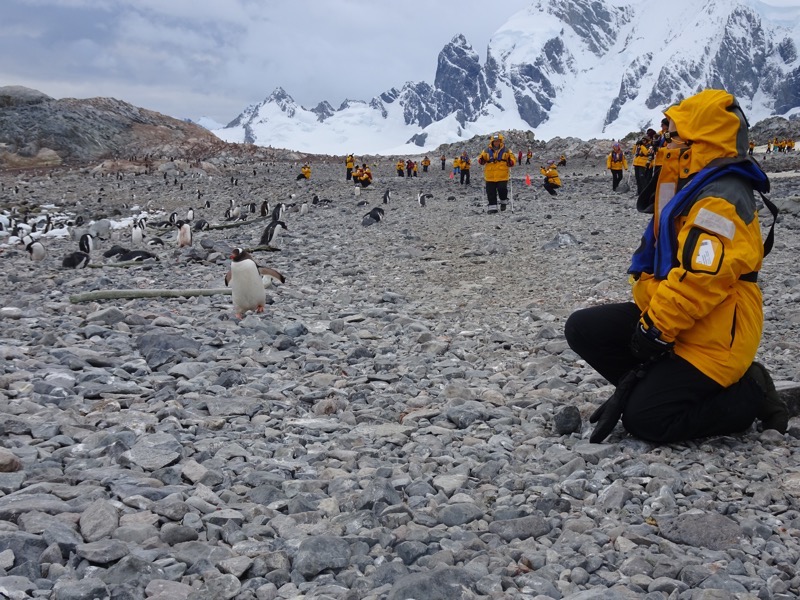
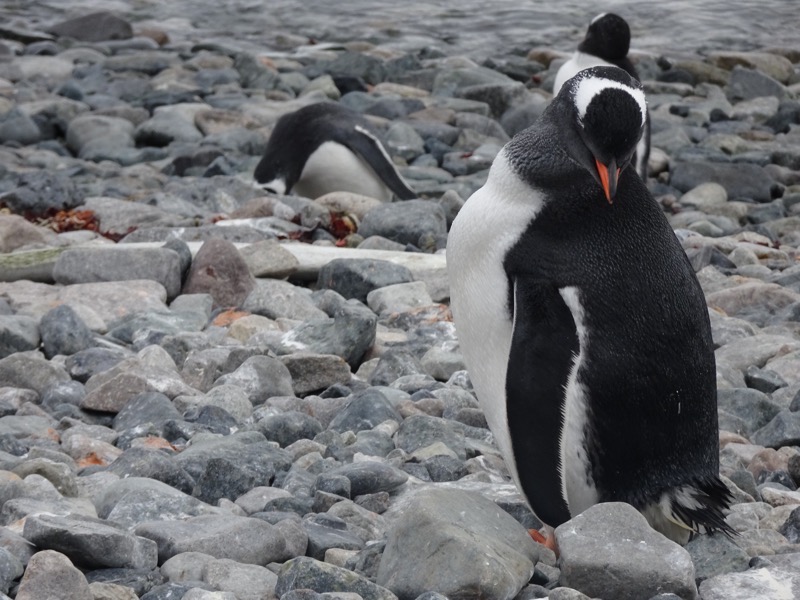 While we were here I took an opportunity to fly some colours for Lochac – I had hastily arranged to borrow a banner as I was packing to leave Brisbane and thankfully remembered to take it ashore… for Lochac and for Ynys Fawr!
While we were here I took an opportunity to fly some colours for Lochac – I had hastily arranged to borrow a banner as I was packing to leave Brisbane and thankfully remembered to take it ashore… for Lochac and for Ynys Fawr! 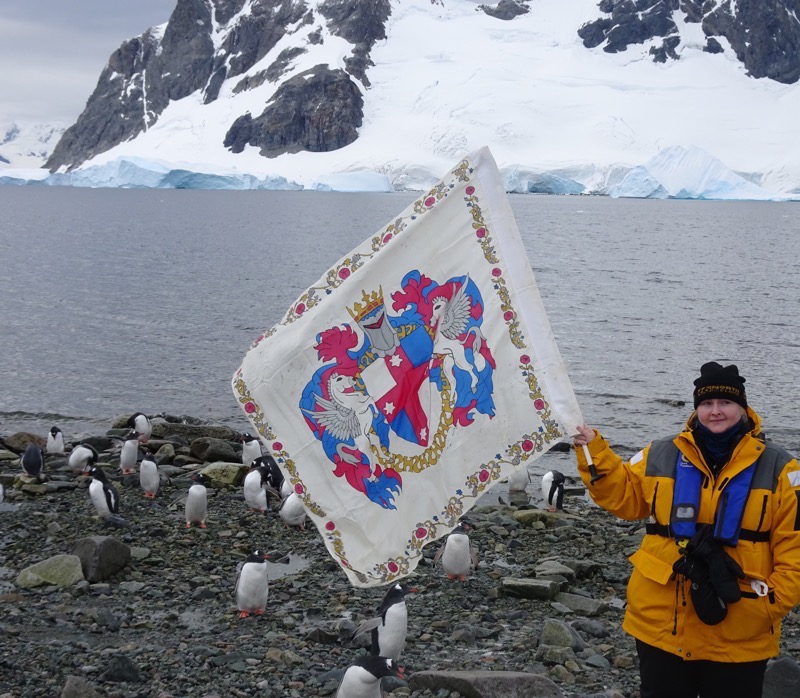
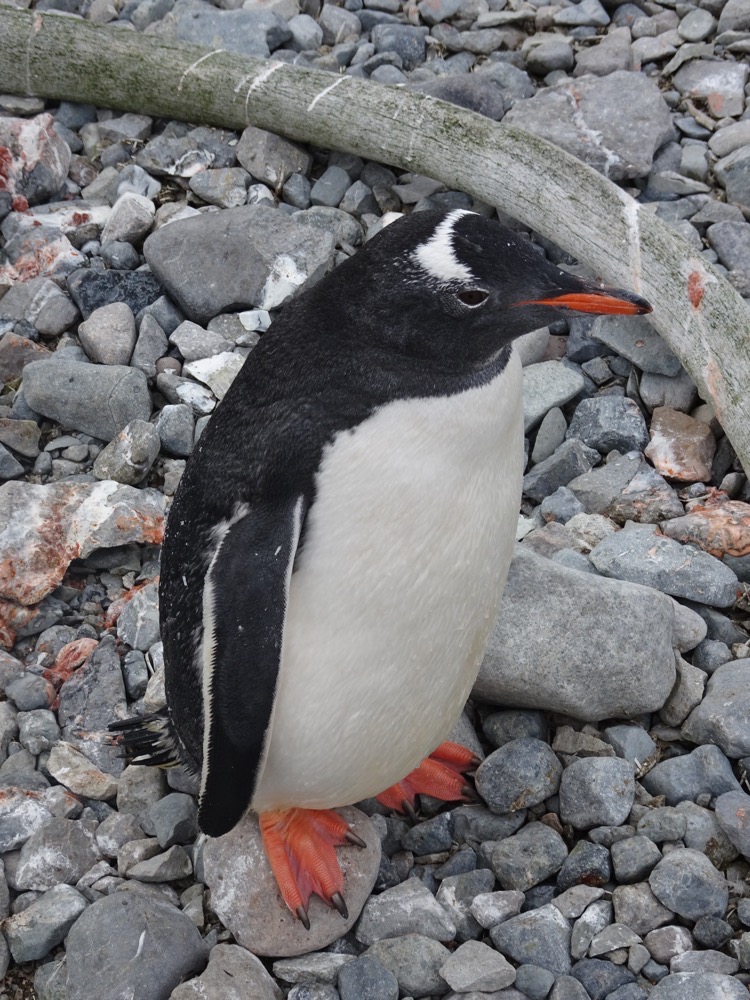
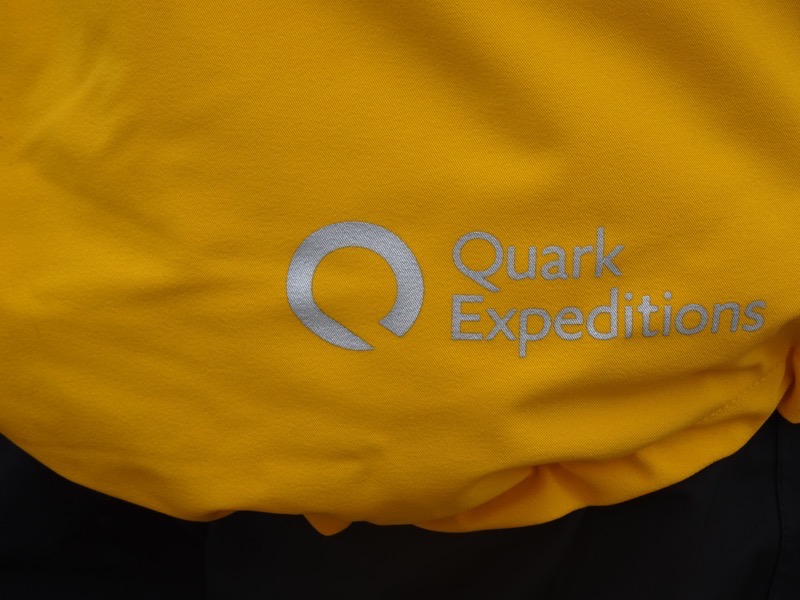 Cuverville Island in Paradise Bay is absolutely beautiful
Cuverville Island in Paradise Bay is absolutely beautiful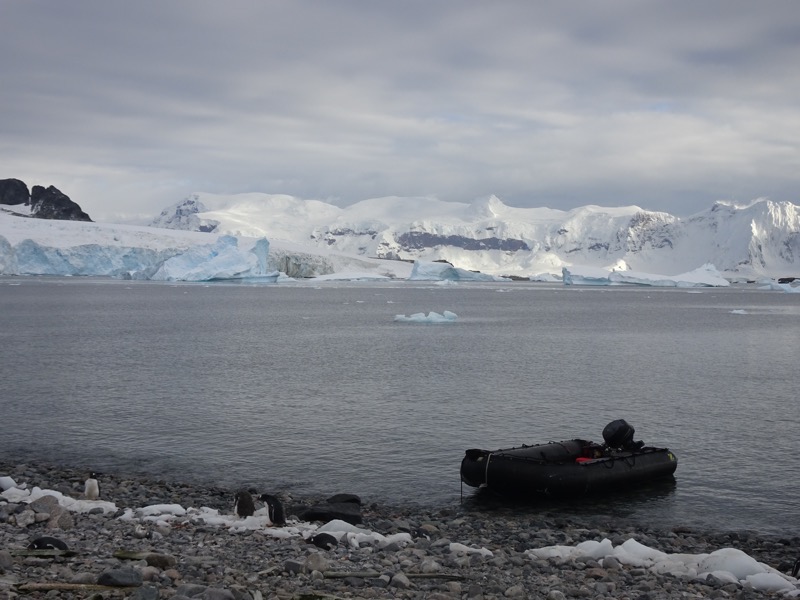

 Photo by Leanne of her, ‘Penguin with Attitude’… he kept pecking at her boots.
Photo by Leanne of her, ‘Penguin with Attitude’… he kept pecking at her boots. Norm and Dany with some little friends in tow:
Norm and Dany with some little friends in tow: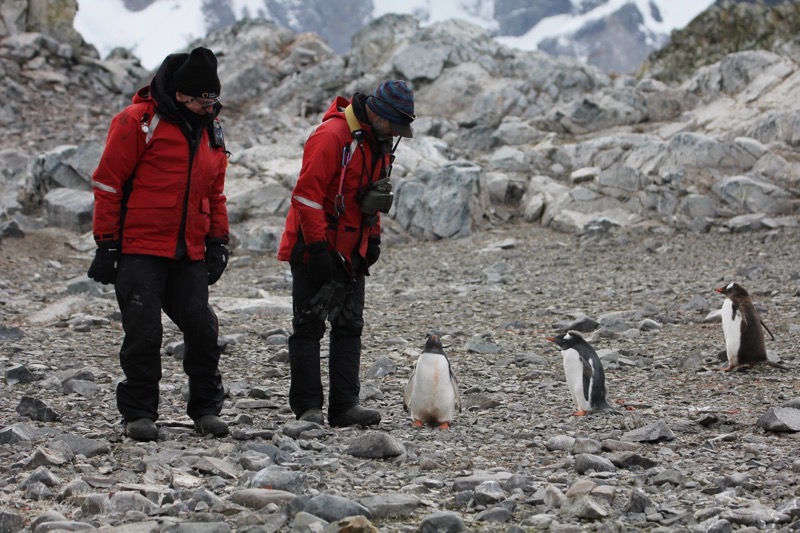 Photo by Leanne:
Photo by Leanne: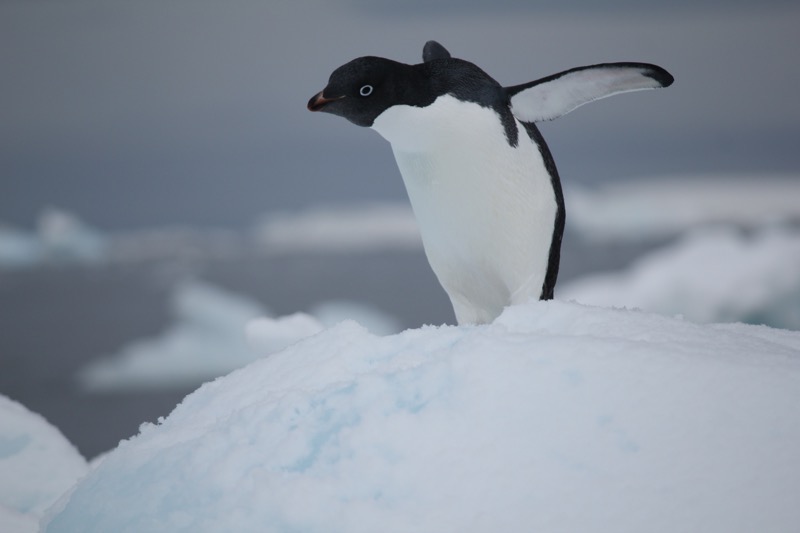 Photo of our friendly neighbourhood microbiologist, Ema. Taken by Pato:
Photo of our friendly neighbourhood microbiologist, Ema. Taken by Pato:
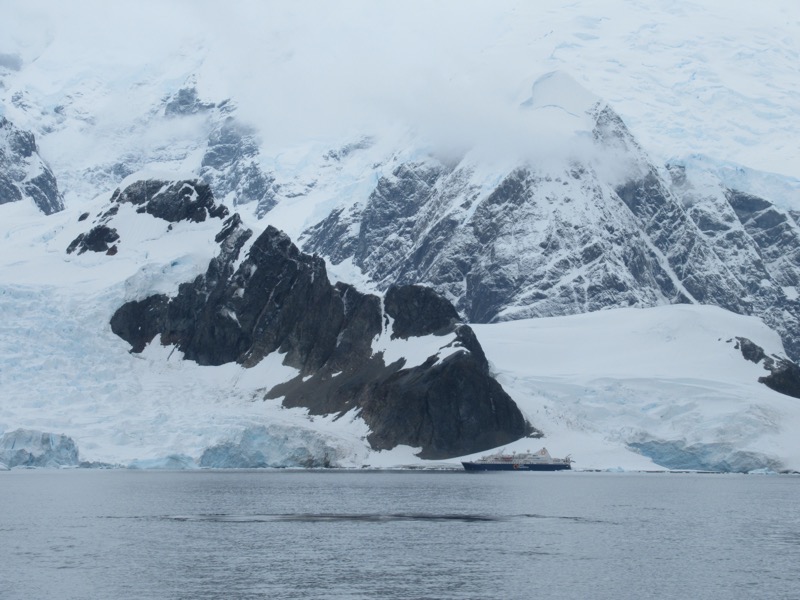 Some of the ‘rainforest’, photo by Tommy:
Some of the ‘rainforest’, photo by Tommy: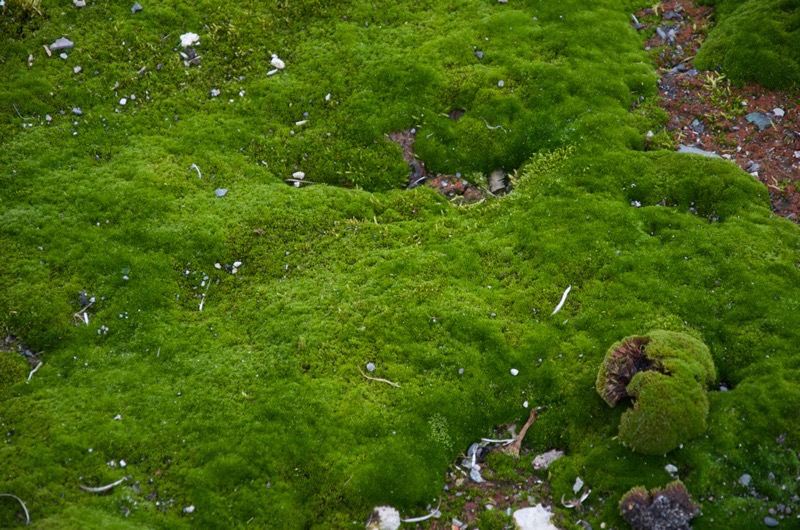

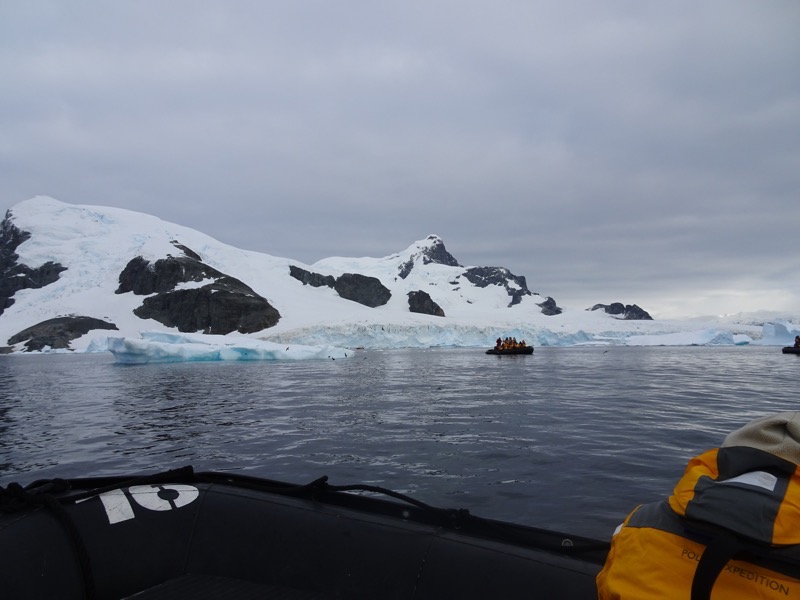 We tootled around the harbour for a bit but within moments came across the most unexpected and startling ‘David Attenborough Moment’… I had been talking to Trish just this morning about how cool it would be to see Orca hunting seals along a beach somewhere but wasn’t expecting to stumble onto leopard seals hunting the cute penguins that we had just been watching as they learned to swim. Leopard seals are opportunistic feeders, so they live on krill, fish, squid and small animals like fur seal pups and penguins. They have large canines which allow them to grab their prey but in the absence of ‘hands’, they resort to throwing and flailing their prey around in and out of the water, until chunks of flesh are ripped free so that they can then consume the smaller pieces. It was a bit gruesome to watch but absolutely fascinating.
We tootled around the harbour for a bit but within moments came across the most unexpected and startling ‘David Attenborough Moment’… I had been talking to Trish just this morning about how cool it would be to see Orca hunting seals along a beach somewhere but wasn’t expecting to stumble onto leopard seals hunting the cute penguins that we had just been watching as they learned to swim. Leopard seals are opportunistic feeders, so they live on krill, fish, squid and small animals like fur seal pups and penguins. They have large canines which allow them to grab their prey but in the absence of ‘hands’, they resort to throwing and flailing their prey around in and out of the water, until chunks of flesh are ripped free so that they can then consume the smaller pieces. It was a bit gruesome to watch but absolutely fascinating.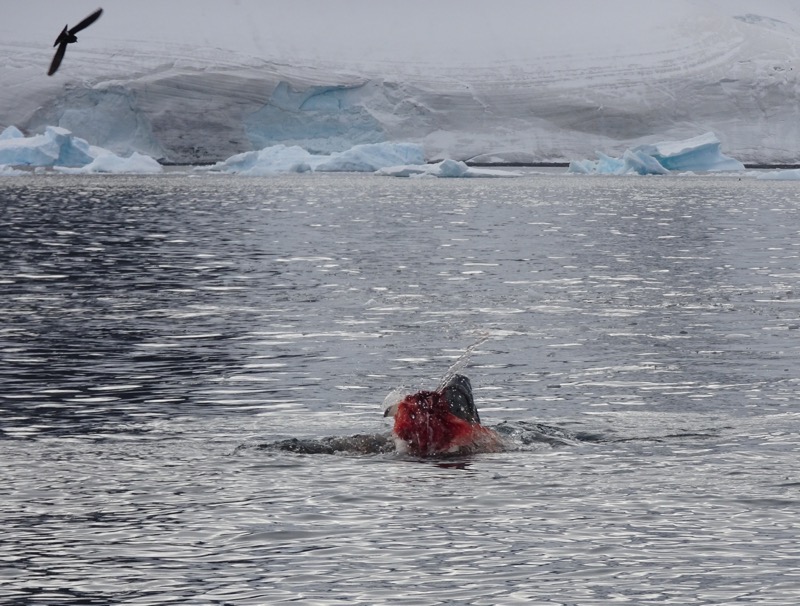
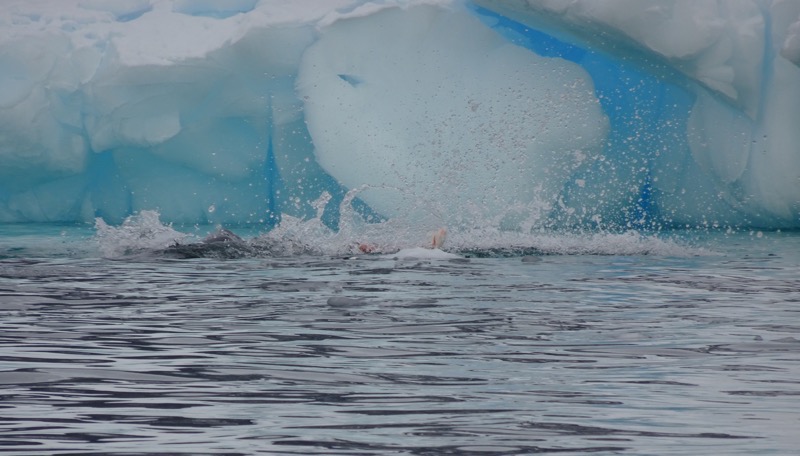
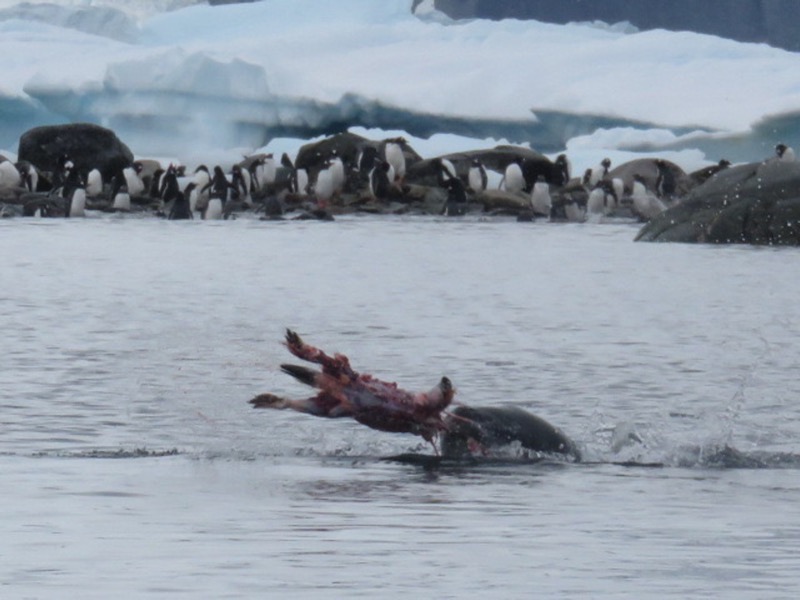 Photo by Arthur:
Photo by Arthur: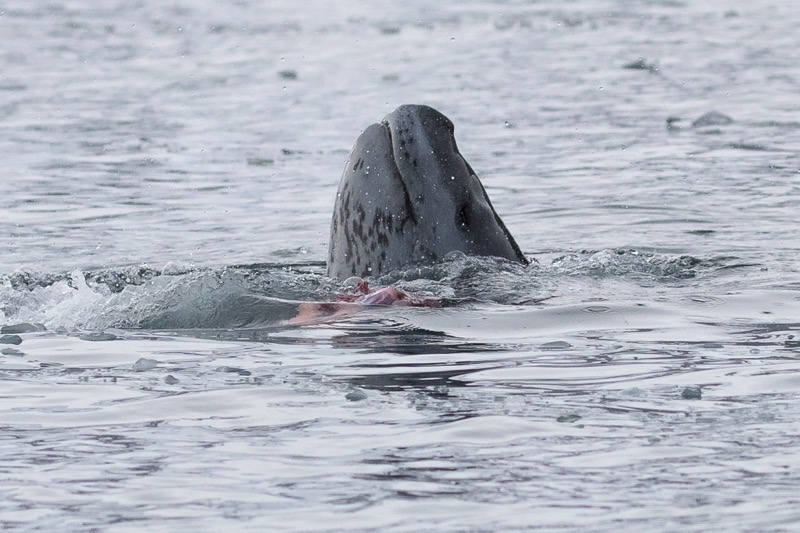 Three Photos by Scotty:
Three Photos by Scotty: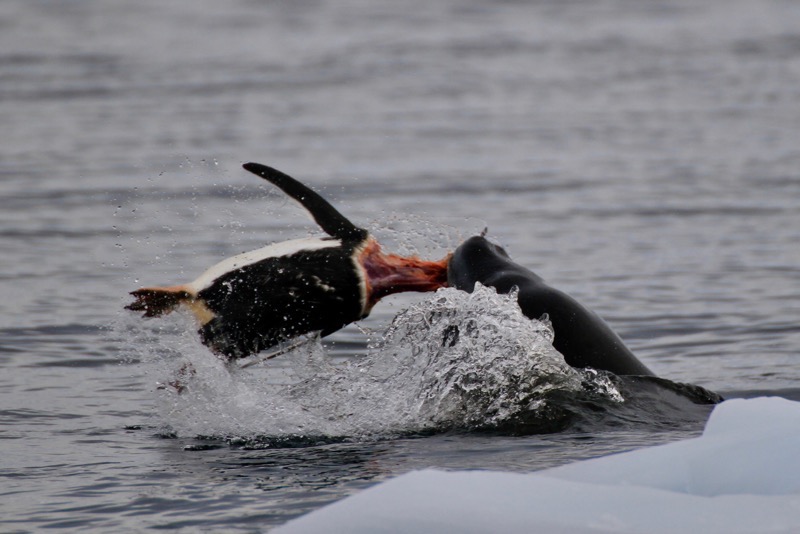
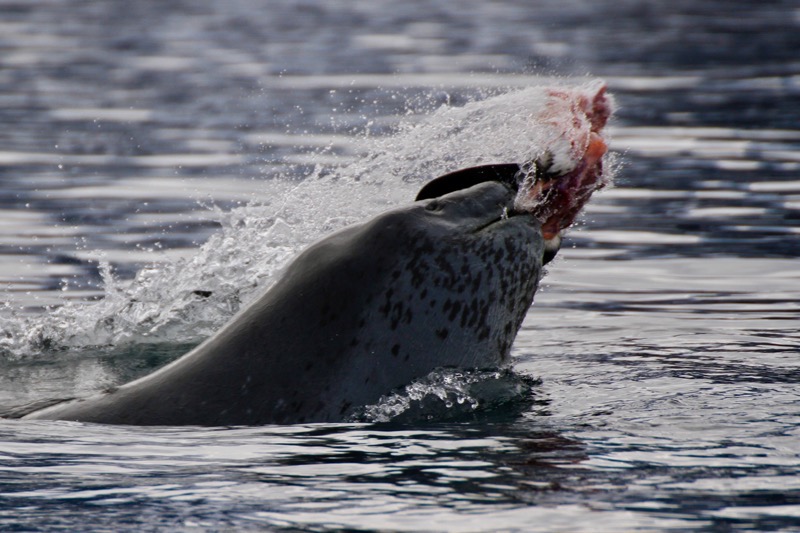
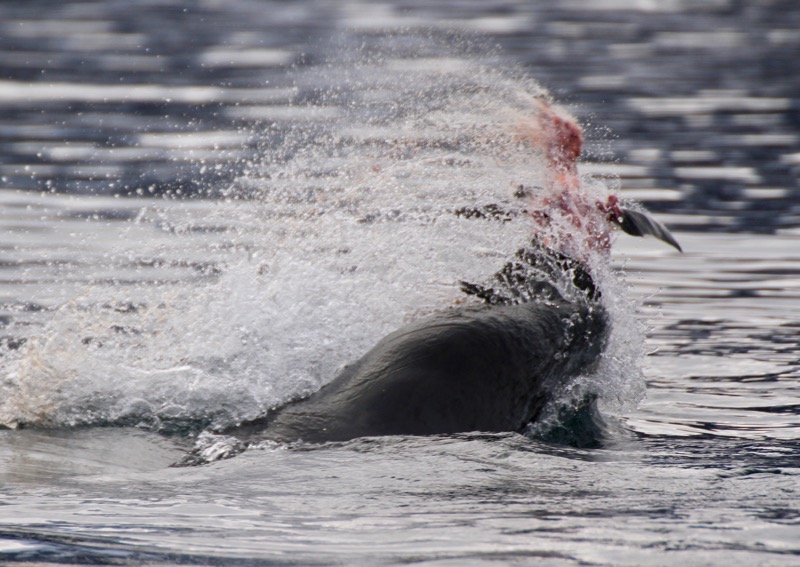
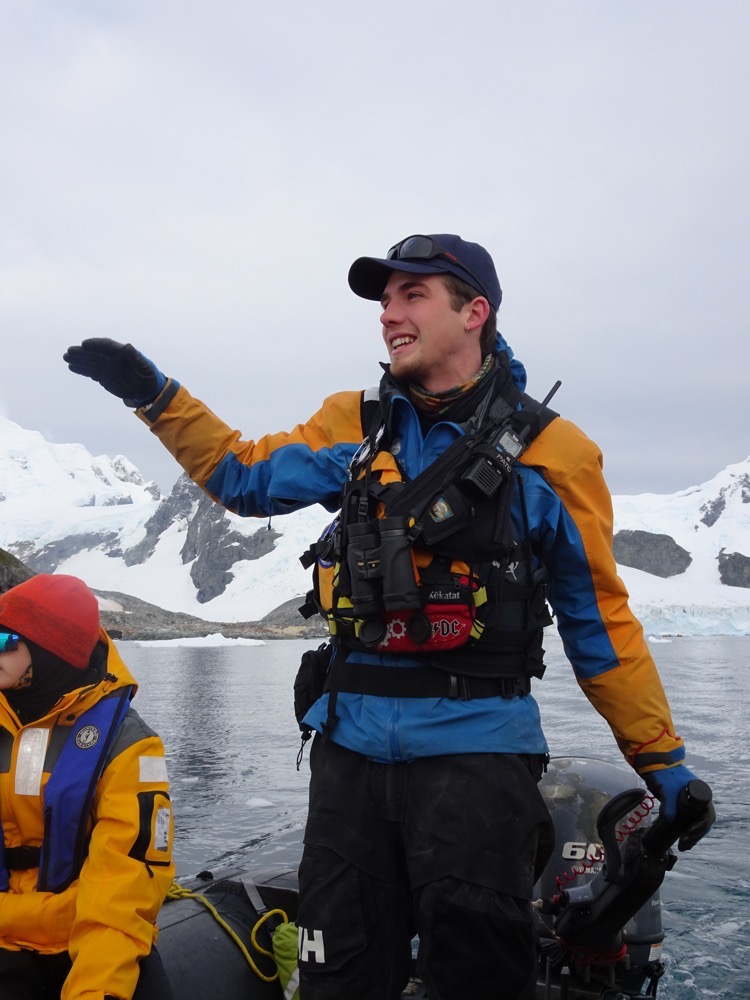

 We saw some whales this morning – but they were mostly ‘logging’… which is basically sleeping. Whales do the unihemispherical sleeping thing too, so they float along, with half their brain asleep just staying afloat and breathing. They came very close to our zodiac but they were not very active.
We saw some whales this morning – but they were mostly ‘logging’… which is basically sleeping. Whales do the unihemispherical sleeping thing too, so they float along, with half their brain asleep just staying afloat and breathing. They came very close to our zodiac but they were not very active.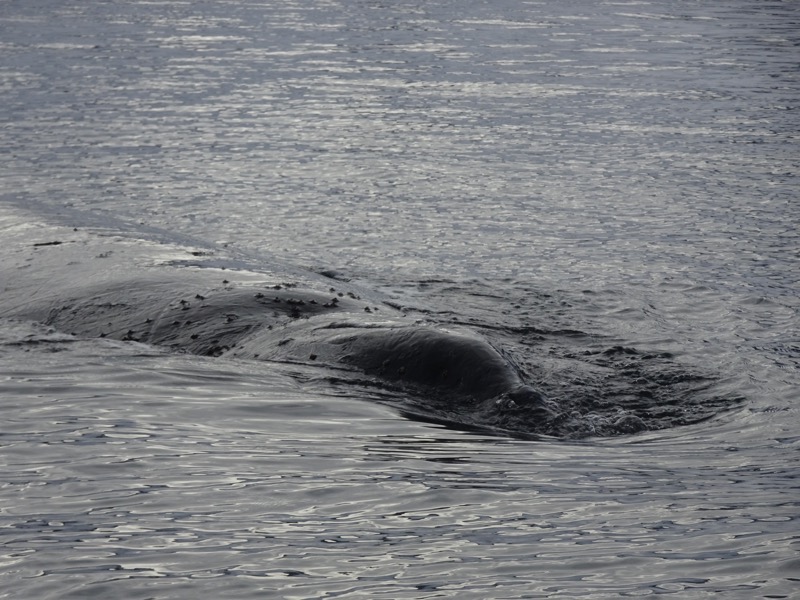
 I can’t get over the colour of the water and the ice… it’s just gorgeous.
I can’t get over the colour of the water and the ice… it’s just gorgeous.
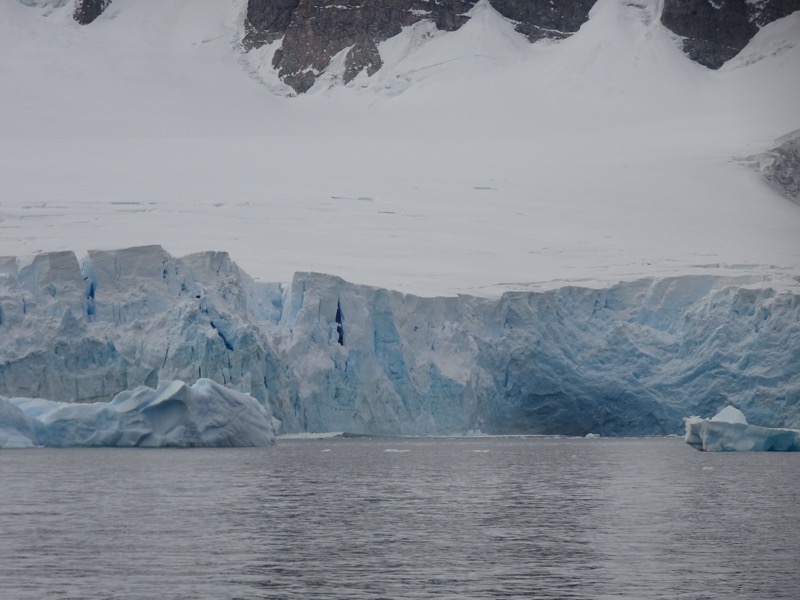
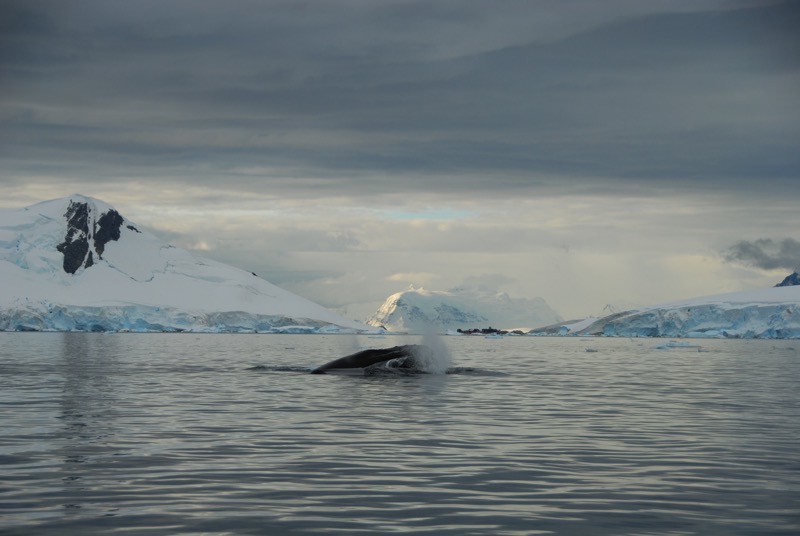
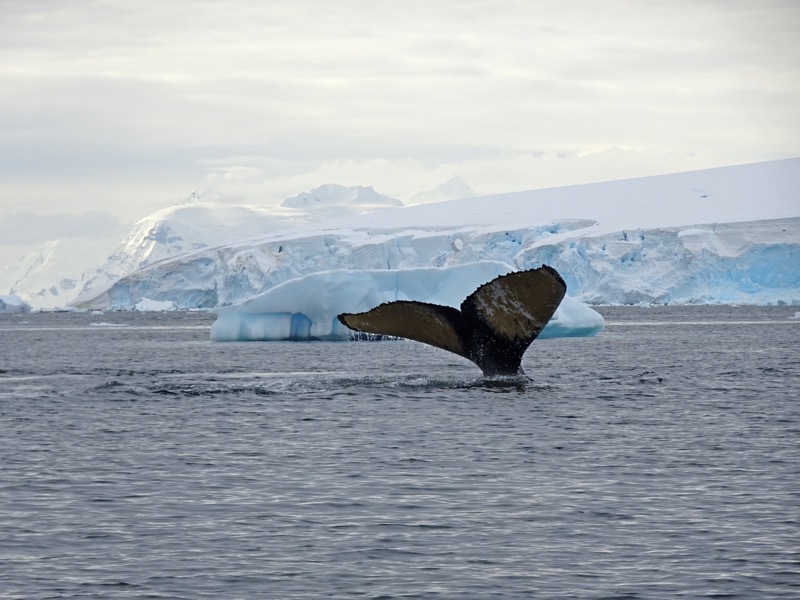
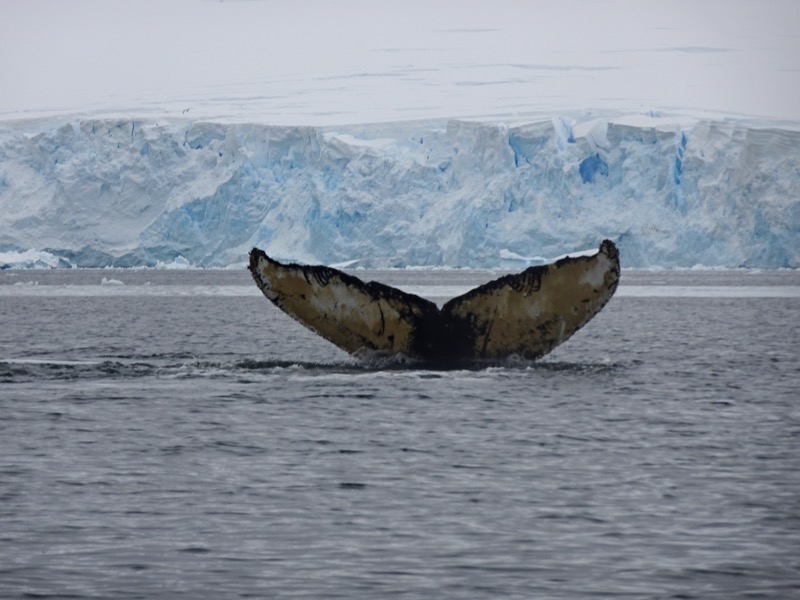
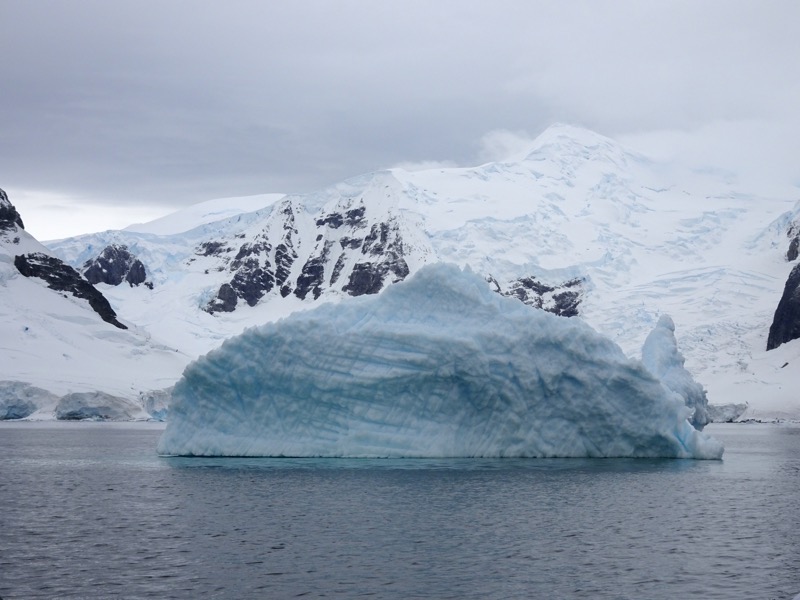
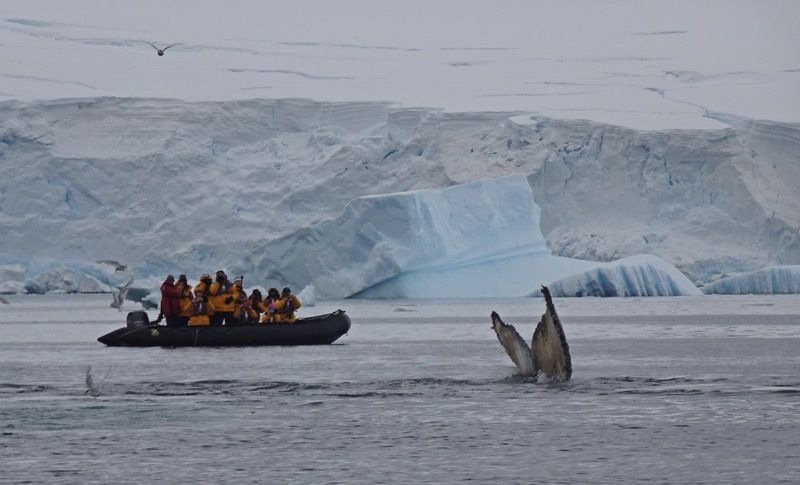
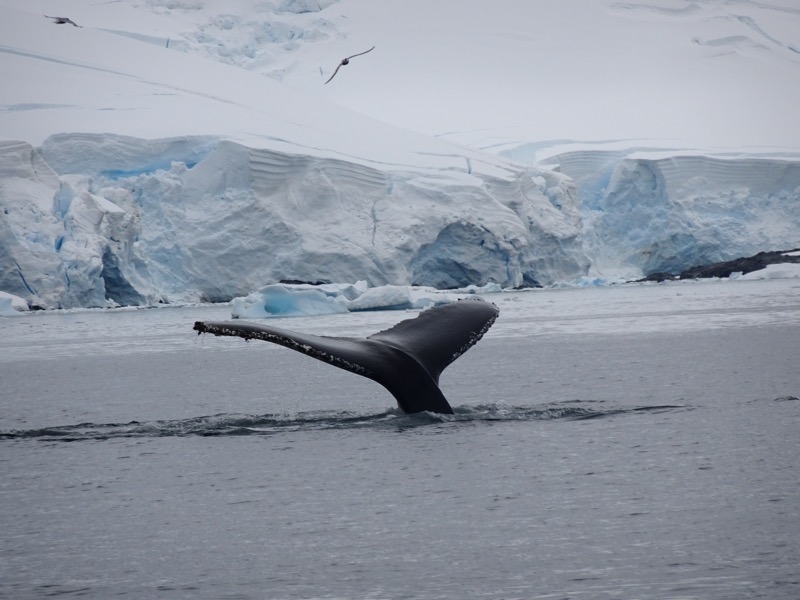
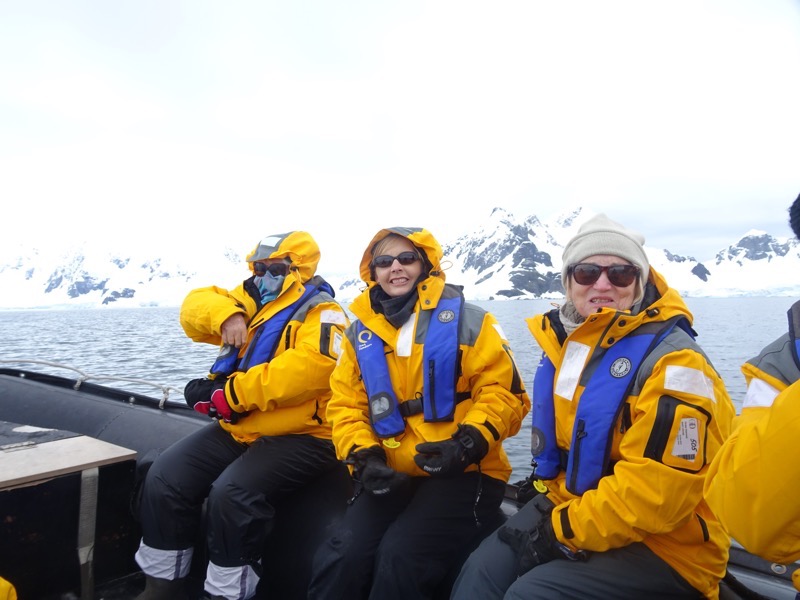
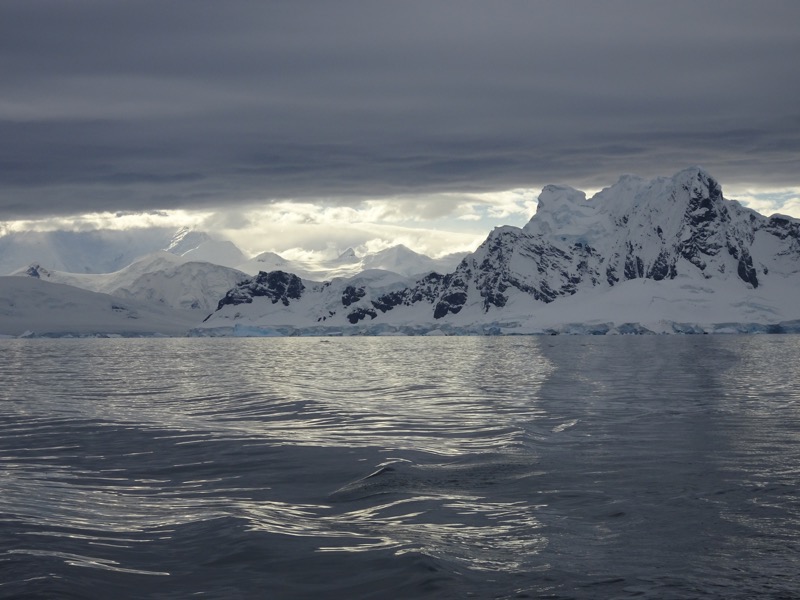 One of the things I have enjoyed most about whale watching here is the silence and awe they evoke when we encounter these enormous gentle creatures – and then the sounds that reverberate through their gigantic bodies when they breathe or move around in the water. They are truly magnificent and I tried to take a short video to capture these deep resonant sounds…
One of the things I have enjoyed most about whale watching here is the silence and awe they evoke when we encounter these enormous gentle creatures – and then the sounds that reverberate through their gigantic bodies when they breathe or move around in the water. They are truly magnificent and I tried to take a short video to capture these deep resonant sounds… We were all busy watching the whales diving and getting those beautiful tail shots as they curved their bodies and plunged beneath the water when Jean snapped this pick inside the jaws of a humpback – you can see the baleen tendrils that they use to sieve krill when gulp feeding and the soft pink of their upper palate.
We were all busy watching the whales diving and getting those beautiful tail shots as they curved their bodies and plunged beneath the water when Jean snapped this pick inside the jaws of a humpback – you can see the baleen tendrils that they use to sieve krill when gulp feeding and the soft pink of their upper palate.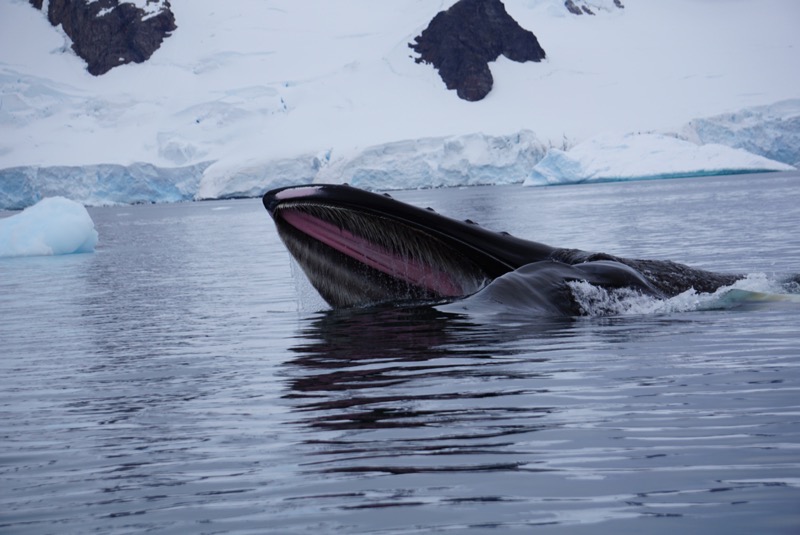
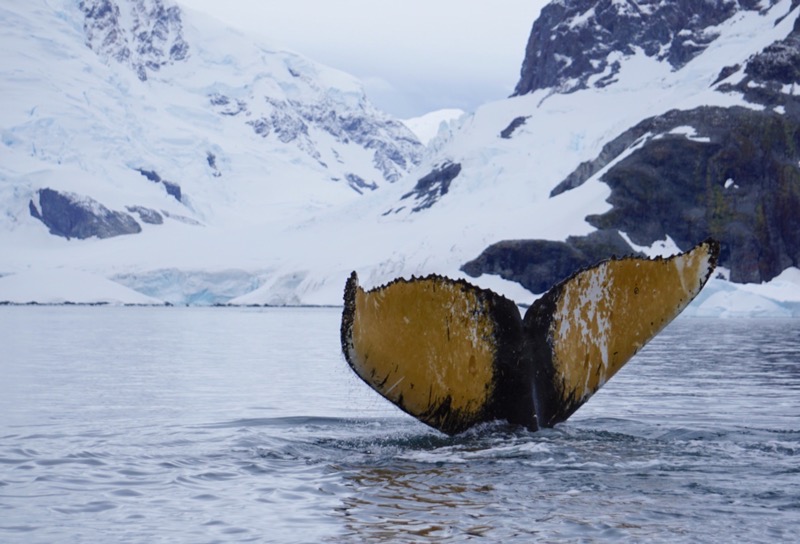
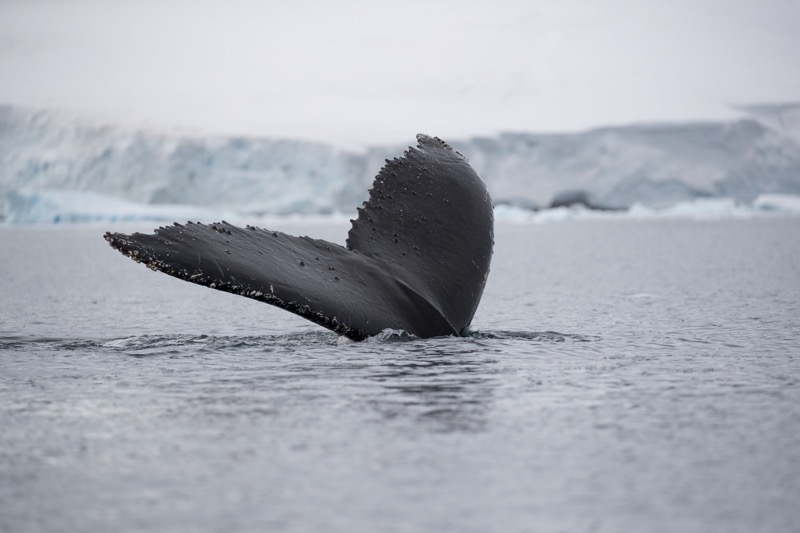 We were all watching these whales as though our heads were on swivels, there were so many of them, and they seemed to be in every direction, and so close to our zodiacs… Finally, one of them breached and we all gasped and held our collective breaths. It was magnificent to see such a huge and majestic animal throwing itself out of the water – and from what scientists can tell, they do it for no other reason than the joy of it. I was too astonished to raise my camera, but thankfully others did… Photo by Chris Moon:
We were all watching these whales as though our heads were on swivels, there were so many of them, and they seemed to be in every direction, and so close to our zodiacs… Finally, one of them breached and we all gasped and held our collective breaths. It was magnificent to see such a huge and majestic animal throwing itself out of the water – and from what scientists can tell, they do it for no other reason than the joy of it. I was too astonished to raise my camera, but thankfully others did… Photo by Chris Moon: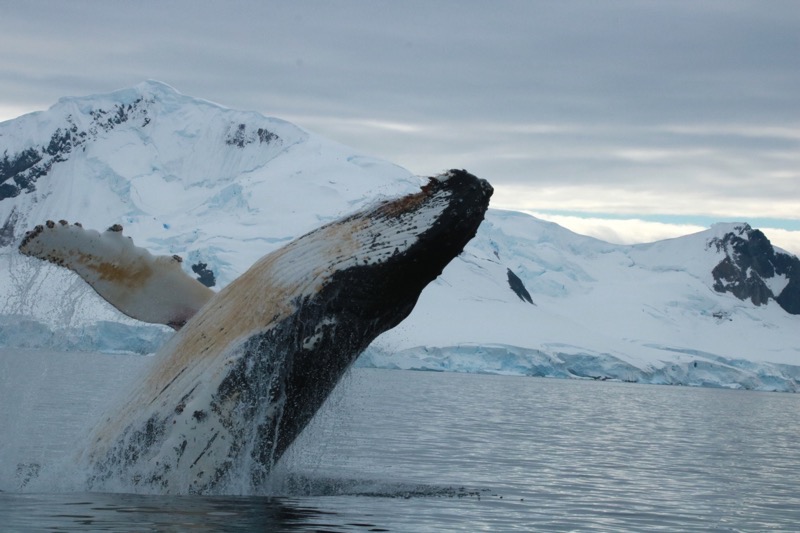
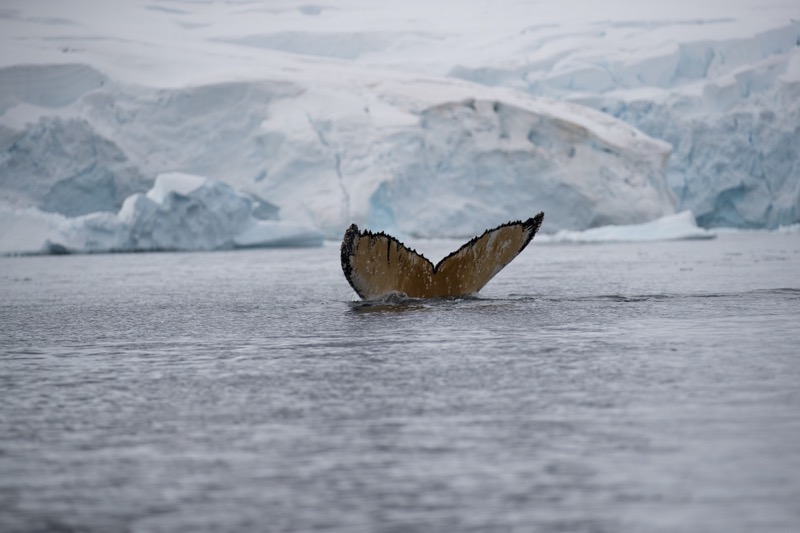 Three photos taken in Paradise Harbour by Pato:
Three photos taken in Paradise Harbour by Pato:
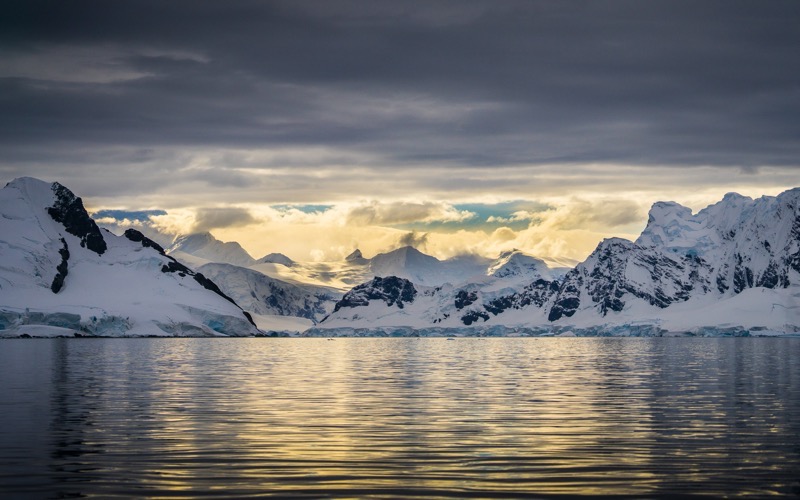
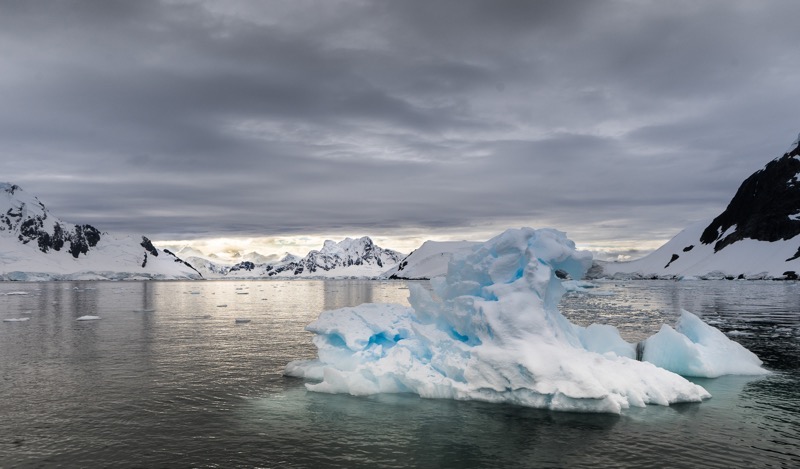
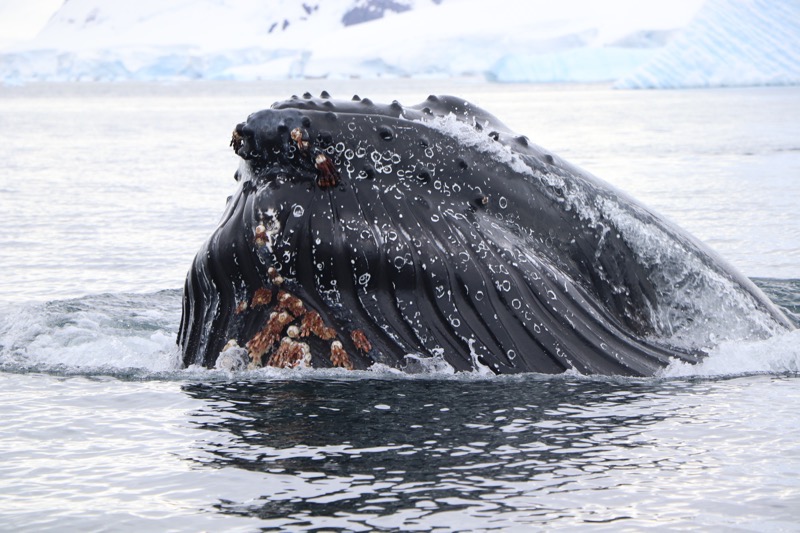
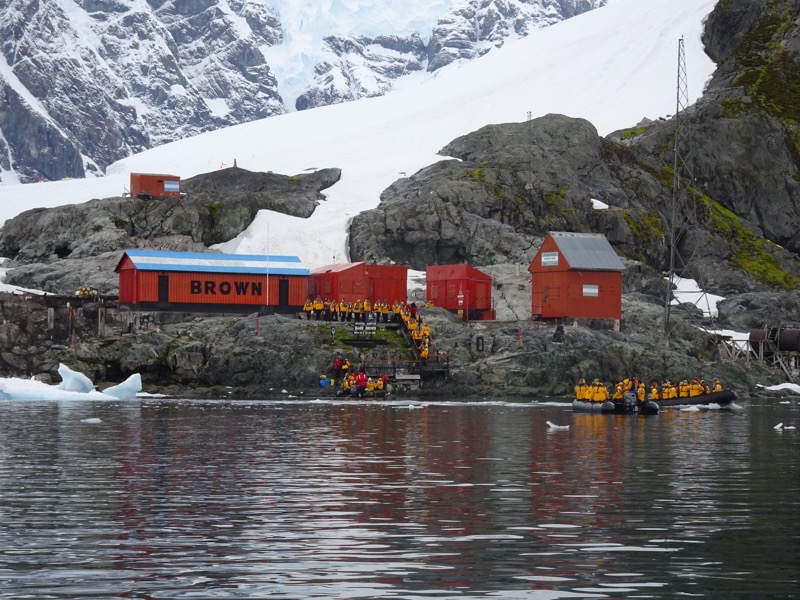

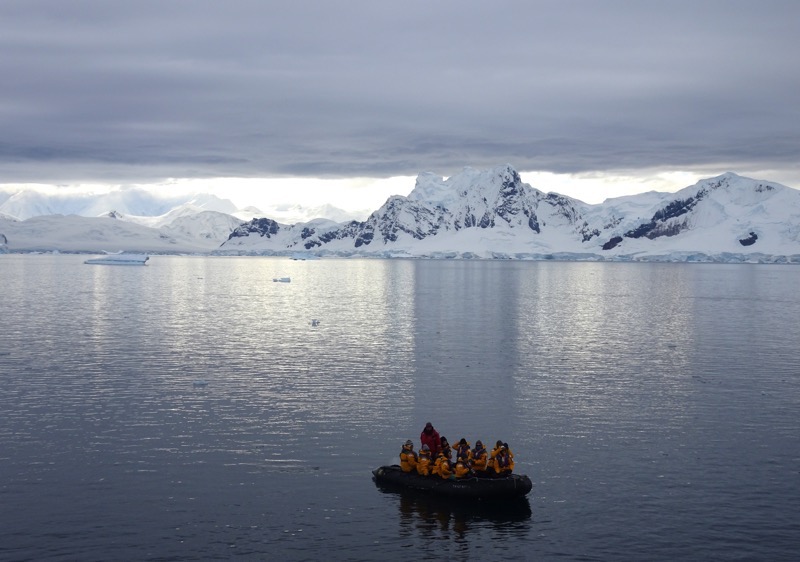
 We were walking through the snow and talking about snow angels – as you do when you are Australian and you’re not accustomed to seeing a lot of snow – and it turns out Trish had never made a snow angel before. I had, in Switzerland with BluddyMary back in ’95, and Mum had I think she said in Nepal around that time… so that meant it was Trisha’s turn – and you know if you are going to make a snow angel for the first time, why not Antarctica?! 🙂
We were walking through the snow and talking about snow angels – as you do when you are Australian and you’re not accustomed to seeing a lot of snow – and it turns out Trish had never made a snow angel before. I had, in Switzerland with BluddyMary back in ’95, and Mum had I think she said in Nepal around that time… so that meant it was Trisha’s turn – and you know if you are going to make a snow angel for the first time, why not Antarctica?! 🙂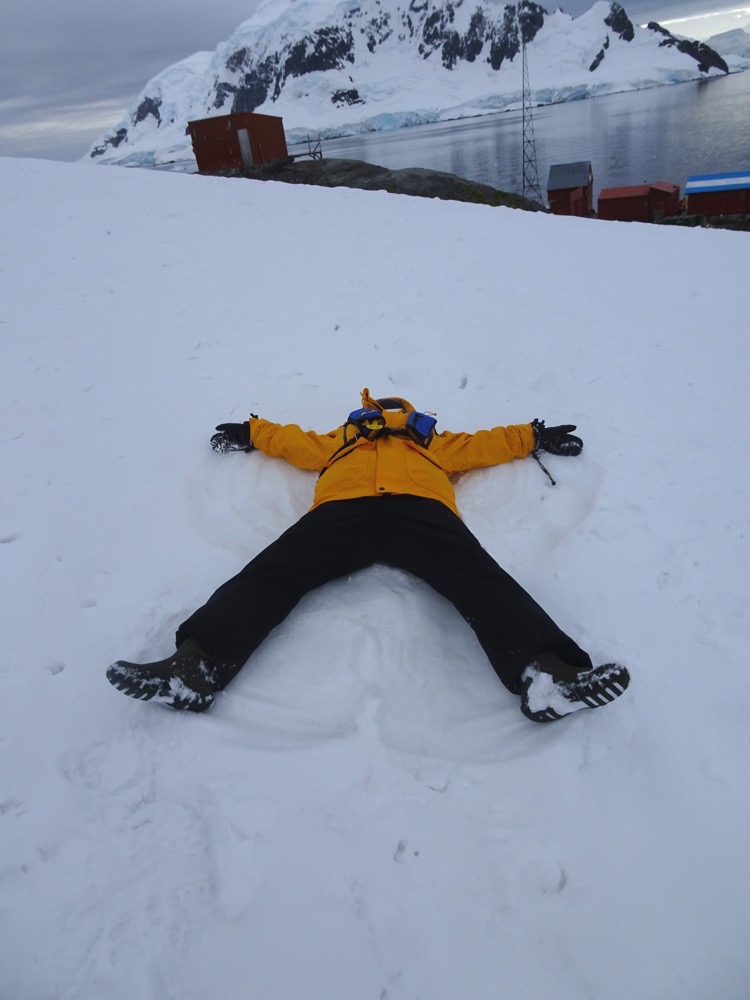 We got to the top of the lookout and it was a positively stunning view down to the harbour. The water is so calm and was offering beautiful reflections. We are hoping for some clearer weather over the coming days, but I have to say that for photography, this cool, moody and ‘romantic’ light is wonderful.
We got to the top of the lookout and it was a positively stunning view down to the harbour. The water is so calm and was offering beautiful reflections. We are hoping for some clearer weather over the coming days, but I have to say that for photography, this cool, moody and ‘romantic’ light is wonderful.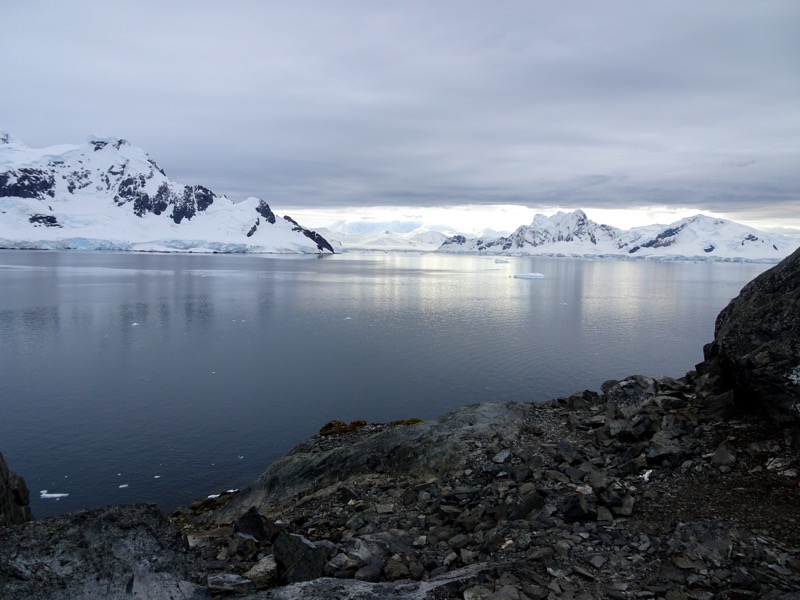
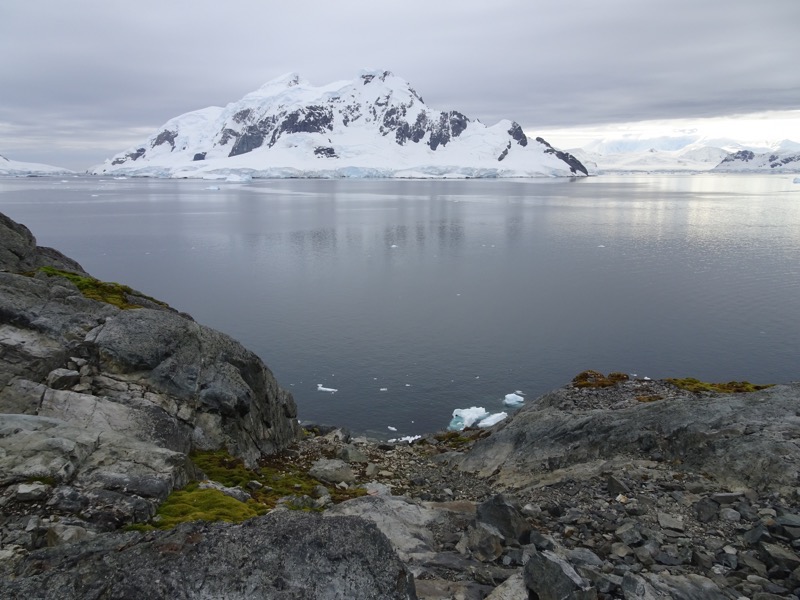
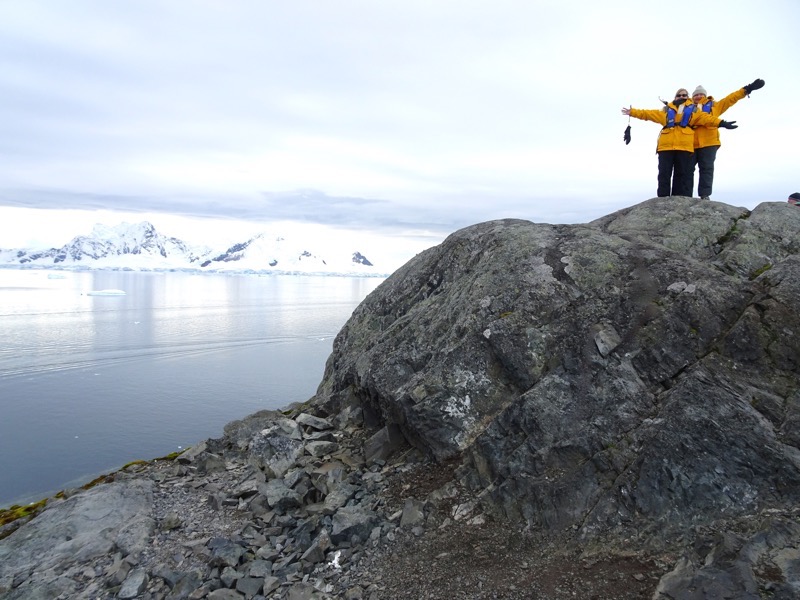
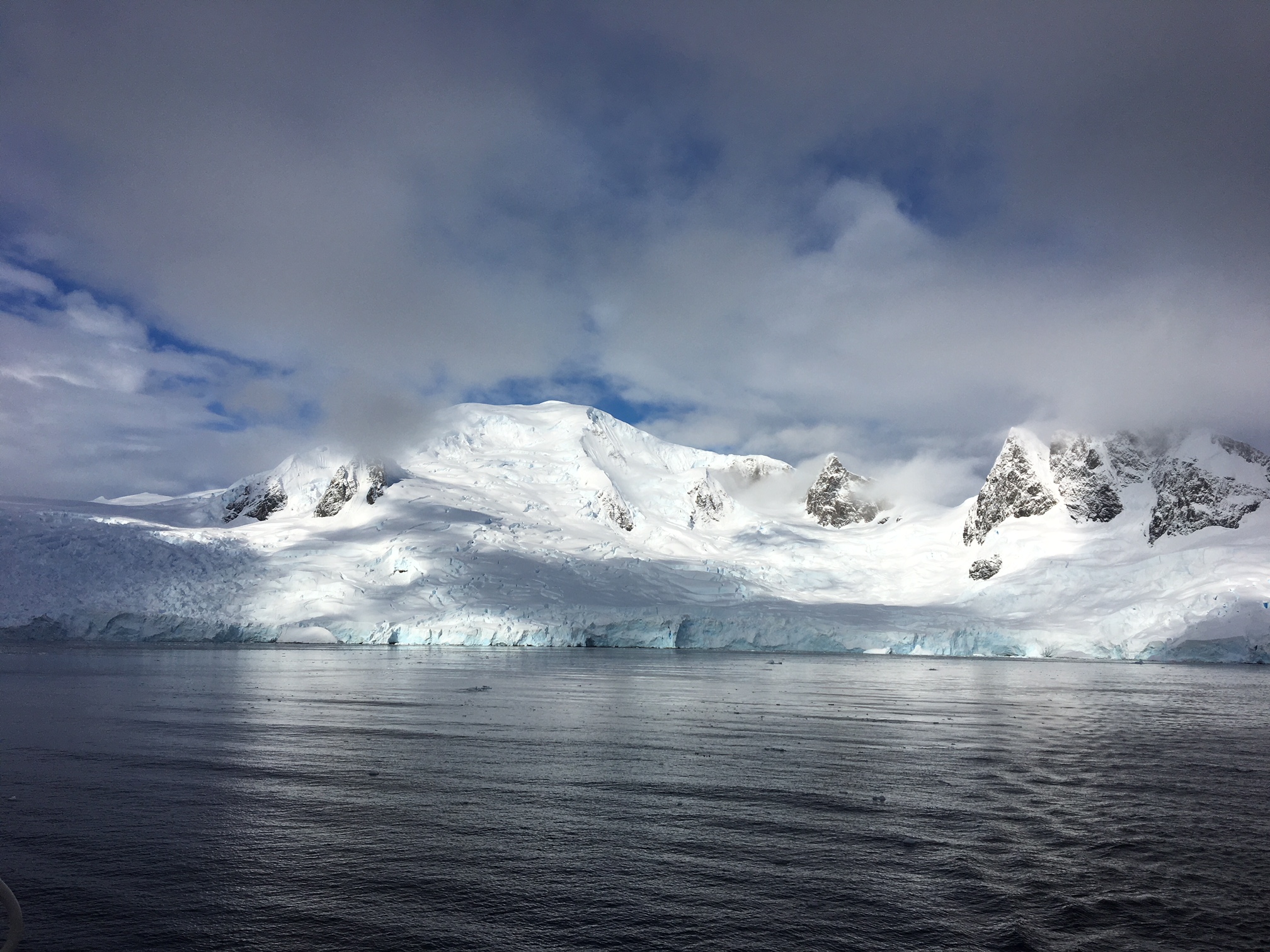
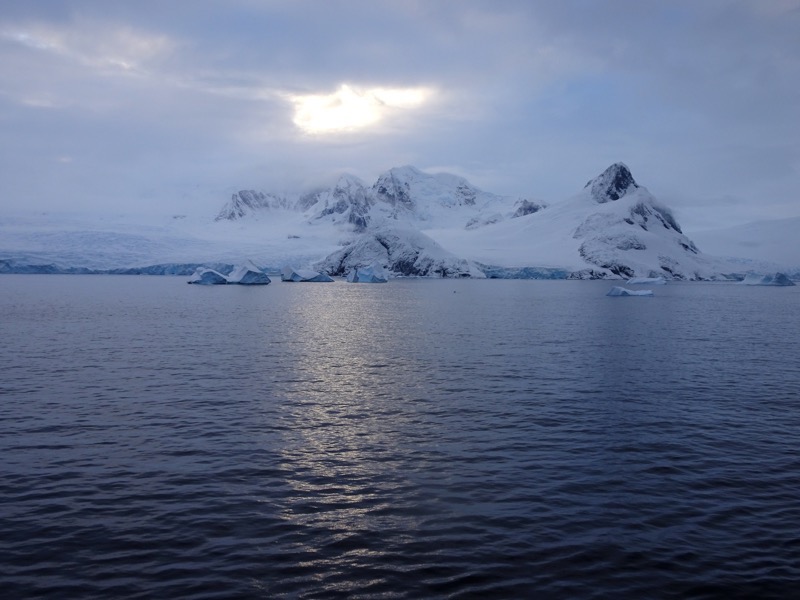


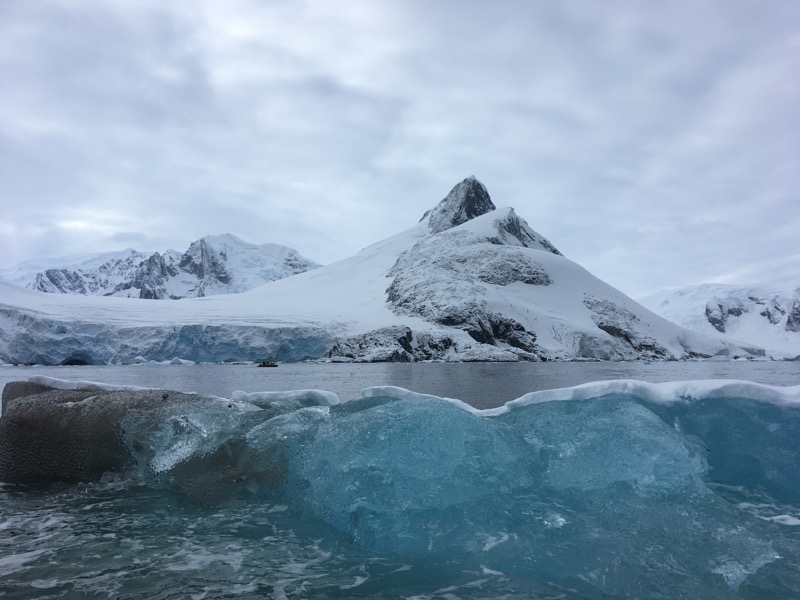

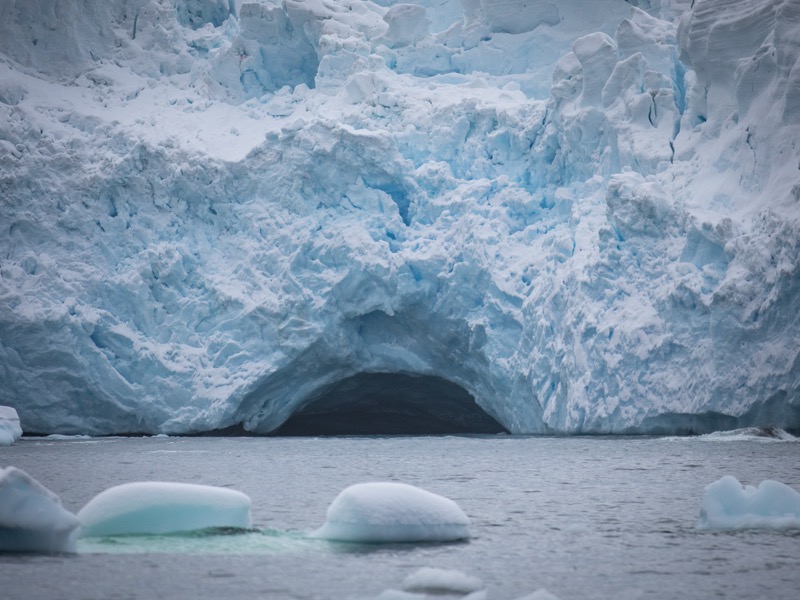
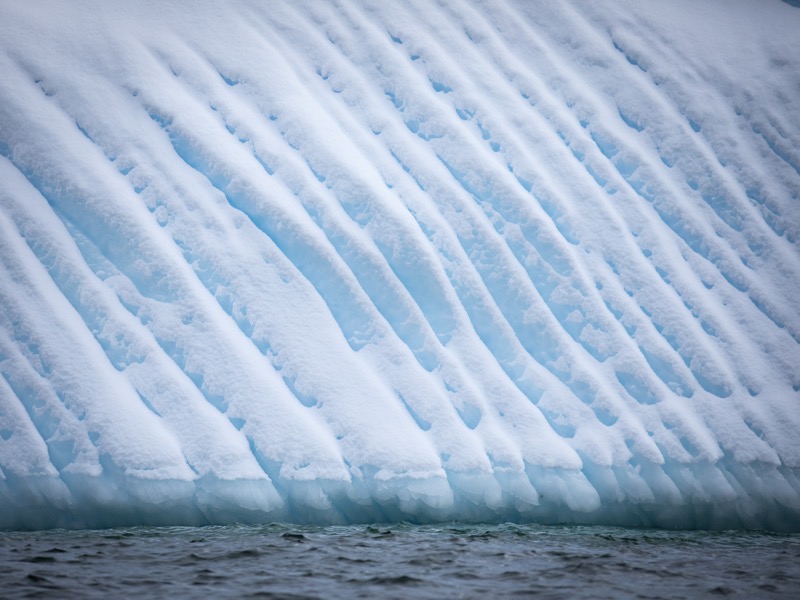 Photo by Pato:
Photo by Pato:
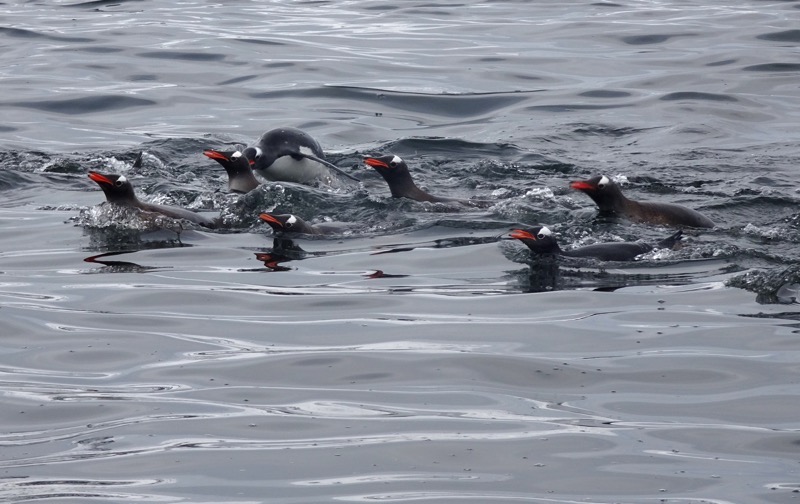 A seal floating on a small iceberg in the brash icefield.
A seal floating on a small iceberg in the brash icefield.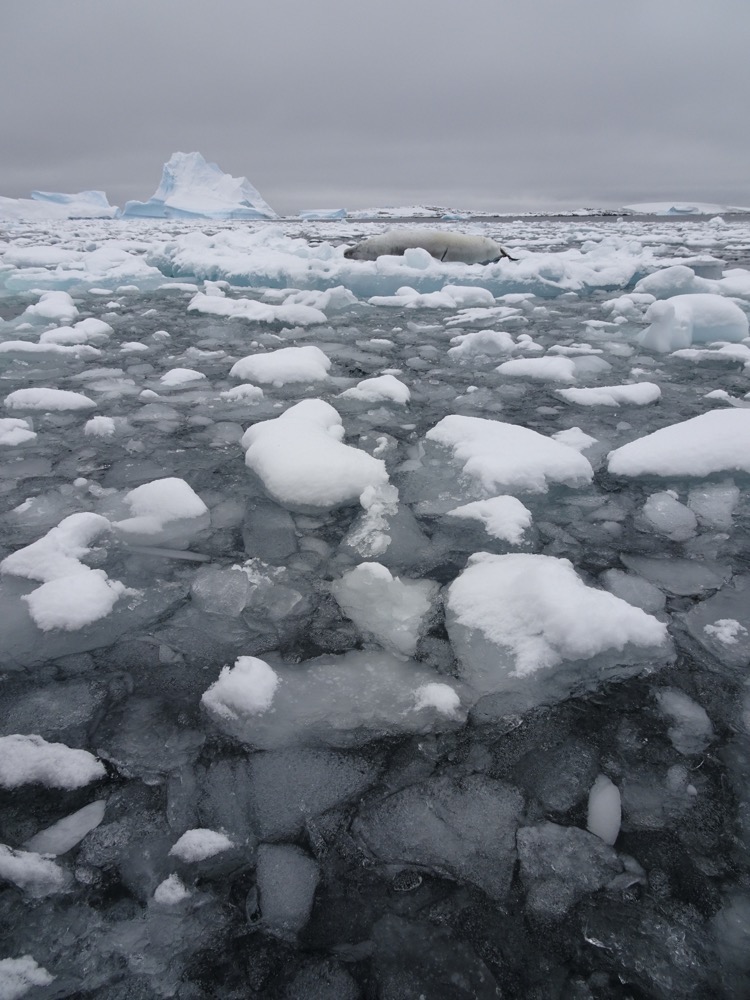 Brash ice beside the zodiac.
Brash ice beside the zodiac.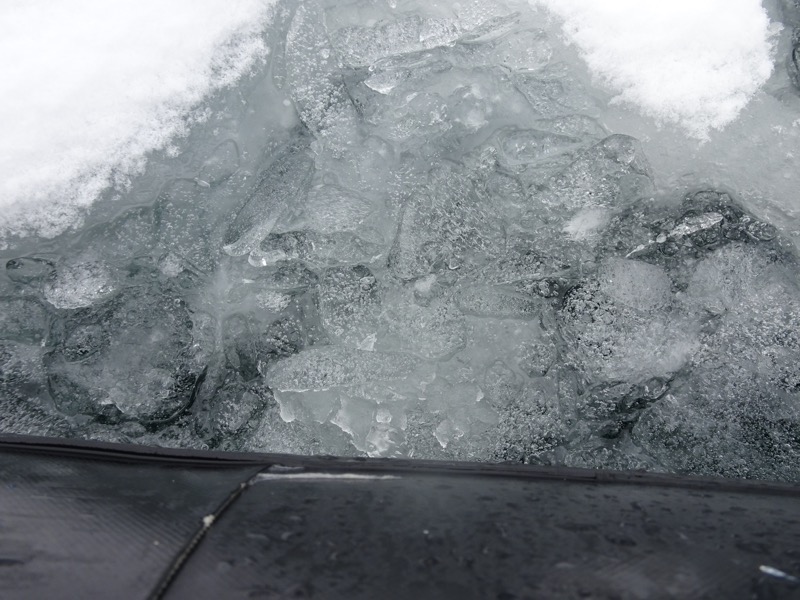 Jean, our Adelie expert guiding out zodiac today.
Jean, our Adelie expert guiding out zodiac today.
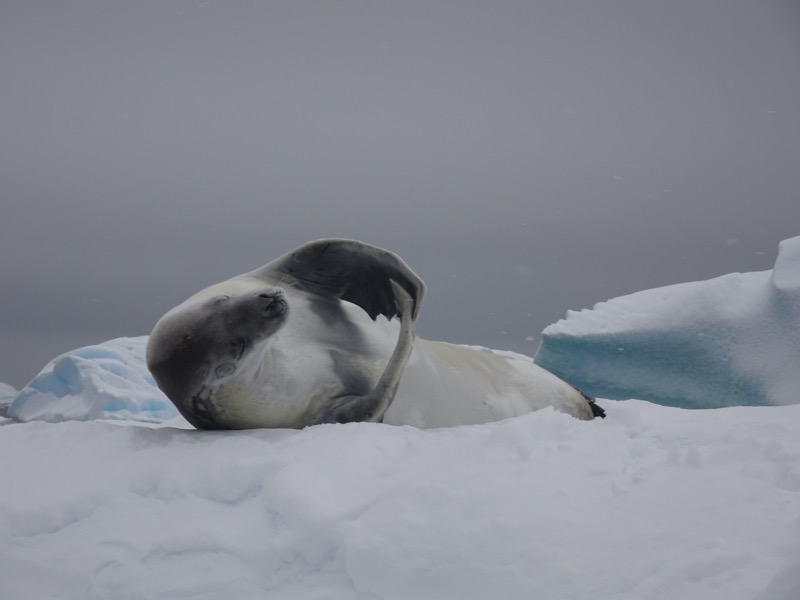

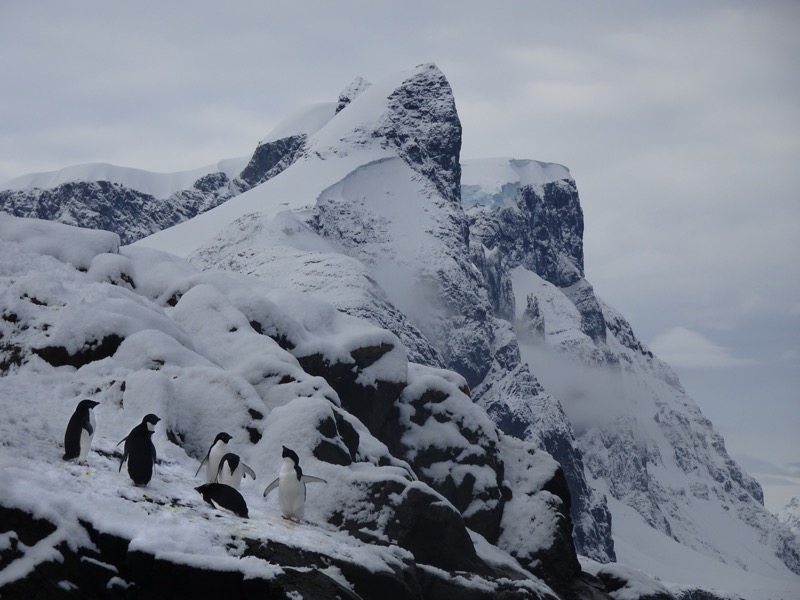 Photo by Pato:
Photo by Pato: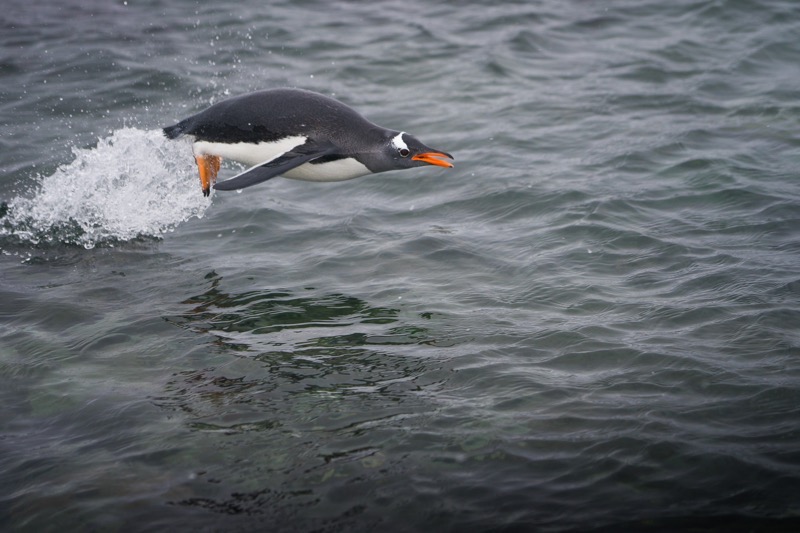
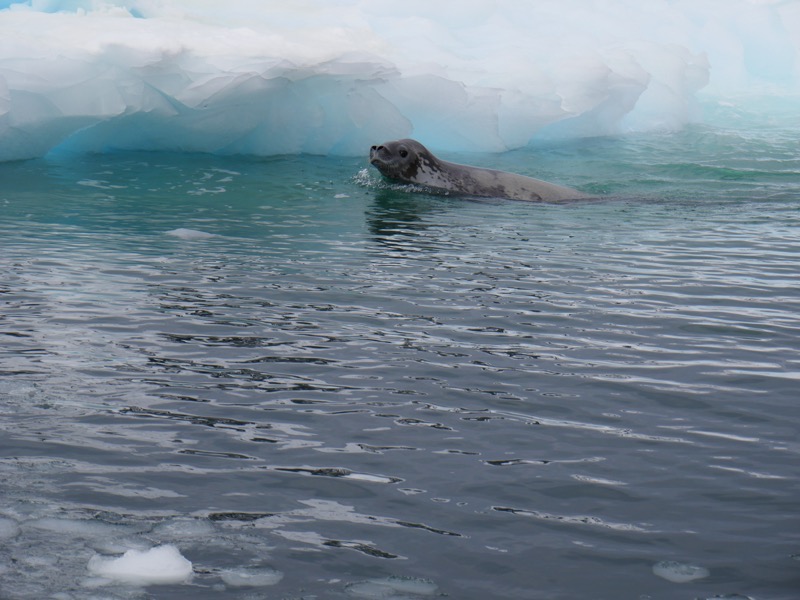 Photo by Linda:
Photo by Linda: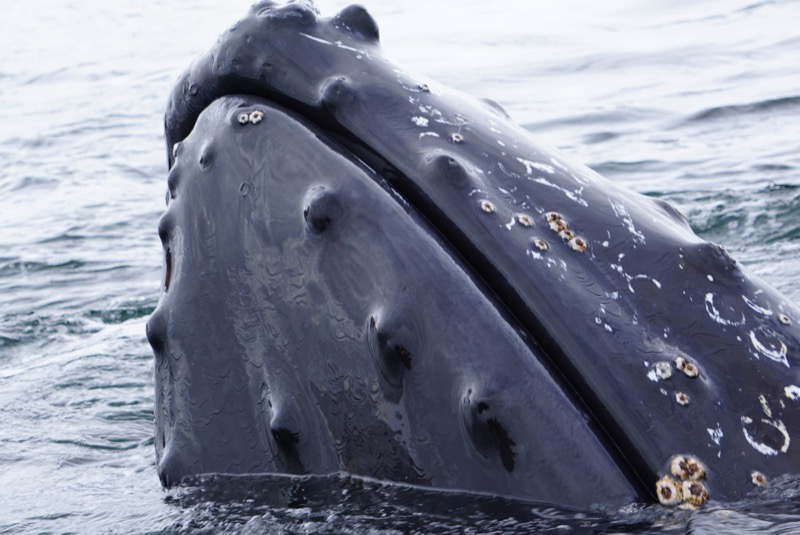 Photo by Barry:
Photo by Barry: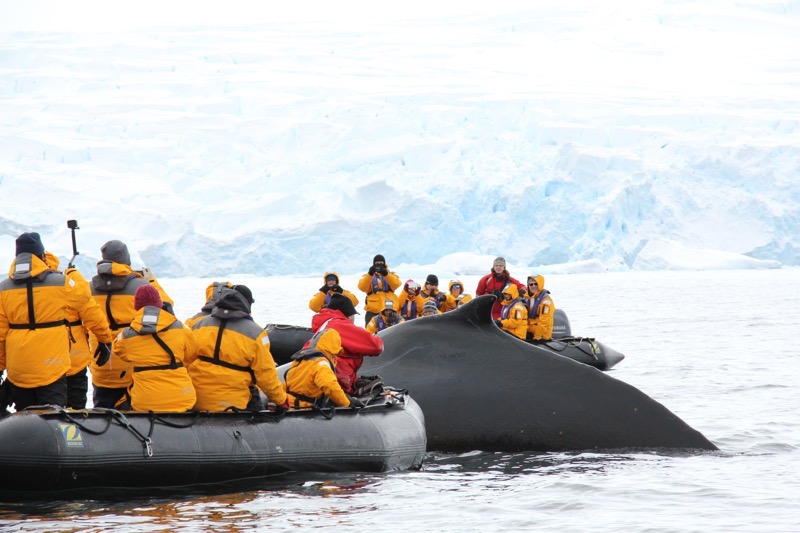 Photo by Arthur:
Photo by Arthur: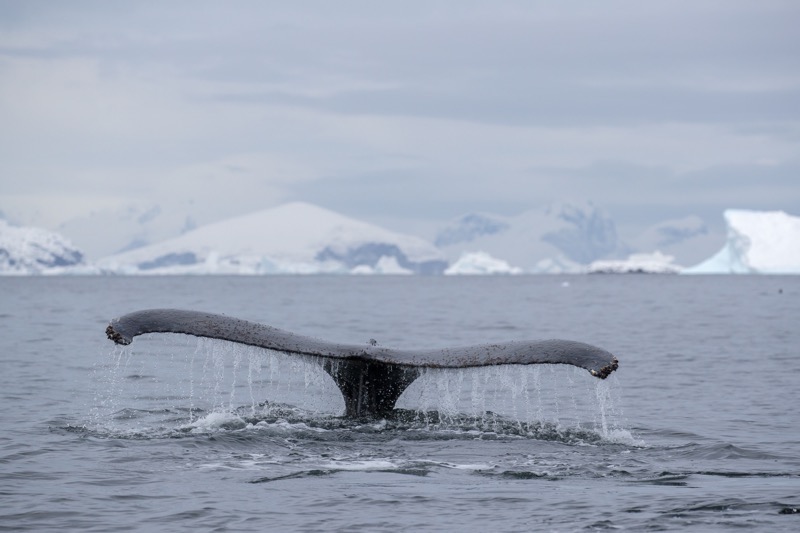 Photo by Ling:
Photo by Ling: Photo
Photo



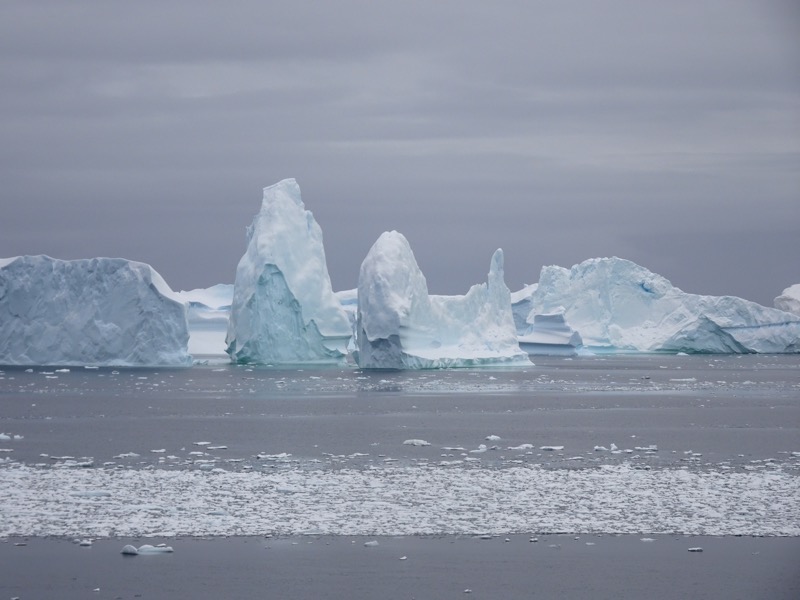
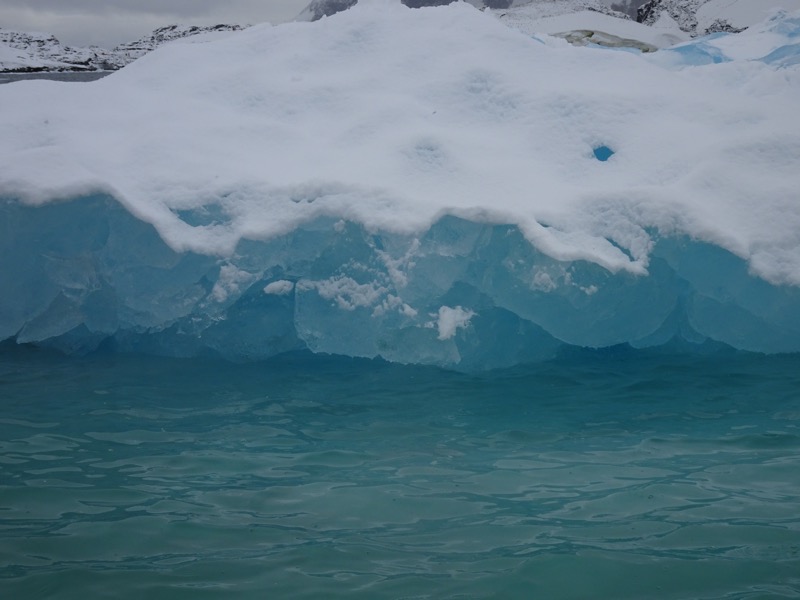
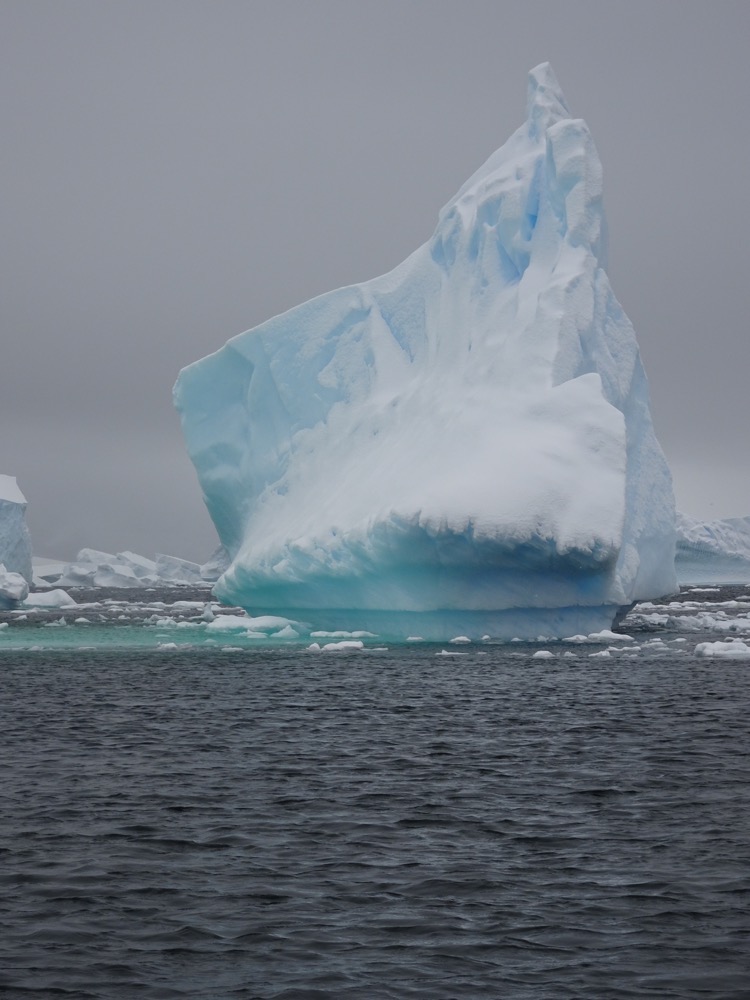
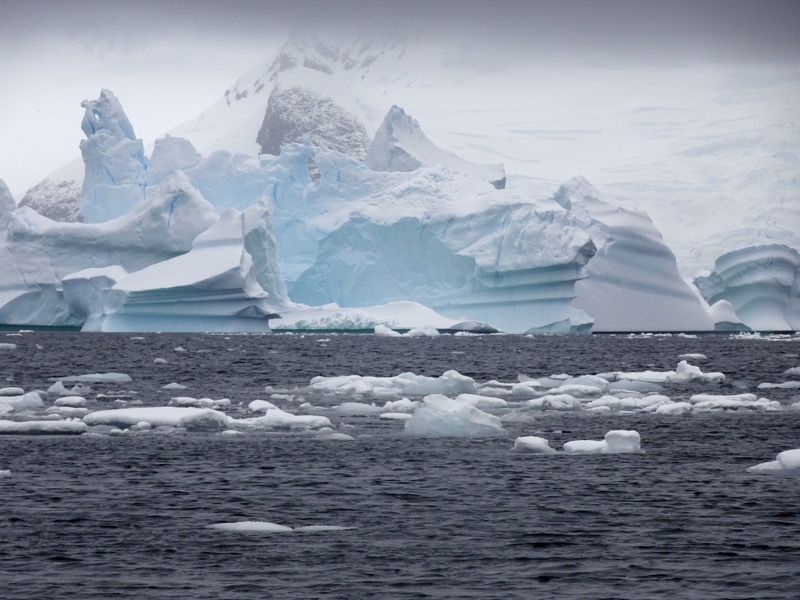 Front of an iceberg that looks like a castle…
Front of an iceberg that looks like a castle…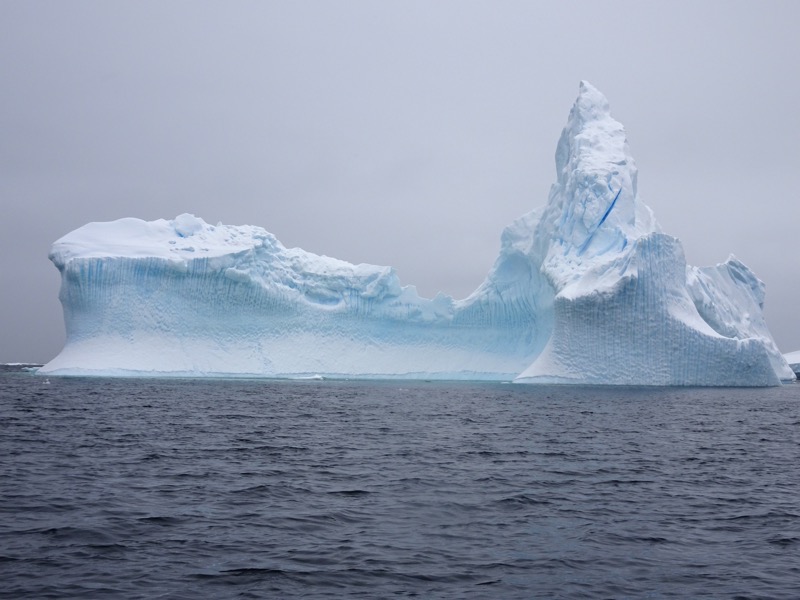 Side view of the same iceberg that looks nothing like a castle anymore!
Side view of the same iceberg that looks nothing like a castle anymore!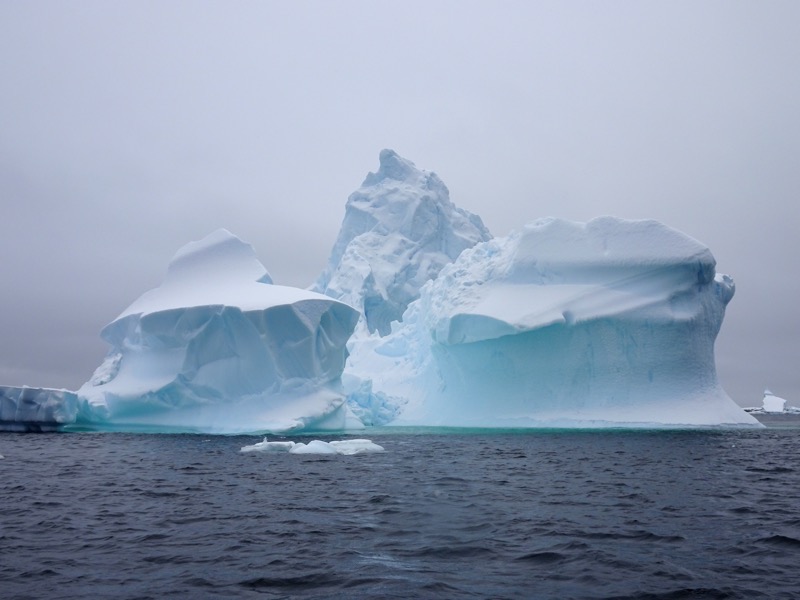
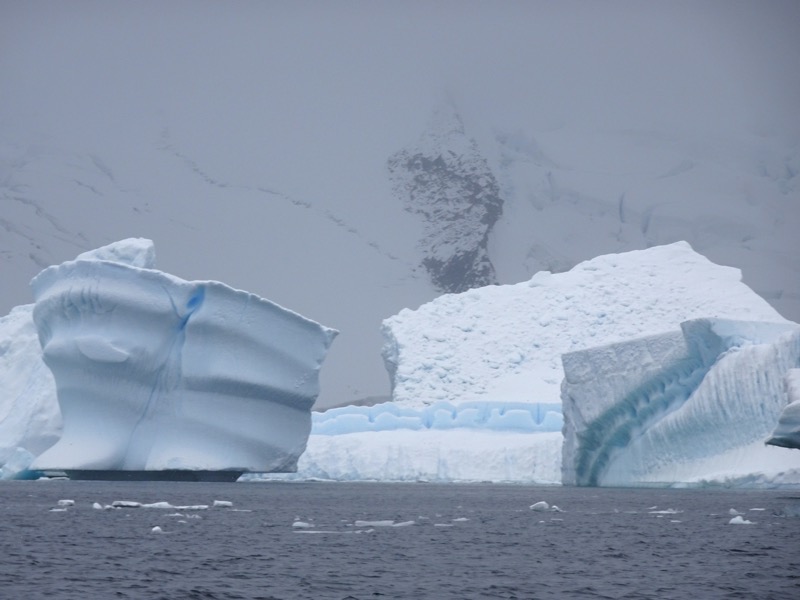
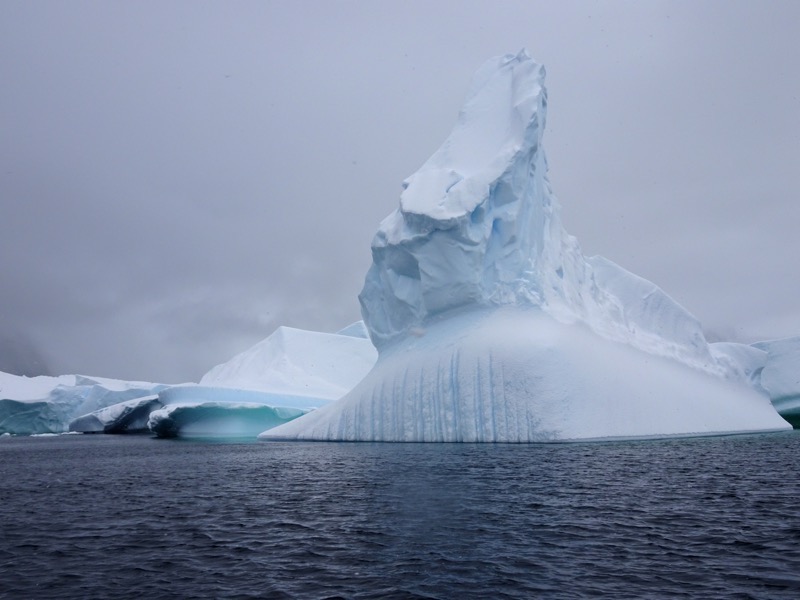

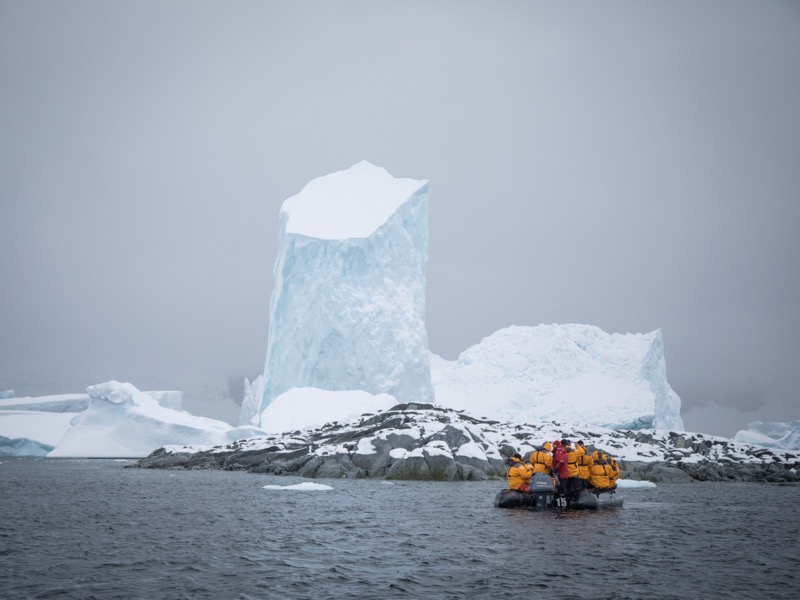

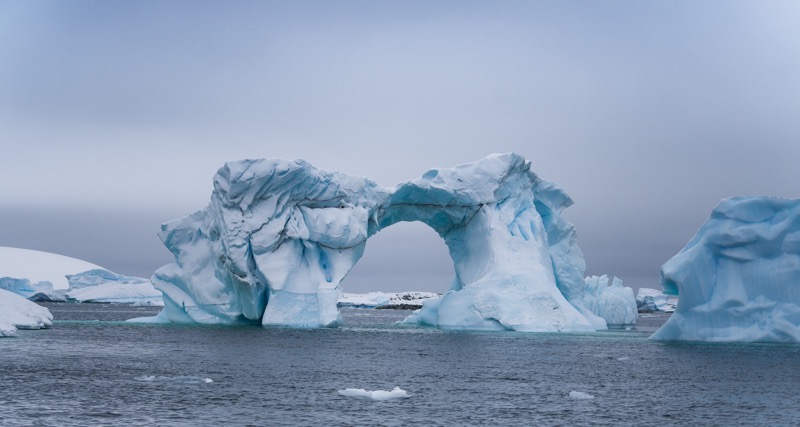
 After our cruise through the ‘sculpture gallery’, we went to Port Charcot to visit with a very cute little Gentoo penguin colony. They were mostly chicks from this year’s breeding season, that were very inquisitive and around their visitors. Penguins have right of way in the Antarctic and we have to work hard to stay out of their way. Best way to see them is to just sit down and wait for them to come and check you out. It was wonderful to take some beautiful photos of these cute little guys with the icebergs and the snow-capped mountains in the background.
After our cruise through the ‘sculpture gallery’, we went to Port Charcot to visit with a very cute little Gentoo penguin colony. They were mostly chicks from this year’s breeding season, that were very inquisitive and around their visitors. Penguins have right of way in the Antarctic and we have to work hard to stay out of their way. Best way to see them is to just sit down and wait for them to come and check you out. It was wonderful to take some beautiful photos of these cute little guys with the icebergs and the snow-capped mountains in the background.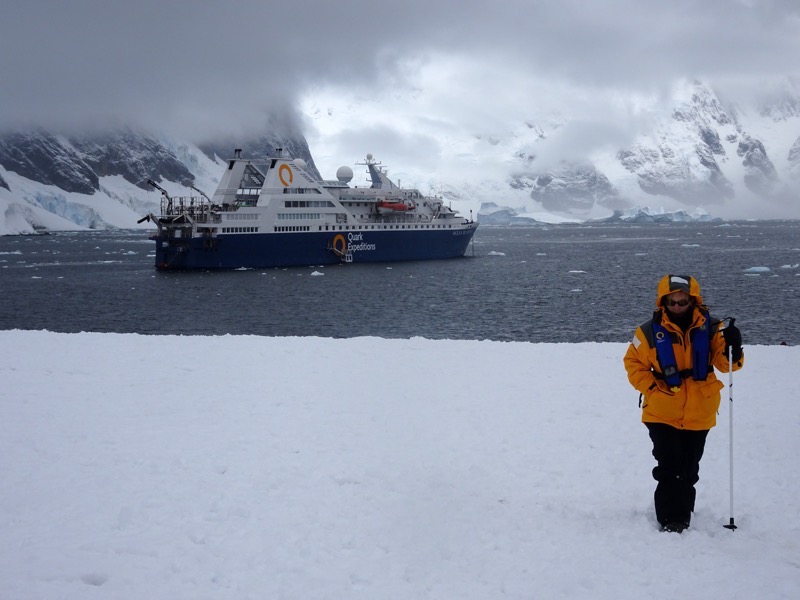

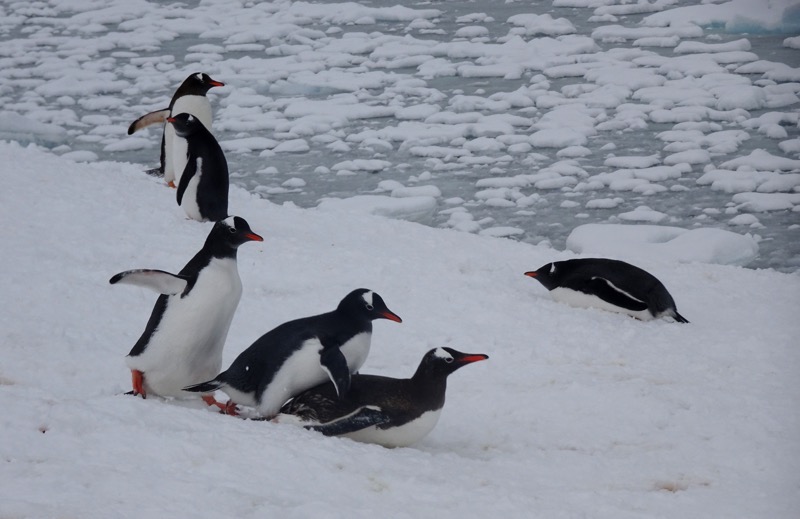 Photo by Scotty:
Photo by Scotty:
 Photo by Linda:
Photo by Linda: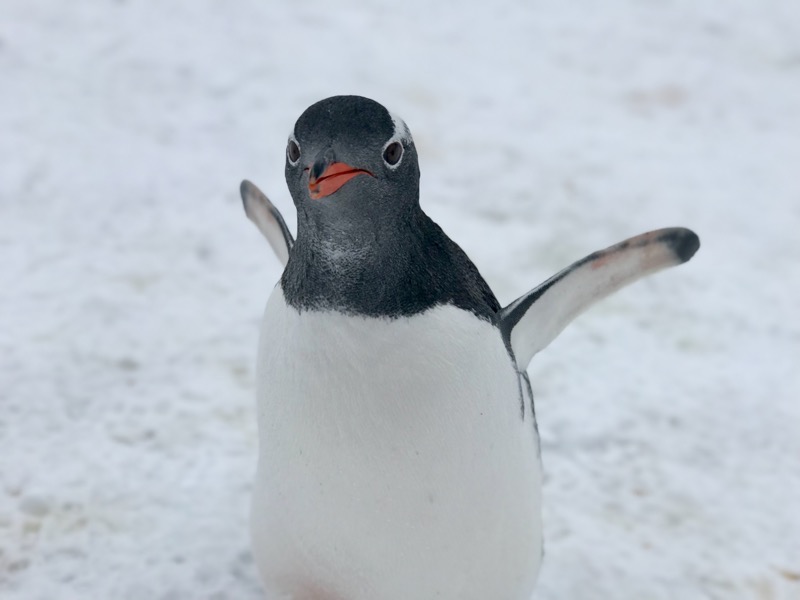
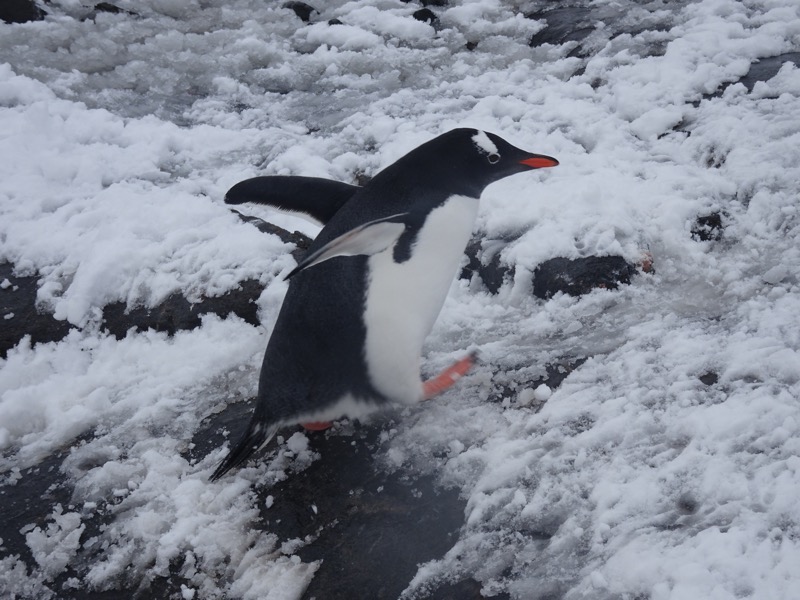
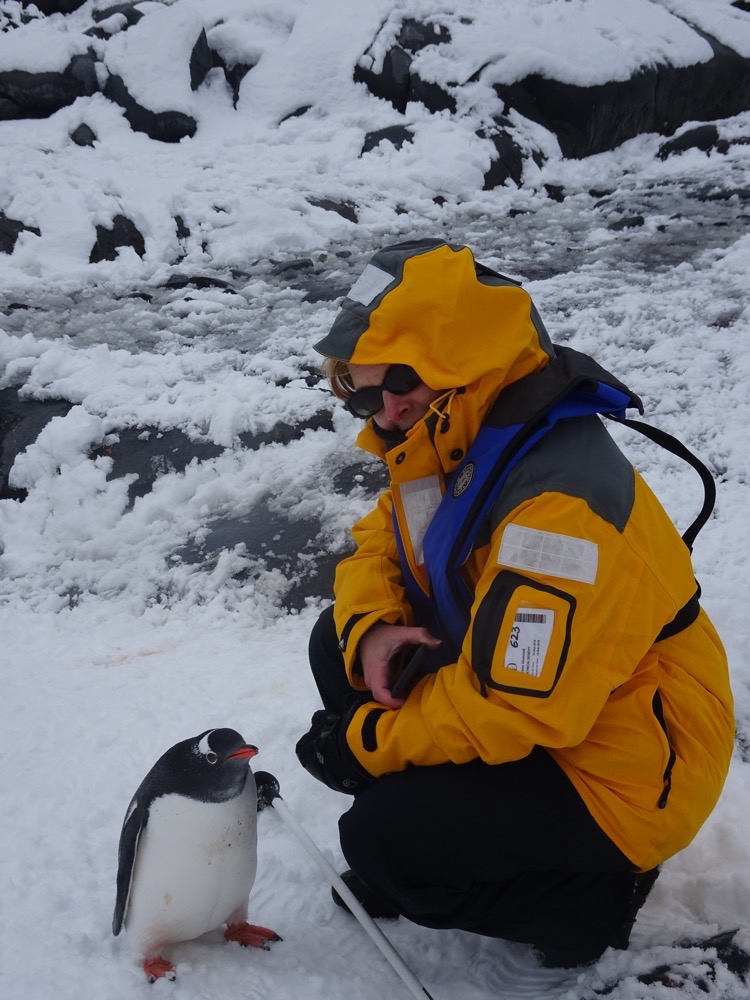
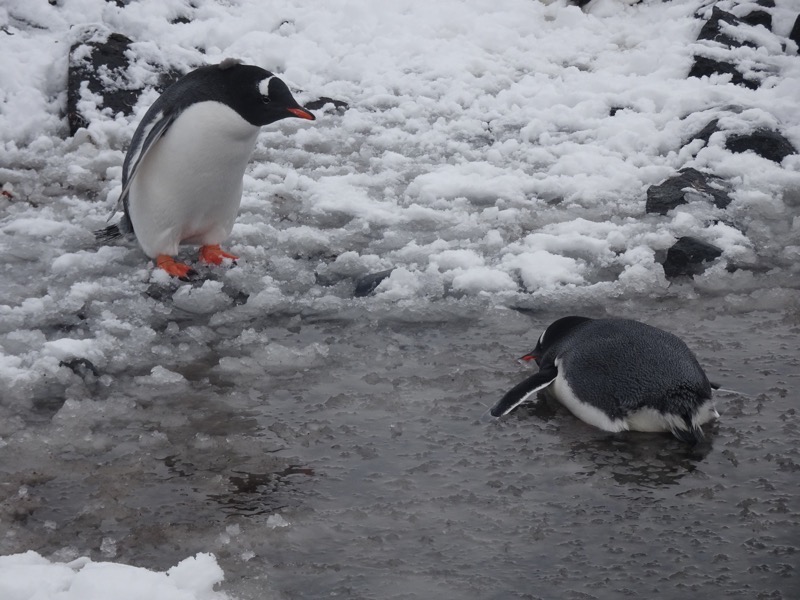
 Photo by Acacia:
Photo by Acacia:

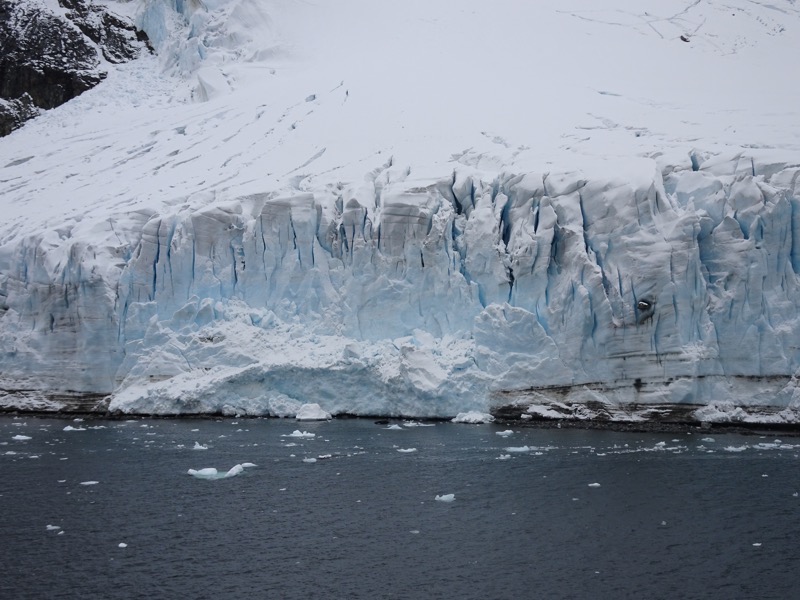
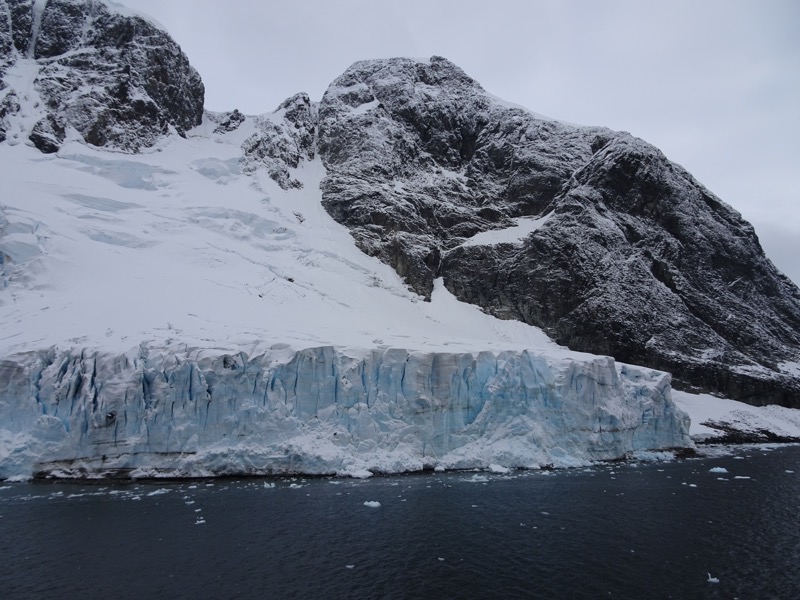
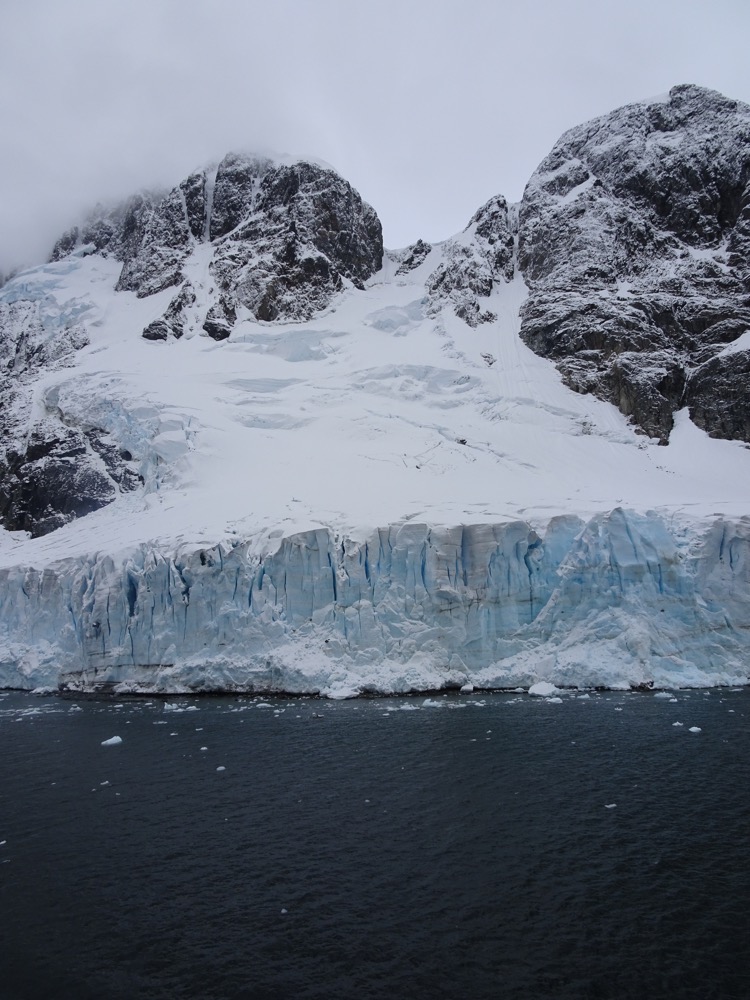
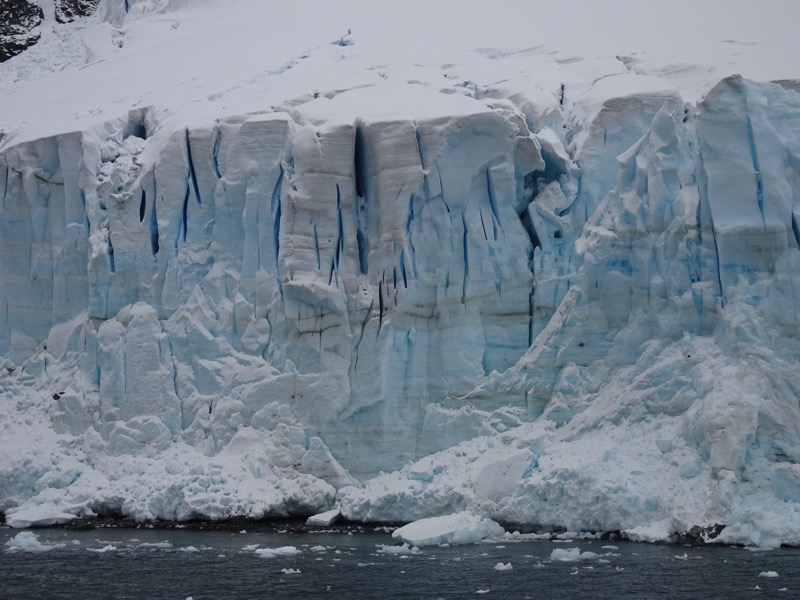
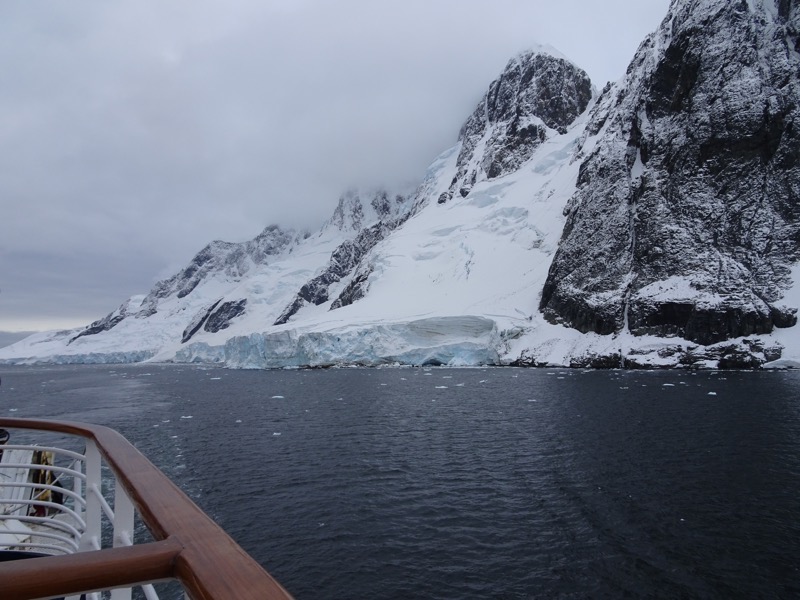
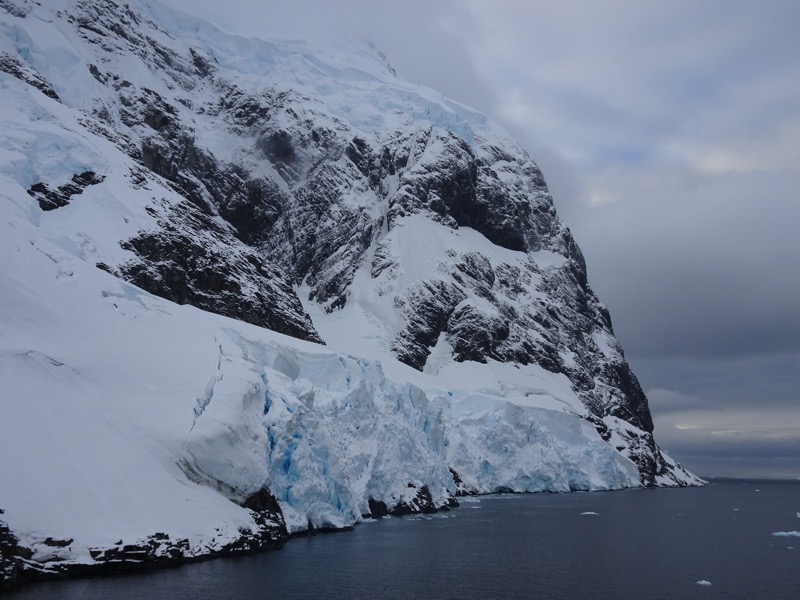
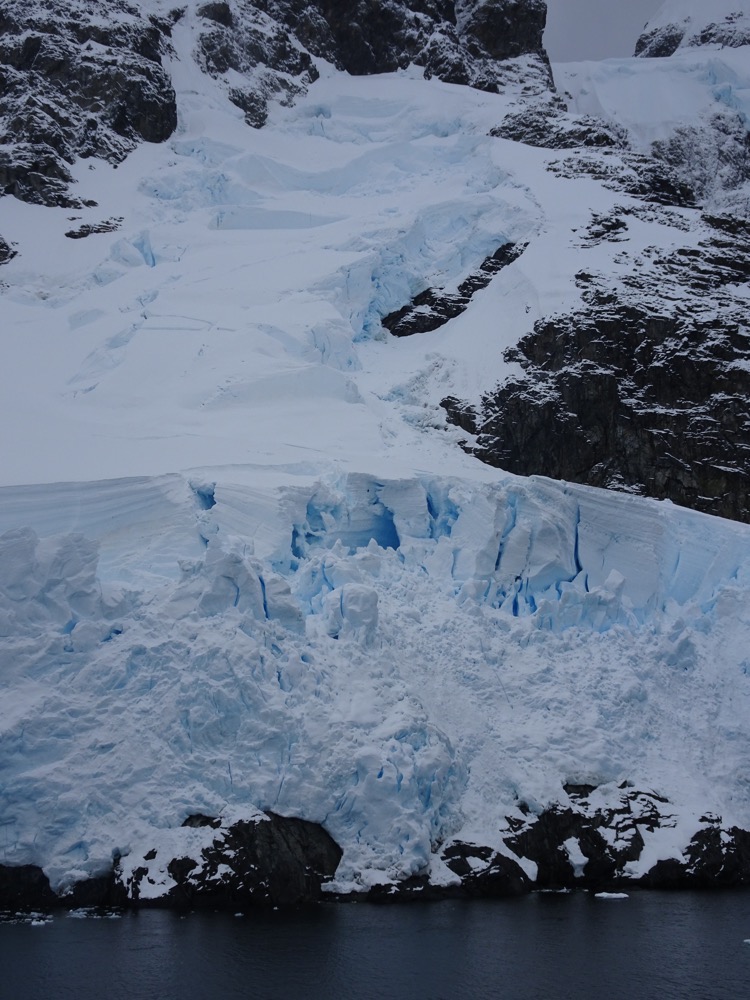


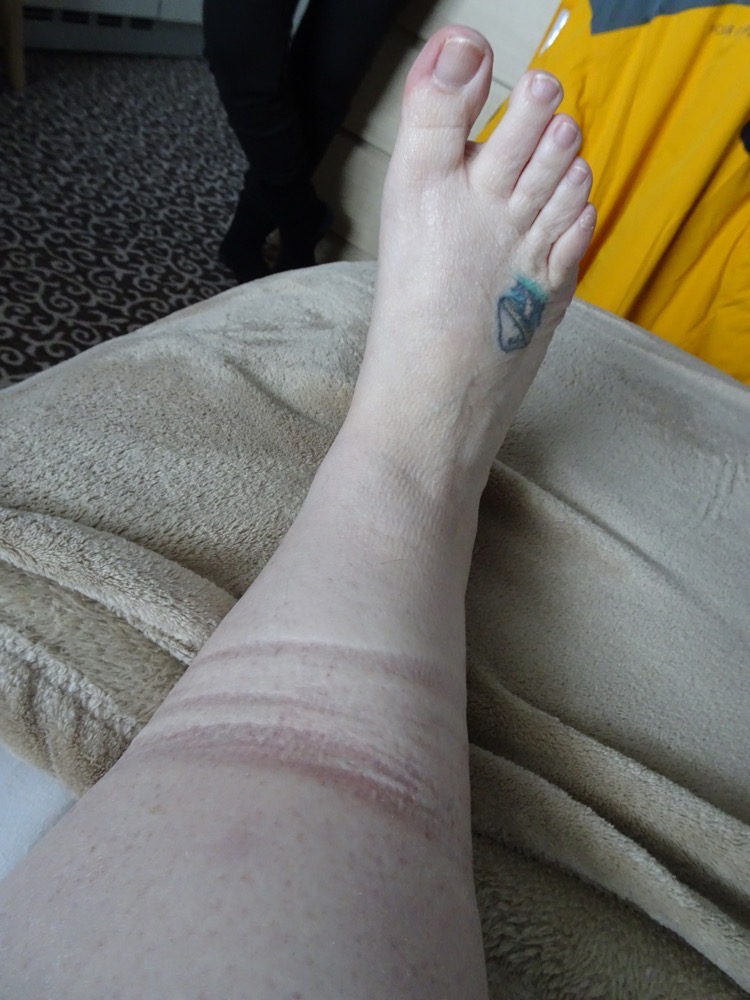 Speaking of those damn Muck boots, I had a huge problem with the ones I was wearing yesterday in the form of them nearly cutting off the circulation to my feet. I mentioned when I picked them up that having tiny feet and not having skinny chicken legs is not exactly compatible with trying to wear boy’s sized boots and this was the result – rather unpleasant and painfully bruised shins from just one outing. I had to go back to Flipper (equipment logistics dude) to try and sort something out. They really have NO ladies boots on the ship and my only option was to go up another size to a men’s 6 – now two sizes too big for my tiny feet! – and put a couple of inner soles in the boots and wear thick socks and hope for the best! Only now I really do feel like I’m wearing clown shoes, my feet are slipping around inside the boots a lot, let alone slipping about outside on ice and rocks. I also lost all confidence in my ability to even navigate the stairs up and down to the gangway because I feel like I am walking around in yale’s shoes! Not ideal – had I known this was going to become such an issue I would have looked at buying suitable boots, hang the expense. :/ Nothing to be done though, but soldier on (very fucking carefully and slowly!) and hope I don’t take a tumble down a flight of stairs ruining the rest of the trip…
Speaking of those damn Muck boots, I had a huge problem with the ones I was wearing yesterday in the form of them nearly cutting off the circulation to my feet. I mentioned when I picked them up that having tiny feet and not having skinny chicken legs is not exactly compatible with trying to wear boy’s sized boots and this was the result – rather unpleasant and painfully bruised shins from just one outing. I had to go back to Flipper (equipment logistics dude) to try and sort something out. They really have NO ladies boots on the ship and my only option was to go up another size to a men’s 6 – now two sizes too big for my tiny feet! – and put a couple of inner soles in the boots and wear thick socks and hope for the best! Only now I really do feel like I’m wearing clown shoes, my feet are slipping around inside the boots a lot, let alone slipping about outside on ice and rocks. I also lost all confidence in my ability to even navigate the stairs up and down to the gangway because I feel like I am walking around in yale’s shoes! Not ideal – had I known this was going to become such an issue I would have looked at buying suitable boots, hang the expense. :/ Nothing to be done though, but soldier on (very fucking carefully and slowly!) and hope I don’t take a tumble down a flight of stairs ruining the rest of the trip…
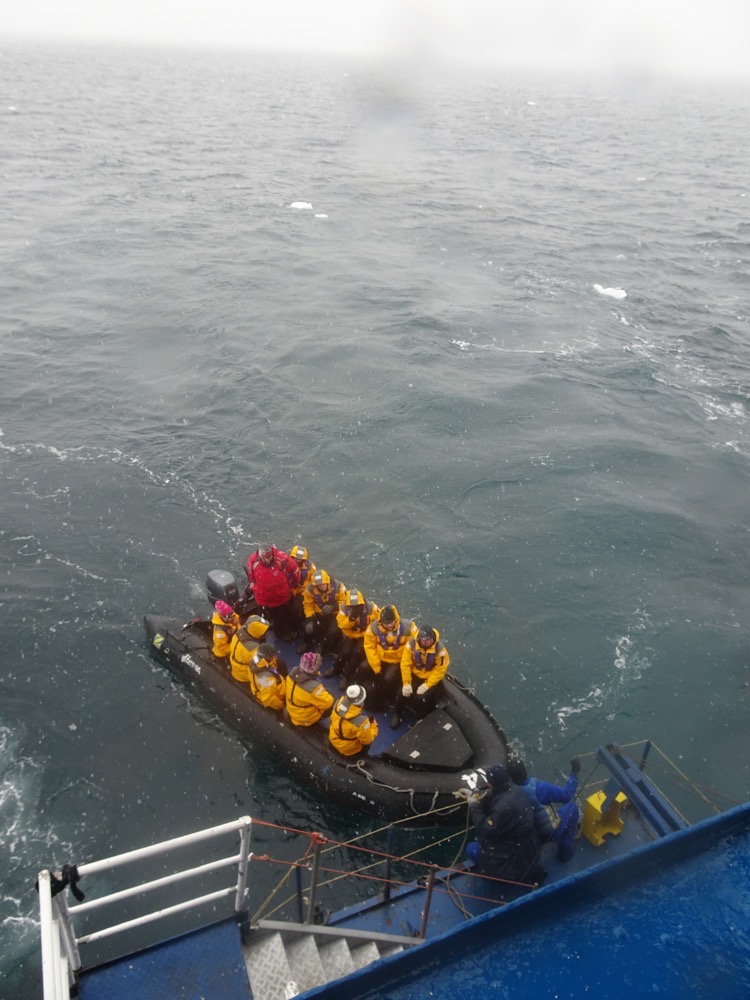
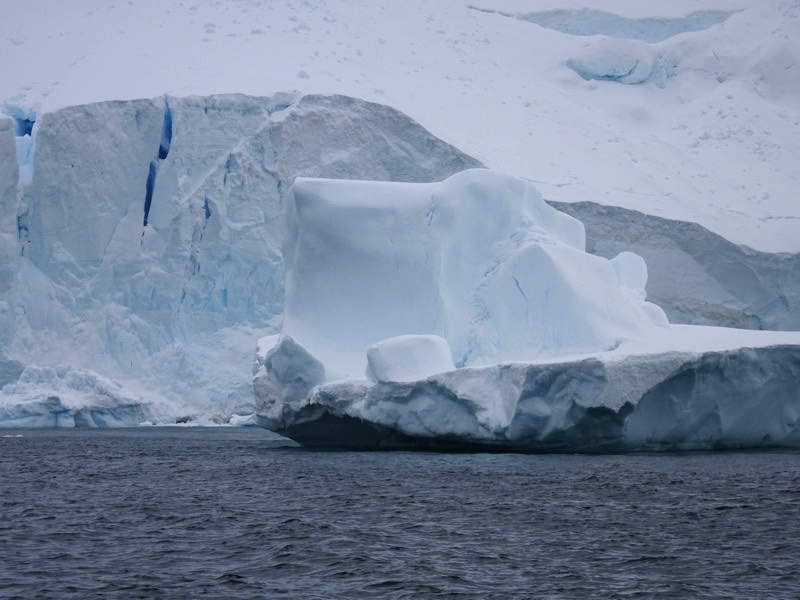
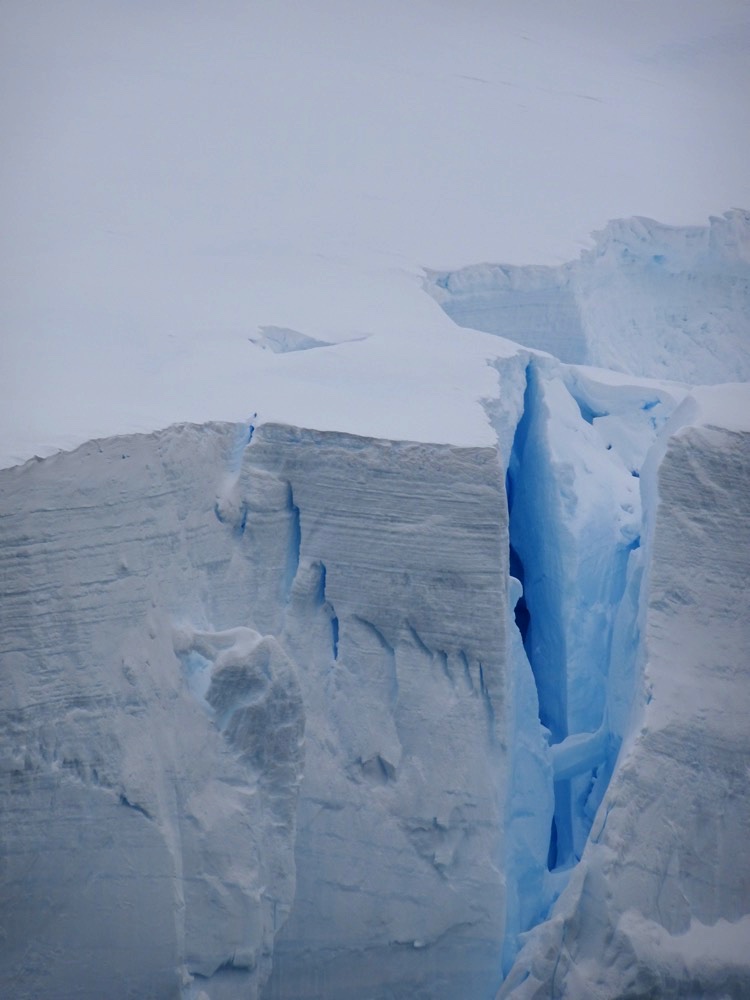
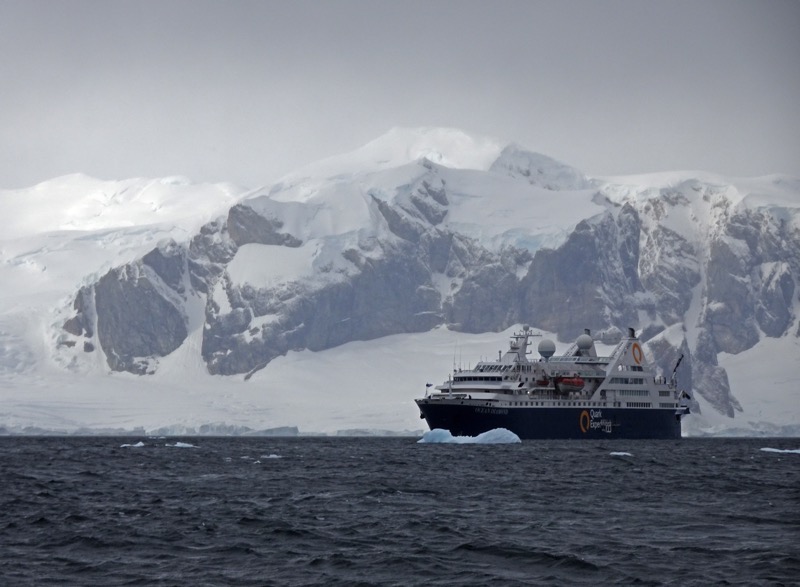
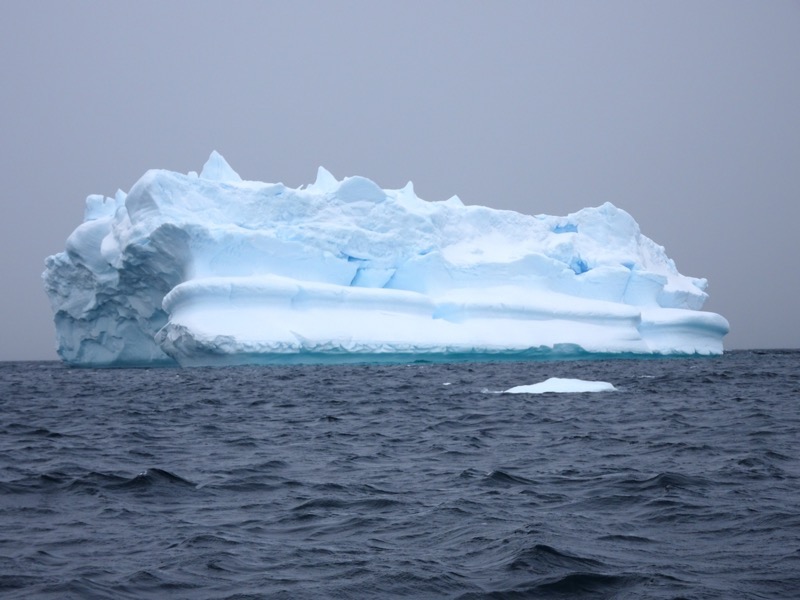
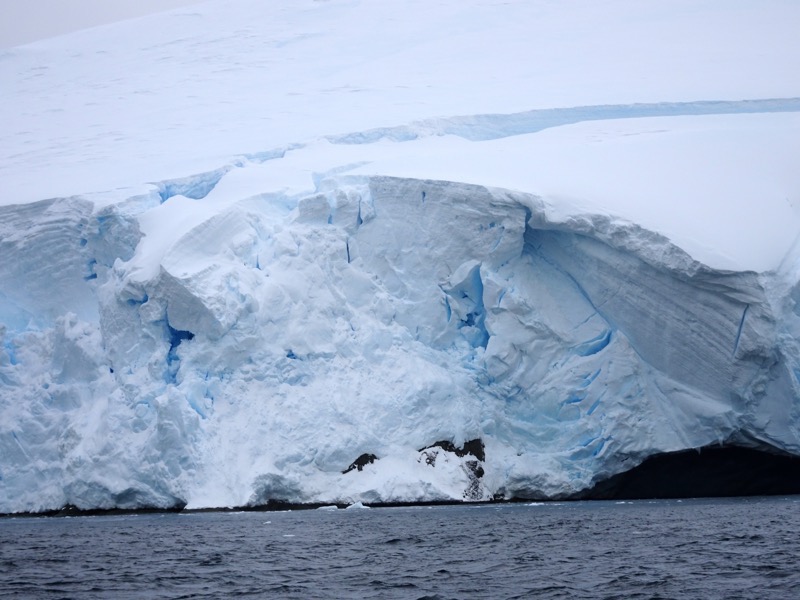 Penguin photos: Scotty
Penguin photos: Scotty

 We were many kilometres away from the iceberg pictured below – I would estimate that the portion we can see above water it is possibly as much as four times the size of Carindale Westfield shopping centre. The scale of everything we are seeing here is truly hard to wrap your head around – size and distance are very difficult to judge without trees, people or animals providing scale.
We were many kilometres away from the iceberg pictured below – I would estimate that the portion we can see above water it is possibly as much as four times the size of Carindale Westfield shopping centre. The scale of everything we are seeing here is truly hard to wrap your head around – size and distance are very difficult to judge without trees, people or animals providing scale.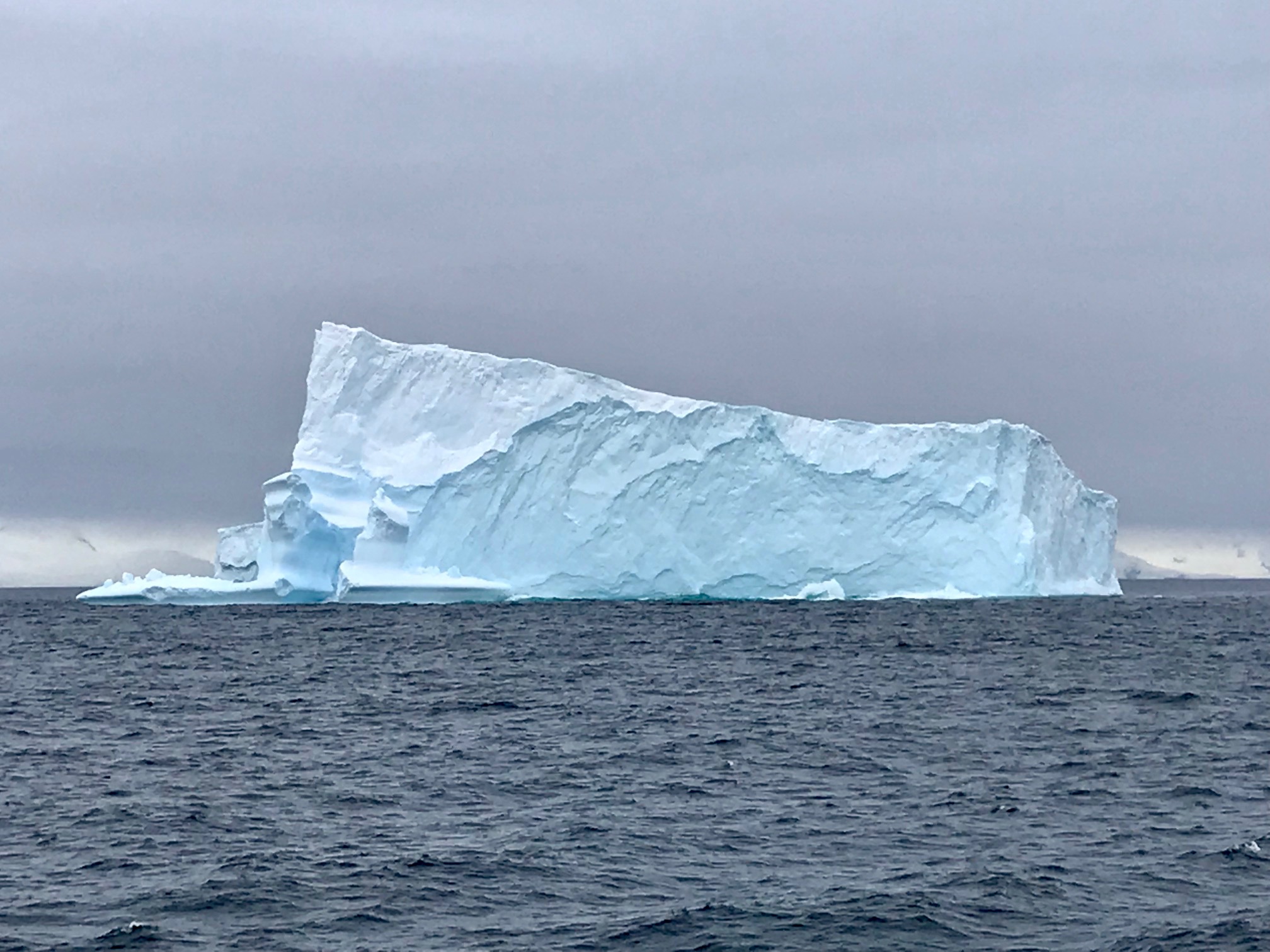 Photo: Rex
Photo: Rex
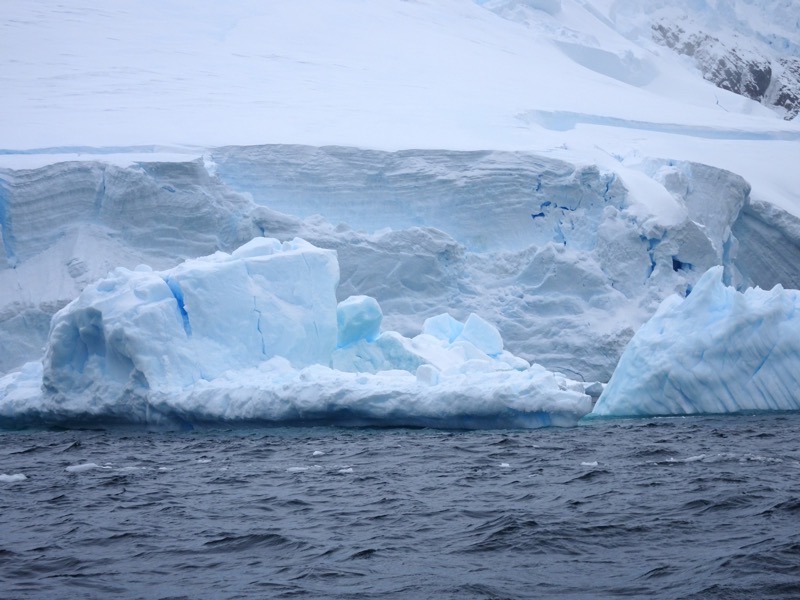
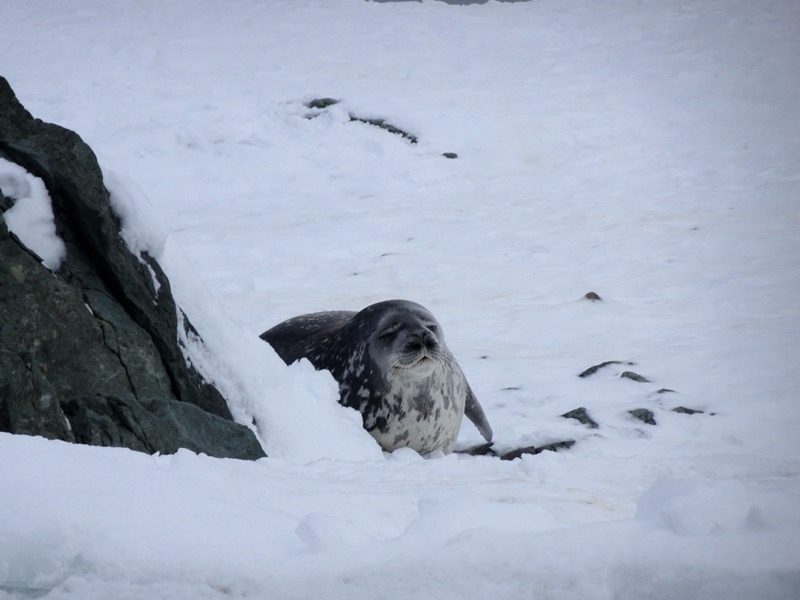
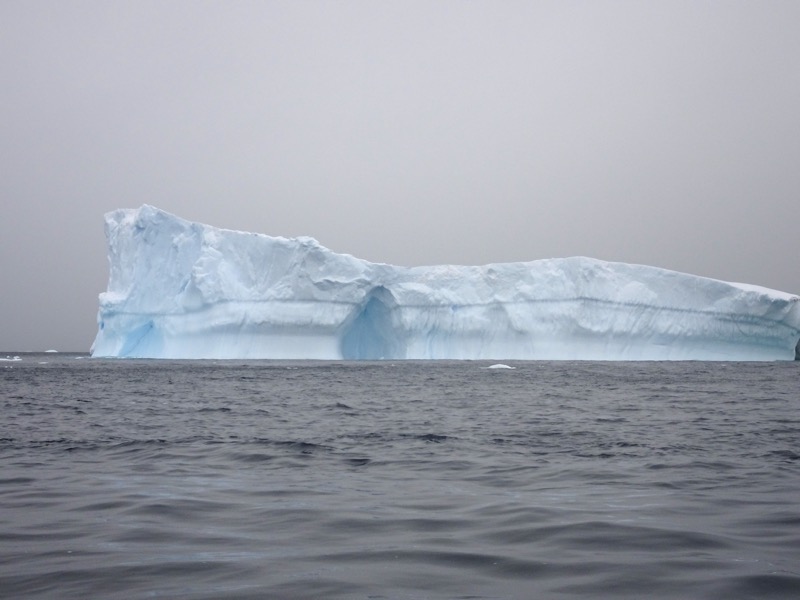
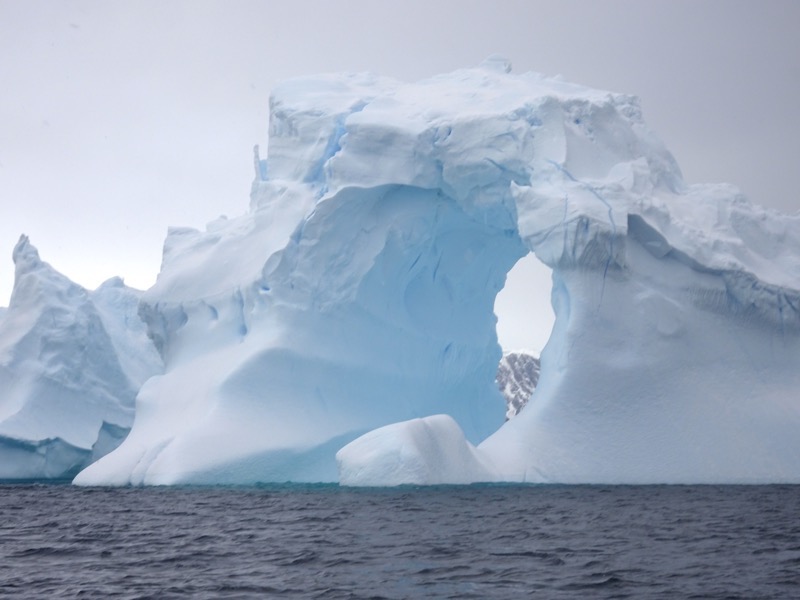
 One of Barry’s photos of this same iceberg with a zodiac in it for scale… note though, that the zodiacs are required to remain a minimum of 200m away or twice the estimated height of the iceberg (whichever is greater) for safety purposes in the event of ice calving – so you can imagine how tiny the little boat would look if it were actually anywhere near close to the base of this gigantic iceberg.
One of Barry’s photos of this same iceberg with a zodiac in it for scale… note though, that the zodiacs are required to remain a minimum of 200m away or twice the estimated height of the iceberg (whichever is greater) for safety purposes in the event of ice calving – so you can imagine how tiny the little boat would look if it were actually anywhere near close to the base of this gigantic iceberg.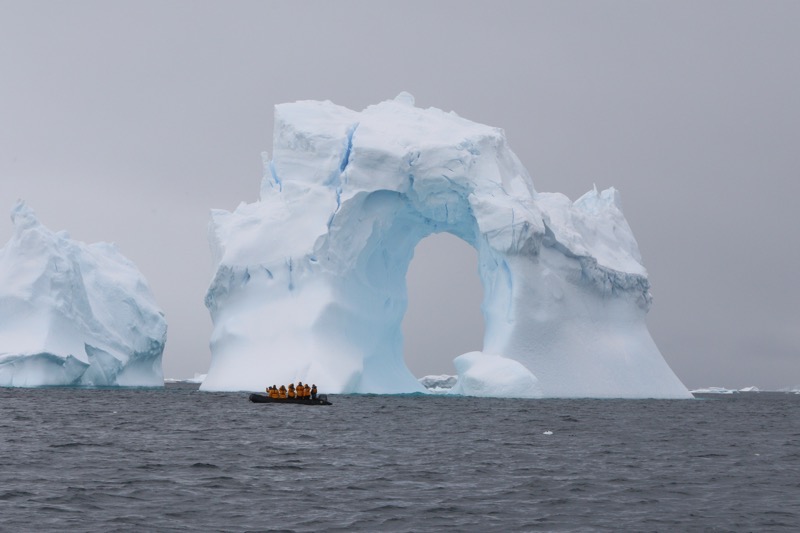 Photo: Linda
Photo: Linda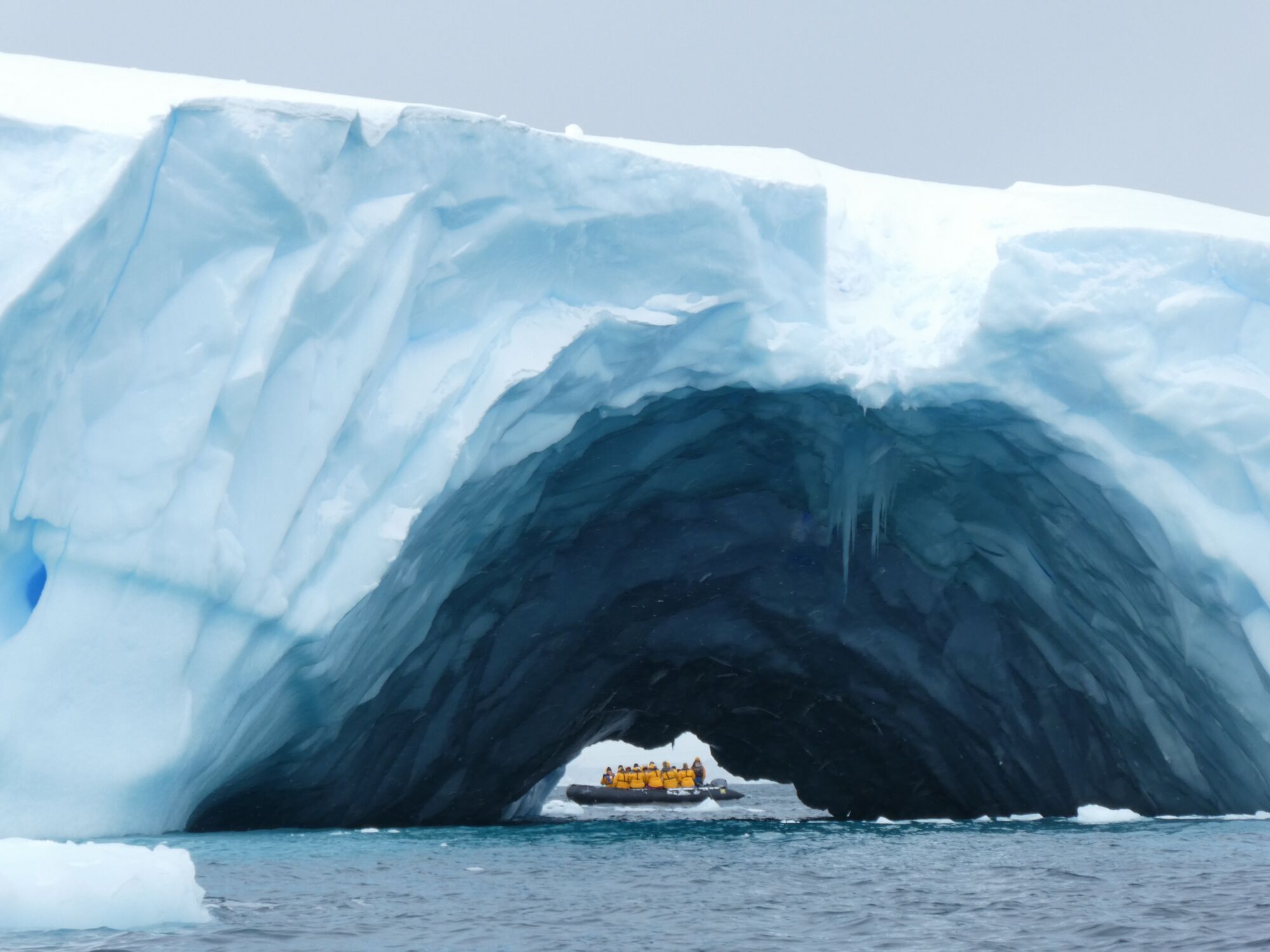 These photos are of Andersen Island and Crystal Bay, so named for all the scientists that studied ice crystals here in the 1960s.
These photos are of Andersen Island and Crystal Bay, so named for all the scientists that studied ice crystals here in the 1960s. Adrien de GERLACHE was born in Hasselt in Belgium, he had applied to be part of Neils’ NE passage expedition, but unfortunately, Neils died before he could complete his plans. Gerlache then decided to raise funds to do an exploration of his own. There was no national funding available at this time, as Belgium was engaged in expending resources in the Belgium Congo but Gerlache managed to get himself a sailing vessel in 1896, the Belgica (previously named the Patrica) with an auxiliary engine with a whopping 150hp motor.
Adrien de GERLACHE was born in Hasselt in Belgium, he had applied to be part of Neils’ NE passage expedition, but unfortunately, Neils died before he could complete his plans. Gerlache then decided to raise funds to do an exploration of his own. There was no national funding available at this time, as Belgium was engaged in expending resources in the Belgium Congo but Gerlache managed to get himself a sailing vessel in 1896, the Belgica (previously named the Patrica) with an auxiliary engine with a whopping 150hp motor.
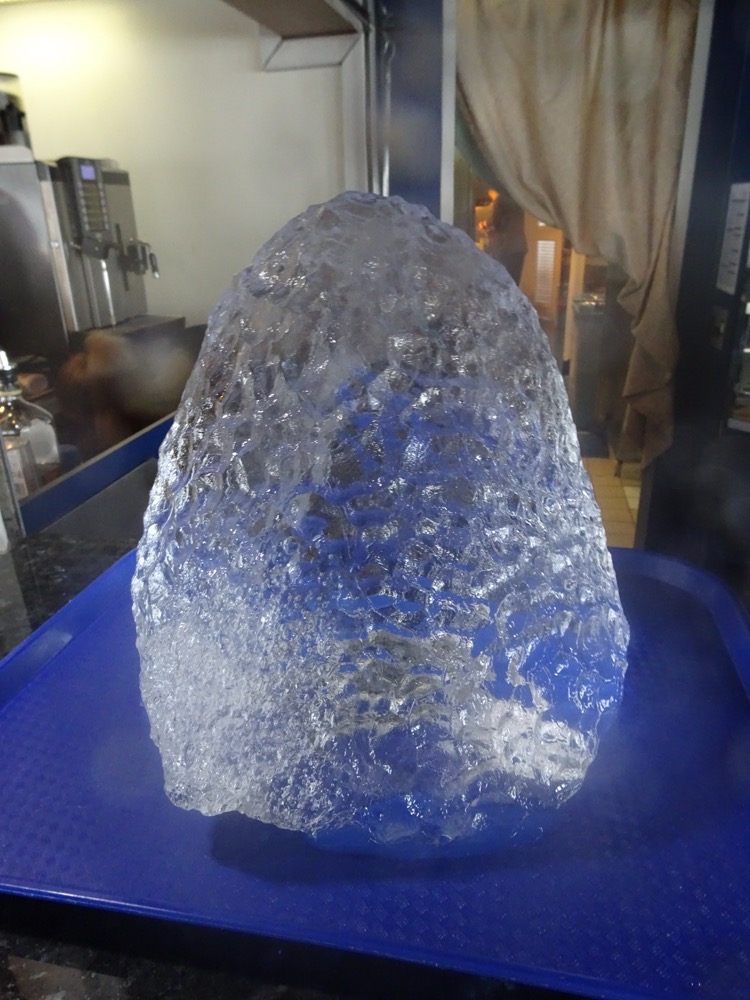

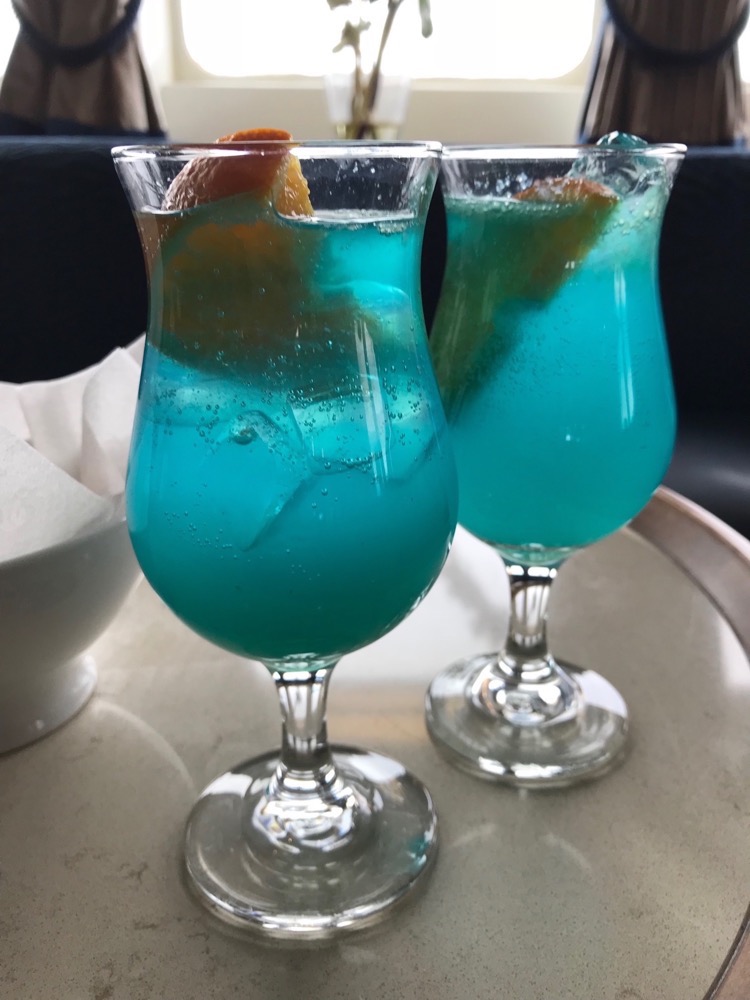 After cocktails and whatnot, we had our daily recap/debrief which was now seems to habitually be about letting us know where we hadn’t stuck to the program today, what the program is for tomorrow, and how to expect that are unlikely to stick to the program tomorrow either! We also have a general chat about the things we have seen today and other ship activities.
After cocktails and whatnot, we had our daily recap/debrief which was now seems to habitually be about letting us know where we hadn’t stuck to the program today, what the program is for tomorrow, and how to expect that are unlikely to stick to the program tomorrow either! We also have a general chat about the things we have seen today and other ship activities.